#tl;dr i’m FINE except when i’m not but even then i think generally i will be fine
Text
A Lily Gilded: A Review and Analysis of Undertale Yellow

The Short, Spoiler-Free Review (TL;DR)
Any Undertale fan who owns a PC should play Undertale Yellow, even if they previously weren’t interested or have any doubts or reservations.
No criticism that I levy at Undertale Yellow, big or small, is intended to dissuade anyone who hasn’t played it from trying it: you should play it and there is no reason not to aside from a lack of free time or not owning a PC.
Although I have some criticisms of Undertale Yellow, my overall opinion of it is still very positive. I’m glad to have experienced this game.
If you haven’t played the game yet, then I recommend starting with the neutral route. Pacifist is much harder in this game and there are story segments exclusive to the neutral route that make it worth the time investment.
My analysis from this point forward will include spoilers for all three major routes of Undertale Yellow. It will also be very long (close to 60 pages), so be warned.
My Background
I’ve completed all routes of Undertale, Deltarune (Ch 1-2), and Undertale Yellow
I primarily engage with UTDR fandom by reading and writing theories. I like to think that I’m decently knowledgeable about the series, at least
I have no professional background in game development
I’m usually a purist when it comes to games and the topic of fangames and mods. I’m a “picky eater” in particular when it comes to UT/DR fan content:
I’ve never played an Undertale fangame prior to Yellow
Most UT and DR fangames have either not appealed to me personally or have not been finished
I don’t engage with most story-driven Undertale/Deltarune Aus or fanworks if I feel they don’t capture the spirit of the original games
Saying Something Nice
Undertale Yellow is the best fangame that I’ve played in recent memory. I think it’s very likely that Undertale Yellow is not only the best Undertale fangame ever made but that it will remain the best Undertale fangame of its kind for the foreseeable future. It’s not just a good fangame but a good game in general--had Undertale Yellow been a completely original game with no ties to Undertale, it very likely would have become a cult classic in its own right.
Of the long-form fan content I’ve seen, Undertale Yellow is among those that come the closest to replicating the style and tone of the original game without feeling like it’s simply cribbing the story or jokes.
It goes without saying that Undertale Yellow’s spritework and animations far surpass those of Undertale in sheer effort, and at times they rival and surpass those of Deltarune as well. There are some stylistic differences between Yellow and the canon games, and I wouldn’t go so far as to say Yellow’s visuals are always better in every conceivable aspect, but the general quality difference is night and day.
Yellow’s music comes close to rivaling Toby’s work, though frankly I think this is a barrier that no fangame will ever overcome for me. It’s a better impression of Toby’s style than most who’ve tried, but it’s still noticeably an impression. One thing that I immensely appreciate is that Yellow has battle theme variants for each major area in the game. “Enemy Approaching” is a fine song, but I always start to get sick of it by the time I reach the end of Waterfall in the original game.
Most of all, what I respect about Undertale Yellow is when it shows restraint: the restraint to largely omit cameos and callbacks to Undertale’s characters except when it feels warranted to do so. I respect that the game doesn’t try to smuggle in characters or worldbuilding elements from Deltarune and instead sticks to its guns as an Undertale prequel. I also appreciate that, for the most part, it sidesteps the trap that most prequels fall into of trying to tell a bigger story than the original—the story of Undertale Yellow still feels impactful and meaningful, but it does not overshadow or diminish the events of Undertale.
I wanted to frontload my praises for this game because a lot of my more detailed analyses to follow will come across more negative and nitpicky. Admittedly, it’s much easier to point out something that doesn’t work in a story or game that’s otherwise good because it sticks out like a sore thumb and takes you out of the experience. Additionally, so many things are done well in this game that I’d be here all day if I listed every single thing that worked. If there’s an aspect of the game that I don’t comment on then just assume that I found it at least serviceable, if not great.
My Criteria
Since Undertale Yellow is based on the world of Undertale and borrows many gameplay elements from it, it’s virtually impossible to review or analyze the game without inviting at least some comparisons to Undertale.
Having said that, I’m going to avoid criticizing differences between Yellow and the original game if the criticism would boil down to “it’s different from Undertale, therefore it’s bad.” There are things that Yellow does differently that I find worse, but I’ll argue those on their own merit rather than pointing solely to the fact that they’re different. On the flip side, there are a few places where Yellow differs from the original game because Yellow does something better—I’ll be sure to point out these instances as well.
Overall, I’m grading Undertale Yellow on a curve because I can’t help but compare it to the original game. I don’t feel it’s unfair for me to do so, since Yellow relies on Undertale not only for its conceit but also for some of its story beats—Yellow would not make sense or feel complete as an experience if Undertale did not exist.
If Undertale Yellow had been a completely original game, with whatever tweaks or rewrites would have been necessary to make it such, my overall tone would probably be more positive, since I’d be comparing it to the average game experience rather than to one of my favorite games of all time. This is not to say that Yellow would have necessarily been better as an original game, nor am I saying that it should have been—it just would have made the comparisons to Undertale less warranted.
Lastly, I’m going to try to avoid comparing Undertale Yellow to Deltarune. I feel like this is a less fair comparison since Deltarune is not a finished game and Yellow lifts very little from Deltarune beyond a run button and the charge shot.
Bosses
Undertale Yellow’s bosses were the most contentious issue for me during my initial playthroughs. Subsequent playthroughs caused me to warm up a bit to some of the problematic ones, but most of my gameplay-related gripes are tied to its bosses.
My three biggest issues with this game’s bosses are the strategies for sparing bosses, the telegraphing of their attacks, and the attack variety that each boss has.
Sparing Strategies
To start with the simpler complaint, half the bosses and minibosses in this game have pacifist fights that consist of waiting for the boss’s dialogue and attacks to run out before you can spare them, sometimes requiring a token act only at the very end of the fight.
This is a problem because it reduces these fights to waiting games that can be brute-forced with a full supply of healing items. Annoyingly, these same fights also come with 2-3 options in the ACT menu that often do nothing and in most cases don’t even prompt any reaction or different dialogue from the boss.
By comparison, Undertale’s pacifist route only has two (and a half) bosses that require waiting out the opponent: Papyrus and Muffet, and both of these fights have alternate completion conditions that can be used to bypass the wait.

Conversely, Napstablook’s fight requires acting, Toriel requires constant sparing, the Snowdin dogs all have unique acts, Mad Dummy requires redirecting her attacks back at her, Undyne requires running away, the Royal Guards require acting, Mettaton must pass a ratings threshold tied to unique acts, Asgore and Flowey require fighting; Asriel’s fight is half waiting but the second phase requires the lost soul segments to be completed.
Every Undertale boss felt like a puzzle on pacifist and some like Undyne and Mad Dummy were genuine brain-teasers. None of Yellow’s fights ever quite scratch that itch, though a couple come close like Guardener and Axis.
It baffles me a little that this issue is even present because the common enemy encounters in Yellow don’t fall prey to this. In fact, a few enemy encounters in Yellow cleverly require using multiple different acts in a specific (and usually intuitive) order to achieve victory—something that even Undertale seldom did.
It seems that most bosses in Yellow were designed around distinguishing themselves via their attack patterns rather than their spare method, though this leads into anther major issue: how these attacks are conveyed, paced, and telegraphed to the player.
Attack Telegraphing
Undertale Yellow is meant to have harder combat than Undertale, which had me a bit wary going in. The average enemy encounter in Yellow feels harder than Undertale, and the same is certainly true of the bosses. However, I’m not sure if I’d say any of Yellow’s hardest bosses quite rival the Sans fight in terms of sheer difficulty, at least in terms of the number of attempts it took me to complete them.
This could be chalked up to me coming into Undertale Yellow with more experience than when I first played Undertale, or Yellow’s 1.1 patch toning down a few of the harder fights. For the record, I’ve beaten all fights in Yellow without the use of the game’s “easy mode” option—I used it for certain bosses in my very first pacifist and no mercy runs, but I later replayed those runs with the setting disabled in order to have a “proper” experience.
Many fights in Yellow, big and small, feel less “fair” than the fights in Undertale and even now I’m not 100% sure I can nail down why. A lot of this boils down to the “feel” of the fights, but part of this could be due to me already being familiar with Undertale’s attack patterns and not Yellow’s. OG Undertale does have a handful of battle moments that feel “unfair” or not designed as optimally for new players as they could have been, which is easy for a player like me to gloss over after I’ve become familiar with the game. One such example is the Lemon Bread amalgamate, which (imo) is one of the hardest fights in the pacifist route.
Still, I noticed many instances in Yellow where incoming attacks would give little or seemingly no warning before they were able to hurt you. Some examples off the top of my head would be Mooch’s moneybag attack, Guardener’s triple stomp attack that fills the whole box, Starlo’s horseshoe attack that blends into his head before it drops, and Ceroba’s paralyzing diamond attack.

The only consistent way I found to avoid attacks like these was either to know in advance where they were going to enter the bullet box or to already be moving before they appear. It doesn’t help that often attacks that come from outside the bullet box will spawn in immediately outside the box, minimizing the travel time where players could see them coming and act accordingly.
Another common issue I found is the frequent use of blue and orange attacks, often paired with each other and/or with regular attacks, and often without properly telegraphing which will be used until they’re already onscreen. In contrast, Undertale generally used these types of attacks one at a time or, in Asgore’s case, clearly telegraphed them before they were used in tandem.
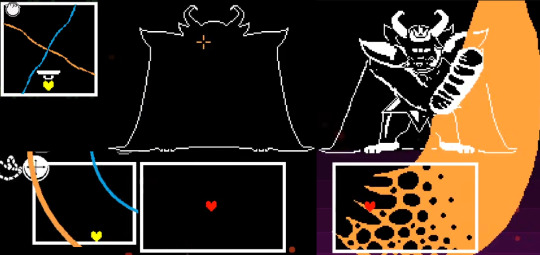
Yellow’s approach presents a problem because dodging orange and blue attacks demands either movement or lack of movement, which can force the player to take a hit if there’s already another attack onscreen that demands the opposite. In my experience the solution was either to know in advance where the blue and orange attacks would come from (and when) to get into optimal position, or simply tank the hit and hope you make up for it later.
Speaking from my own personal experience, I struggled for a time with Ceroba’s No Mercy fight when I went in blind—she has multiple deadly attacks with little to no telegraphing as well as color attacks that can overlap each other if you’re not already in an optimal position. I was only able to complete this fight on normal after I watched a no-hit run so that I could memorize her patterns. This is something I’ve never had to do for any Undertale or Deltarune fight, including Sans, and it doesn’t really feel like it’s in the spirit of the franchise. I always try to go into each of these games blind and I don’t think it’s unreasonable that a new player, even on a harder route, should be able to intuit what is expected of them in a fight. A few attacks might be challenging or counter-intuitive at first, but having to rely on rote memorization or a guide just doesn’t feel fun or organic to me.
On that note, some of you may be nodding toward the Sans fight as an example of some of the things I’m complaining about, particularly the lack of proper telegraphing and a reliance on memorization. Well, let’s unpack that.
To start, I’ll say that the Sans fight is not my favorite fight in Undertale from a pure gameplay perspective and that I don’t fully agree with some of its design choices. One reason I don’t play fan battles in general is because many of them seem to emulate the style of the Sans fight or double down on it without understanding it.
Despite my minor issues with it, I find the “unfair” aspects of the Sans fight to be more justified and acceptable within the context of Undertale than I find the seeming “unfairness” of Yellow’s harder fights to be in the context of that game. One reason is that the Sans fight is the only fight in Undertale (or Deltarune) that works the way that it does, whereas Yellow has several, even if they’re overall less hard than the Sans fight.
More importantly, the Sans fight has proper buildup, feels appropriate for the character and story, and (most important of all) the game itself acknowledges the fact that it’s unfair and the fight is designed around that admission. Sans literally has over a dozen different dialogue variations depending on how many times you die in his fight and when.

The game is even aware of the fact that most new players won’t survive Sans’ first attack and creates multiple variants of just the dialogue before and after that attack. Undertale fully anticipates your deaths and cultivates a unique experience for you along the way as you learn Sans’ patterns.
To put it simply, the Sans fight is the exception that proves the rule: it makes you realize how much fairer the other fights in Undertale are and how easy it is to take those design principles for granted. Conversely, the attack patterns in the hardest Yellow fights didn’t feel radically different or radically “less fair” in philosophy from Yellow’s moderately difficult boss fights—both feel varying degrees of “unfair,” but the harder fights are just “more” with the occasional twist added on top.
My platonic ideal of a challenging boss fight in an Undertale game would be Undyne the Undying. Undyne the Undying is a massive difficulty spike in her respective run, at times she requires ridiculous reaction time, and it’s easy to psych yourself out and get double-tapped by her barrages and die quickly. Nonetheless, her fight feels fair—it’s a culmination of the rules you’ve been taught and it doesn’t needlessly subvert them. Even though she has her dreaded reverse-arrow attacks that trip up new players, these are still properly telegraphed and manageable. Looking at footage of it now, it’s surprising how this fight looks more honest and straightforward than many of Yellow’s later boss fights.
Attack Variety
Another contributing factor to my issues with Yellow’s boss fights is the sheer number and variety of attacks that some bosses have, particularly in the latter half of the game. To wit, most bosses in Undertale have about 4-5 unique attacks that are repeated with variations, while Undertale Yellow’s bosses can have upwards of 9-10 unique types of attacks, not including variations. Ceroba alone has ten completely different unique attack patterns in just the first phase of her pacifist fight—every single turn is a completely different attack requiring different dodging strategies and none are repeated.
Some may be asking why this is a problem. Isn’t more variety a good thing? This just shows that the Yellow team put more effort in, right? My issue here is that many of these attacks don’t seem to exist for any reason except for the sake of artificial variety and because the devs (presumably) thought they’d be a cool-looking thing to dodge. If you’re confused as to the point I’m trying to make, let’s look at how Undertale utilized its attack patterns with Mettaton EX.
The Mettaton EX fight is a favorite of fans and mine, and one reason I like it so much is for how it uses eclectic and seemingly chaotic attacks to teach the player new mechanics while offering a spare mechanic that relies on strategic thinking to optimize. The fight offers the following types of attacks: moving legs, bombs, boxes, miniature mettatons, gates, a disco ball, and Mettaton’s heart. Not counting the joke/gimmick turns like the essay or break time, this is seven main attack archetypes, each with their own variations and crossover with each other.

Note that all seven of these attack types interact with the fight’s core mechanic: the yellow soul mode. More importantly, each of these attacks teaches the player something about how the soul mode works with no need for an onscreen prompt. Boxes and bombs teach you that there are some attacks you should shoot and some that you should not. The hand gates initially teach you that some bullets are unaffected by your shots, but later you’re given gates with yellow buttons that will open them, teaching you that some targets require precision. The miniature mettatons teach you that some attacks will become a bigger problem for you if you don’t take them out right away. The moving legs teach you that shooting can stop certain attacks from moving and that the timing of your shots is important. The disco ball builds on this lesson, requiring the need to plan your next movements when shooting the ball. The heart serves as the culmination, featuring the bombs and mini-mettatons from before while also giving you a precise moving target to hit repeatedly.
All of Mettaton EX’s attacks tie into a common theme and reinforce one another—learning to dodge and utilize the mechanics of one attack will make you better-equipped to deal with the others. It’s by no means a perfect fight, nor does it teach all of its lessons perfectly—I remember it taking me several attempts to complete and some mechanics like the disco ball and legs didn’t “click” with me immediately, but there’s clear intent behind every attack and it’s remarkable how utilitarian the whole thing is structured, despite its reputation for being one of the game’s longer and more self-indulgent fights.
Let’s bring things back to Ceroba for comparison. Her first phase has 10 unique attacks, only half of which feature mechanics that appear in the later phases: her paralyzing diamonds, her spinning bullets that circle around you, her bells that create colored shockwaves, and the vortex that opens in the center of the arena.

The other attacks are only used once, have little-to-no pattern commonality with each other or with her later attacks, and teach nothing other than how to dodge each of these one-off attacks. At most, a few attacks share a flower motif but move with completely different behaviors (straight line, fanning out, circling, homing in). While this isn’t horrible design, I can’t help but find it a bit wasteful considering what other fights have done with less and how chaotic the later phases of Ceroba’s fight get—something that players could have been eased into by having her first phase present more of her later attacks in a more controlled environment.
In the end, I remember being frustrated with the Ceroba pacifist fight when I first played it. Part of this was due to my own mistake of going past the point of no return without a full stock of items, but the lack of cohesion in the first phase and its lacking relevance to the mechanics of the second phase made it hard for me to “gel” with the gameplay and, as a result of my own frustration and confusion, I had a harder time getting invested in the narrative. I’ve seen some fans label the Ceroba fight the best fight in the series, but I wouldn’t even put it in my top 25, despite the overwhelming effort on display from the developers.
To bring the comparison home, I cried the first time I saw Mettaton say goodbye to his call-in viewers, but not once did I cry during Ceroba’s fight. A flamboyant robot making a single pained expression leaves a bigger impact when his attacks are unintrusive to the experience, and a lovingly-animated grieving fox’s backstory doesn’t hit as hard when I’m distracted by a hodgepodge of visually stunning but incoherent bullet hells. Less is more.
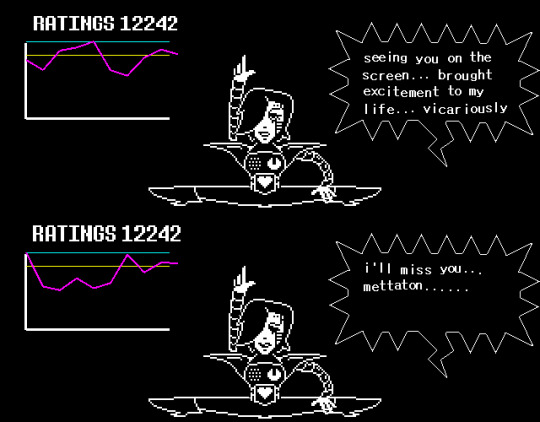
I realize I’ve been a bit mean to Yellow during this segment. In fairness, I did replay the pacifist route and tried the Ceroba fight in a more prepared state. I enjoyed the fight more my second time around, but I still would not rank it among my favorites in the franchise. And to be clear, I don’t hate this fight at all—I just think it represents the excesses in Yellow’s battle design and how they can sour a first-time experience, which is the most important experience for a narrative-driven game. Even the weaker aspects of Yellow’s design are, by and large, serviceable by the standards of typical game design. Compared to Undertale, though, I was disappointed in the areas where it lacked or, more accurately, overstepped.
Having fewer types of attacks is not a result of less effort—it allows more room for variations on each type of attack and it can make difficult or poorly-telegraphed attacks more forgivable if the attack is used multiple times with the first instance training the player for the future variations. I feel that having too many unique attacks for each boss resulted in each attack not receiving the necessary polish and balancing that it should have, and it also made each fight feel less instructive and lacking in a clear design goal.
To close this off, I’d like to give a positive example of a boss fight from Undertale Yellow: Axis. For the most part, Axis successfully walks the tightrope of Yellow’s more complex late-game fights while still maintaining a consistent theme and introducing concepts to the player gradually. The whole fight revolves around blocking Axis’ attacks with a trashcan lid—first with a ground-based lid, then with a lid that rotates around an axis (get it?). As the fight progresses, new types of projectiles and hazards are introduced, usually first using the ground-based lid to avoid overwhelming the player.

As if that weren’t enough, the fight comes with its own unique sparing strategy where players fill a meter by blocking attacks and then attempt to reflect an orb back at Axis once the meter is full. The fight’s not perfect—there’s still the occasional one-off attack that doesn’t really teach any relevant lesson to the player, the orb reflection mechanic is finicky, and the fight is perhaps slightly more difficult than I’d prefer from a typical boss fight, but if all Yellow bosses had been of a similar caliber then I wouldn’t have needed to go on this massive detour about boss design in the first place.
Since some might ask, I might as well weigh in on Yellow’s most controversial boss: El Bailador. I initially had difficulty with this fight due to my lack of experience with rhythm games (and the lack of preparation that the game gives you). I also found the need to press a direction key and the Z key for each note to be a tad clunky. Beyond that? I actually didn’t mind the fight all that much. It introduces a simple concept and builds upon it gradually in a way that felt satisfying to me as I began to master it. The last turn maybe goes on for too long, but I can’t say that I hated it. I promise I’m not trying to piss off the Undertale Yellow fandom (who, if memes are anything to go by, seem to despise this fight), but I found the simplicity of Bailador refreshing considering how chaotic the later fights get. That said, I turned on the auto-rhythm setting in future playthroughs to make this fight less of a difficulty spike.
Themes
To start off, I’d like to acknowledge the fact that Undertale Yellow largely avoids most of the “meta” themes that Undertale and Deltarune touch upon, nor does the game try to go in its own direction in regards to metatextual concepts. Undertale Yellow generally leaves the topic untouched, aside from continuing to use in-universe mechanics established in Undertale such as saving and EXP/LV. Some fans might view this as disappointing or even a betrayal of the tones and themes previously established in Toby’s work. Me? I don’t mind at all, honestly. If anything, it’s refreshing to see an Undertale fan project that takes the setting of Undertale at face value rather than trying to outsmart it or put their own meta spin on it. Far too often have I seen fanworks that swing the pendulum in the other direction and have characters just flat out address the player and shatter the verisimilitude of the setting with no buildup.
None of this is to say that Undertale Yellow is lacking in themes. The most prominent theme I noticed, unsurprisingly, is that of justice. Undertale strongly implies that the yellow human soul is the soul that represents justice, and fanworks ever since have ran with the idea. Undertale Yellow represents the culmination of this concept by turning each of its routes into differing interpretations of what justice means.
As a refresher, Undertale Yellow has three main routes with four endings: true pacifist, “false” pacifist, neutral, and no mercy. I see each ending as its own realization of and commentary on the concept of justice.
Neutral
In Undertale Yellow, the neutral ending acts as something of a “bad ending” from classic video games. These are the kind of endings you get when you fail to 100% complete a game and you’re told to go back and do it again, complete with Flowey’s laugh imposed over the “Thank you for playing!” end credits message.

Who wore it better?
Thematically, the neutral route represents justice as subjective and personal—Clover can spare or kill whoever they wish. It’s hard to argue that any one monster in Undertale Yellow is more guilty than any other in this route, so killing monsters in neutral largely comes off as the capricious whims of Clover rather than being based on any consistent law or greater principle.
This outlook ultimately blows up in Clover’s face when they come to a head with their foil in this route: Flowey, who exercises his own form of justice, or “judgment” as he prefers. Flowey only cares about freeing himself from his current situation and will use any means to achieve this goal. In his eyes, your failure to follow his directions or be of further use of him is a slight against him that demands punishment as he sees fit.
Fitting this individualistic outlook, Flowey takes “might makes right” to its logical conclusion by trapping you in his own personal hell while he acts as a wannabe-God looking down on high. Ultimately Clover can only escape when Flowey wills it, cementing Clover’s status as a pawn subject to the whims of the powerful despite their illusions of independence. Without laws to protect them, the weak will be trampled by the powerful.
Pacifist
Pacifist presents two outlooks depending on whether Clover spares or kills Ceroba in the final battle. Of all the monsters Clover meets, Ceroba is the most culpable for a serious real-world crime other than Asgore and Axis (the latter of whom may not meet the definition of culpability or competence to stand trial).
Clover lacks the fore-knowledge that Ceroba’s daughter will likely survive thanks to Alphys’ efforts, so Clover would view Ceroba’s actions toward Kanako as manslaughter, or at least reckless endangerment. Unlike the neutral route, Clover’s choice can’t solely be chalked up to their own personal whims—actual harm has been done by Ceroba, but more harm may yet be done if she’s killed.
False Pacifist
If Clover kills Ceroba, then this choice seems to represent justice as following the law to the letter, for good or ill. Starlo, who’s most upset by Ceroba’s passing, reluctantly echoes this sentiment:

Even if Clover stands by their choice deep down, it’s reasonable to assume that hurting Starlo this way left a bitter taste in their mouth. Not long after this, Clover reaps what they’ve sewn as they come face to face with their foil for this ending: Asgore.
Initially I thought it was strange that Asgore doesn’t appear if you spare Ceroba, but this ending illustrates why Asgore’s entrance is most appropriate here. Asgore finds himself in a similar situation as Clover. Asgore is keeping his word to his people for good or ill, and a king’s word is law. In all likelihood, Clover probably hated killing Ceroba in much the same way that Asgore hates killing humans. But both are trapped within the confines of their own rigid principles.
Martlet, who acts as an onlooker, first argues on behalf of Clover’s killing of Ceroba on the basis of the law, but just as quickly turns around to plead that Asgore bend the rules of his kingdom to spare Clover. In the end, she can’t have it both ways. No one is happy with how things turn out and the only thing served is the letter of the law, rather than the spirit of justice.
True Pacifist
If Clover spares Ceroba, it might be for her own sake or because killing her will benefit no one and will only serve to harm Starlo. In much the same way, killing the monsters who harmed the five humans won’t bring any benefit to monster or human alike and will instead only fan the flames of war.
Clover came to the Underground armed in search of five humans, no doubt willing to enact justice on anyone or anything that harmed them. Instead they find a world of good-hearted people who have ample reason to distrust humans. Through acts of kindness, this distrust is cast aside and many friendships are made.
In the Wild East, Clover is presented with the classic trolley problem. Starlo emphasizes that Clover could let a large group of monsters die while incurring no personal responsibility. Clover didn’t tie those monsters to the tracks in much the same way that Clover is not personally responsible for monsters being trapped Underground. However, Clover can save them by sacrificing a single life—an anonymous other, but eventually Clover is faced with the possibility of becoming that sacrifice willingly.

Clover choosing to give up their soul is not only an ultimate act of selflessness but also interprets justice as a principle higher than any mere law or person’s whim—laws should not exist solely for their own sake because laws should be a means for the betterment of all. Any “justice” that loses sight of this higher principle has no meaning or value, so one must act in service to the greater good.
Clover doesn’t deserve to die, but sitting on the sidelines so that monsters or the next fallen human can suffer in their place would be a greater injustice in their eyes. Ultimately they decide that their own sacrifice, while tragic, will create the best outcome for everyone and act as a step towards restorative justice for monsterkind.
No Mercy
No mercy was a bit of an enigma for me initially. It starts off largely the same as Undertale’s no mercy route, only without the one-shot kills and commentary on completionism. It’s not until Steamworks when the aim of this run starts to come together. We see a role reversal where Clover chases down Axis, and Flowey of all people questions Clover’s craving for destruction.
When fighting Axis, we see him admit that he had killed a previous fallen human. Although this information can be uncovered through a hidden tape in the pacifist route, here we see this revelation enrage Clover to the point that their LV increases on the spot. Normally I’d nitpick something like this, since Undertale states that cruel intentions can make a human’s individual attacks stronger but their LV is tied to their EXP. However, I can overlook this since the rules are bent in service of a good character moment that defines the run for me.
This moment and the ending recontextualize the whole run up until now: Clover isn’t killing indiscriminately like Frisk was. On the contrary, Clover is quite discriminate with their killing: they specifically want monsters (and their creations) destroyed, but not humans. Up until now we haven’t had an Undertale protagonist who is unabashedly pro-human. Chara was very much the opposite and some lines in Deltarune imply Kris may feel similarly. Frisk seems ambivalent, but from the beginning Clover has been acting for the sake of the five missing humans.
In neutral and pacifist, Clover judges monsters on an individual basis, but in no mercy all monsters are deemed guilty. What distinguishes this run from the others, besides the brutality of Clover’s actions, is that their actions can’t solely be chalked up to dogmatic obedience of the law or their own selfish desires.
Throughout the run, Clover can choose to steal from shops, commit armed robbery against Mo, and even cheat in their “dual” with Starlo—all of these indicate some degree of underhandedness or dishonor, but Clover’s outlook is seemingly that monsters don’t deserve fair play or the benefit of the doubt.
Conversely, we see from the ending that Clover goes out of their way to free the five human souls—they don’t leave them behind or try to go on a power trip and use them for their own ends (as far as we’re aware). No mercy is a dark reflection of true pacifist, where “justice” has transcended the letter of the law as well as personal desires. Instead of “justice” being in service to the greater good of all, it’s in service to division, tribalism, and vengeance.
Even so, one can debate whether Clover’s actions are motivated more by a love of humanity or purely by a hatred of monsters. Asgore points out that Clover’s actions will only worsen the conflict between humans and monsters, and more humans will die in the future as a result.

This doesn’t seem to give Clover any pause, so one can assume they either don’t believe Asgore or they don’t care—they’re here to make monsterkind pay, and if more conflict arises then that means more opportunities for payback in the future. Make them pay and never stop making them pay.
Characters
Character writing is a crucial component of any Undertale-adjacent game and it’s often the biggest stumbling block I encounter when I’ve tried to get into fanworks. I mean that in no way as a slight against fan creators, but rather to illustrate how high the bar has been set by Toby. This is a bar that’s set just as high, if not higher than Toby’s musical abilities, imo. In all the ways that I would describe myself as a “picky eater” when it comes to Undertale content, I’d say character writing is where I’m by far the pickiest.
To give Undertale Yellow a fair and thorough analysis, I’ll be going over all of the major characters one by one to give my impressions of them as well as what I feel works and what doesn’t, starting from the top:
Clover
There isn’t a ton to say about Clover compared to the other characters, but this isn’t a bad thing. What’s apparent is that Clover has more personality and initiative on display throughout the game than Frisk did, though in some ways not as much as Kris—Clover is something of a middleground between the two canon protags. At several points we’re only given a single dialogue “choice,” meant to illustrate when Clover has made a decision on their own.
We’re told Clover’s surface-level motivation: to find the five humans who disappeared, but we’re not given any context as to what connection (if any) Clover has to these humans or what their own history is beyond one or two vague bits of flavor text.
Clover’s motivations can evolve or outright change course depending on which choices the player makes throughout the game. I already went over this in the themes section, but the fact that Yellow largely eschews the broader metatextual commentary found in Undertale means that Clover’s actions are much easier to attribute as their own in-universe decisions, rather than something imposed on them by a controlling entity.
Beyond this, we also see Clover display various quirks via their character animations, such as kicking their feet while seated, tugging on Ceroba’s sleeve, or standing on their tippy-toes when handing their hat to Martlet. We ultimately can’t say much about Clover’s overall personality or interests outside the context of game events, but these little flourishes help to make the character memorable.
By default I’d argue that Clover’s “better written” as a character than Frisk was, barring the metatextual baggage attached to the latter. Overall, not a bad start.
Dalv
I wasn’t sure what to make of Dalv initially. Confession time: Dalv was the deciding factor that led to me not checking out the Undertale Yellow demo when it first dropped. I’ve got nothing against the guy, but at the time I didn’t really “get” his character—I wasn’t sure what his motives were and I couldn’t even understand what his first lines of dialogue were meant to convey.
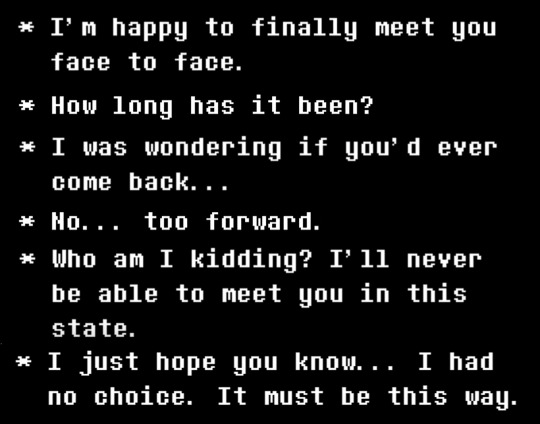
Even now I’m still not 100% sure whether his first line of dialogue is him rehearsing a conversation with another Ruins monster, with the monster that used to leave him corn, or with the previous human that he encountered. The fact that Dalv is known by the other monsters for talking to himself and having imaginary friends only blurs the lines further, though this doesn’t feel intentional.
This is part of a broader, though minor, issue with some of Yellow’s writing where characters will allude to events and other characters that a first-time player wouldn’t be familiar with. To be fair, Undertale does this as well early on but usually with enough context clues to help you figure things out—Papyrus namedrops Undyne and Alphys in Snowdin, but we learn from context clues within Snowdin that Undyne is a monster of authority that Papyrus knows and Alphys is a doctor and apparent inventor.
To draw a more direct comparison, we know early on that Toriel is a motherly figure and we see in her house that she has taken in other children who’ve met an unknown fate—this mystery leads to some first-timers speculating whether Toriel is the one responsible for said fate. Right before her boss fight she explains her motives more clearly--her actions, though overbearing, have been to protect Frisk. You can also infer, though not stated directly, that her actions towards Frisk may be some attempt on her part to recreate or make up for her past experiences with children that she’s lost. Later on we learn that she’s Asgore’s ex-wife and lost her two children tragically, but this is not something that needs to be spelled out in order to get a basic grasp on Toriel as a character.
Dalv, on the other hand, has an implied backstory that is never outright stated but instead needs to be pieced together from context clues given much later in the game, some of which are tied to optional secrets and randomly-generated fun events. In short, Dalv was a monster living in Snowdin who met Kanako when she and Chujin came to visit. During that visit, Dalv was attacked by a human (implied to be the one carrying the blue soul), who was later killed by Axis. It’s implied that this experience was so traumatic that Dalv retreated into the Ruins and cut off all contact with those around him. Conceptually? This is a solid backstory. No notes. It’s a shame, then, that most players don’t even seem to be aware of it after finishing the game.
Now, a character doesn’t need a tragic backstory in order to be likable or compelling. In fairness, I do enjoy the aspects of Dalv’s character that are given upfront in his house—his neatness, his social awkwardness, his creative side, and his “imaginary” friends. The problem is that we don’t see these sides of him until after his boss fight, when most players likely won’t see him again for the rest of the game.
Characters don’t need to front-load their entire personality or backstory into their first encounter, but doing the opposite isn’t helpful either. First impressions matter in fiction, and unfortunately Dalv gave very little for me to latch onto for most of his screentime. It’s really only through hindsight that I began to appreciate Dalv as a character, but even then he isn’t one of my favorites in Yellow, let alone comparable to Undertale’s core cast.
Martlet
Martlet is the most recurring character in the game aside from Flowey. Although her personality is quite different, I get the sense that her role is meant to be analogous to that of Sans and Papyrus, namely as a comic relief character that drops into your adventure regularly and presents a crucial turning point right before the game’s ending.
Martlet’s introduction gave me flashbacks of Dalv—namely that she never even interacts with Clover until the end of Snowdin, making me fear that once again a new character’s story was going to be backloaded into their final appearance before they disappear from the narrative. Thankfully this wasn’t the case. Martlet’s in it for the long haul and her boss fight is more of an introduction to her character than a conclusion.
So what do I think of Martlet? I’d say that I like her more than Dalv, or at least she’s better utilized than Dalv. Still, it took a while for Martlet to “click” with me. I think what I got hung up on was that a lot of her early gags revolve around royal guard protocol and the handbook that she keeps around. In many ways this feels at odds with what’s later established about her character, namely that she’s scatterbrained, wishy-washy, and lacks long-term goals or planning skills.
Martlet doesn’t seem like the type of person who’d follow a handbook in the first place, given how often she disregards it anyway. Perhaps the intent was for Martlet’s “arc” to be her unlearning what she’s learned from other monsters regarding humans and for her increasing disregard of the handbook to symbolize this. While I think the former is true—she says as much on the apartment rooftop at the end of the game, she seems to waffle back and forth on following her royal guard duties as the plot demands—ignoring them when it means accompanying Clover but following them when it means having to be separated from Clover.
I think this ties into a bigger issue that I have with Martlet, which is that at times she feels like she’s a character of convenience for the story rather than a character acting on a clear want or need. I think this is most blatant when viewing the various “abort” points in a no mercy run.
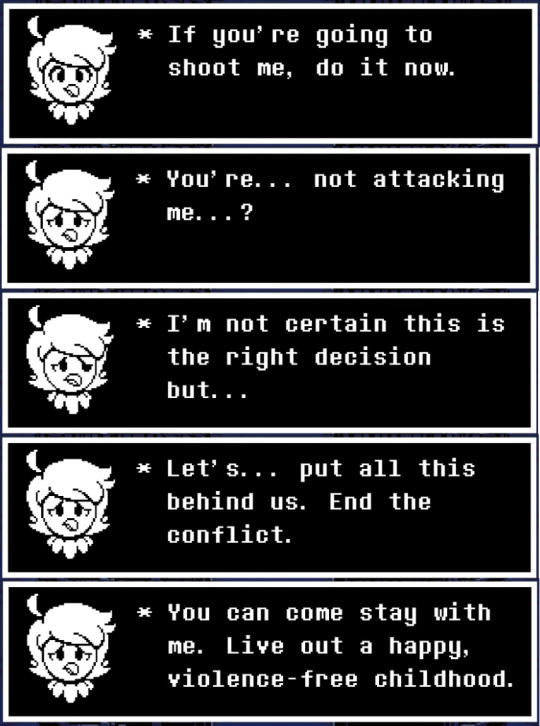
No matter how badly you beat Martlet in Snowdin and how resolute she is at stopping you, she’ll turn on a dime if you’ve aborted a run prior to Oasis or Hotland just so that she can play out her allotted part.
Other times it feels like she’ll show up just so that there’s someone for Clover to talk to and someone to react to what Clover sees. Now, it would be reductive of me to write off Martlet as a mere plot device—she isn’t, and any appearance otherwise is more so a flaw of the narrative than of her as a character.
You’ll notice I haven’t said much about how I feel about Martlet’s personality, her dynamic with other characters, or her overall “vibe” and honestly she’s just… fine? It’s hard for me to say anything because she feels a bit lukewarm to me—she’s not undercooked like Dalv, but she’s not as memorable as many of the other characters either. She says some funny things, but she’s not the funniest. She has some great and heartfelt lines during the pacifist ending, particularly this one:
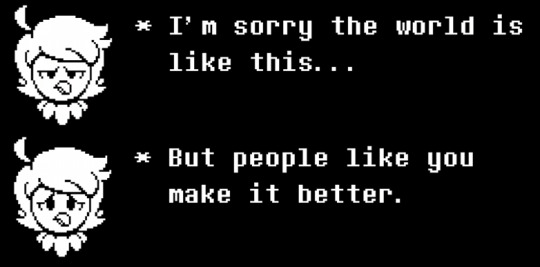
But as a whole? She’s just fine. She's competently written, no major complaints.
I think maybe what Martlet lacks is a “larger than life” quality to her character. I’m not saying that her role within the setting should be larger than life, but rather she could use at least one exaggerated trait to help her stand out from the pack—Papyrus has his bravado, Sans has laziness and jokes, Undyne has intensity, Alphys has awkwardness, and Mettaton has his showmanship. Not every Undertale character is like this, but I feel like Martlet was intended to fit a similar mold—we catch glimpses of it, like her overly long “P.S.” messages amended to her first puzzle, but imo she doesn’t go far enough consistently enough (assuming that was the intent).
One last thing that I want to touch on is Martlet’s contingency plan for Clover that comes into play in the No Mercy run, where she injects herself and becomes “Zenith Martlet,” as fans have dubbed her. Conceptually I’m fine with the idea of Martlet having an ace up her sleeve that she’s too indecisive to actually use in most scenarios.

This feels in-character for her and I can even look past a scatterbrained character with no planning skills having a plan like this since it’s largely Martlet appropriating another character’s plan. The main thing that I find questionable about Martlet’s plan is that it relies on Alphys’ determination extraction experiments.
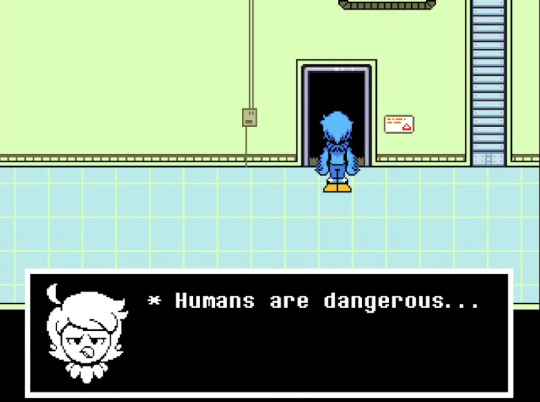
We the audience know what that is, but how does Martlet know about them or even what to look for? We do know that underground residents were asked to donate fallen down monsters to the lab, but seemingly nothing is revealed to the public about the nature of the experiments. Even Ceroba, who had a vested interest in learning all she could, seems to be completely in the dark. In the pacifist ending, Martlet offers to investigate the experiment for Ceroba, implying she didn’t know the full story either. I also question how Martlet would’ve been able to venture into the true lab seemingly without running into a single amalgamate, given that she never brings them up in pacifist.
Now, my issue here is not the supposed “plothole” that this creates. My main issue is that a more reasonable solution was sitting right there: Chujin’s monster serum. I legitimately wonder if earlier drafts of this game’s story had Martlet using Chujin’s serum instead of Alphys’ extract, because the former would bring everything full-circle and it would tie in more naturally with the flashback scene of Martlet with Chujin.
Now, the obvious answer is that Chujin’s serum was never completed, but I can’t help but wonder if perhaps this wasn’t always the case. During Ceroba’s flashback, we can see a case with two syringes—one full and the other seemingly empty.
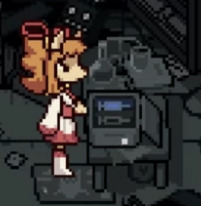
This is just my own speculation, but I can’t help but wonder if it was once intended for Ceroba to use one syringe on Kanako and for Martlet to have taken the other. Obviously this doesn’t jive with the story as it’s currently written—Martlet is clearly taken aback when she learns of the experiments that Chujin conducted. Still, part of me wonders if an earlier draft had Chujin entrust Martlet with a prototype of the serum to keep her safe.
I think it’d be fitting if the no mercy route were to reveal that Martlet was a lot more privy to Chujin’s less savory actions than she let on, and that even in pacifist she kept this knowledge to herself of self-preservation or shame. This would fit with a line of hers in the no mercy fight after her flashback of Chujin:

It would be fitting for the NM run if we were to learn that there was always a seed of doubt and mistrust between Martlet and Clover, even during the best of times.
The Feisty Five
I’ll be brief, but when these guys first showed up my first thought was “great, I’ll never remember all these new characters” and I’m glad I was wrong. While they don’t have quite the depth that the main characters do, they’re all memorable in their own way. They’re also the first characters in the game to get a serious chuckle out of me and I wish we got more of them. If we’re comparing quirky miniboss squads, these guys clear the Snowdin canine unit and Sweet Cap’n Cakes. There, I said it.
Starlo
This is the coldest take ever and I won’t even try to bury the lede: Starlo is the best Undertale Yellow character. He’s funny, he’s charming, he’s flawed, he has layers, he has great moments of pathos with Ceroba, and he has a backstory that isn’t tragic yet still feels necessary to his character.
Here’s another cold take: Dunes/Wild East is the best part of the game. Dark Ruins and Snowdin, while not bad, still feel very much like typical fare for a romhack or fangame. Wild East is the first area that truly feels like Undertale, which is ironic since it’s also the first completely-original area.
By extension, Starlo is the one original character who feels most like he could be an Undertale character. It’s easy to take for granted all the little nuances that Toby injects into his characters to make them stand out, which is probably why I felt so lukewarm towards Yellow’s cast up until Starlo’s introduction.
One thing I admire about Undertale’s core cast is that each character has their own unique manner of speaking, to the point where you can identify a character’s dialogue without needing a dialogue portrait or typer sound. Starlo shares this trait, speaking in a semi-stereotypical drawl while occasionally misspelling words (FEISTYJ, dual vs duel). It’s a small touch but it goes a long way to endearing me to the characters in these games.
Although Starlo is mostly a comedic character, he still has plenty of depth. Another hallmark trait of Toby Fox characters is that they have multiple sides to them that seem contradictory at first glance but actually tell you something profound about the character (Papyrus’ bravado masking his loneliness, Sans’ joking to cope with his harsh outlook, Alphys’ awkwardness stemming from her guilt).
Starlo also fits this trend, first presented as a dashing and charismatic lawman that is nothing more than the mask of a nerdy and immature farmboy. And I would say Starlo’s fatal flaw is immaturity—not because of his interests, but because of his attitude. Starlo treats his friends like playthings, takes what he wants from Clover and Martlet when he first meets them, and he acts utterly irresponsible with his (or rather, Blackjack’s) firearms.
We learn from Starlo’s mom that he once pined after Ceroba and that he took a long time to move on.

It’s also implied that Starlo had a grudge against Chujin, which could have been due to the two having differing opinions on human culture or Starlo’s own jealousy over Ceroba.

We can also see this immaturity reach an ugly conclusion if Ceroba is killed in the so-called false or “flawed” pacifist ending. Starlo previously trained Clover to carry the weight of taking a life and also taught them the value of sacrificing one life to save many, but Starlo immediately throws this out the window as soon as Clover acts (as far as he’s aware) in self-defense.
This is a case where I’d argue that Starlo is right but for the wrong reasons. Starlo’s not so much recanting his earlier philosophy as he’s simply upset because someone he cared about was sacrificed this time—had it been a stranger or a ne’er-do-well like Vengeful Virgil then I doubt Starlo would’ve parted ways with Clover so bitterly. That’s just my interpretation, anyway.
None of this is to say that Starlo is always immature. When it comes to his interactions with Ceroba he’s often the most sensitive and emotionally-mature person in the room, which is a trait that we only see grow in him after he gets a reality check in the Wild East. When trying to talk Ceroba down we see Starlo give his respect to Chujin, despite their past differences, and he’s patient and understanding to the utmost once the fight is finally over.

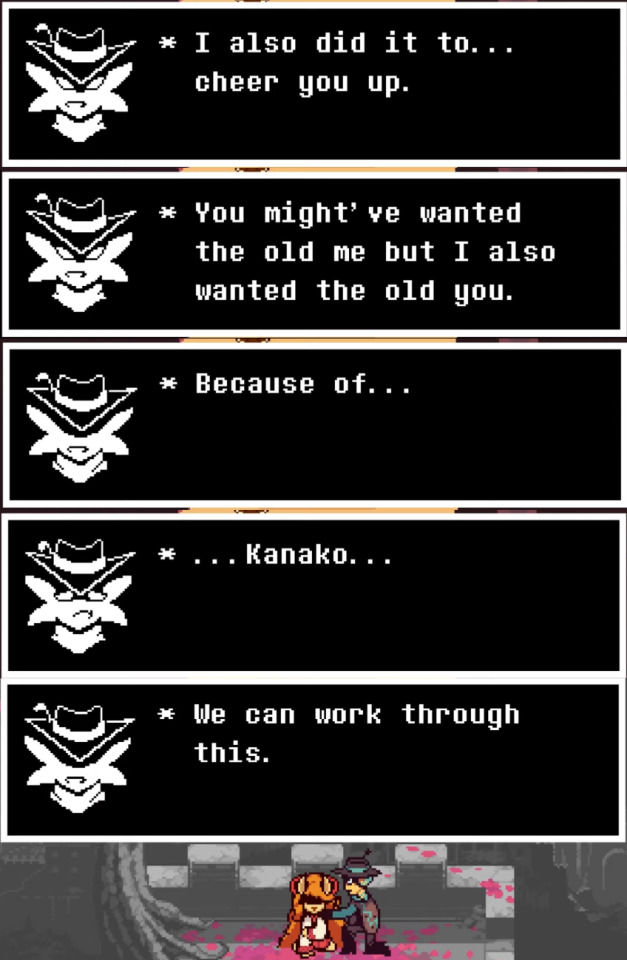
This doesn’t mean that Starlo is a doormat for Ceroba either, as we earlier see him confront her and call her out when he suspects foul play involving Kanako—he clearly cares for Ceroba a lot but won’t sit idly by while she ruins her life or the lives of others.

Honestly, Starlo’s bond with Ceroba is a contender for the most wholesome relationship (platonic or otherwise) in the entire franchise—yes, I’m actually saying that there’s an aspect of this game’s writing that rivals and perhaps even surpasses Undertale and Deltarune.
I realize a lot of my analysis of Yellow’s writing has skewed negative, but as a reminder I am grading this game on a curve because it’s a companion piece to one of the best-written games of all time. To give Yellow a bit more praise, I think it might actually do a better job than Undertale at portraying characters’ moments of vulnerability and allowing them to cut to the emotional core of an issue, as seen with Starlo and Ceroba’s late-game interactions as well as Clover’s ultimate fate and its aftermath.
Unlike Undertale, there was no moment in Yellow that quite made me cry, but moments in the pacifist ending came close. I consider this quite the feat because the final outcome of Yellow’s pacifist ending is easily predicted from the start and the way that it plays out is a concept that would be difficult for any writer to sell. Yellow was backed into a corner by being a prequel, whereas Undertale had free reign to tell whatever story it wanted. In many ways I feel Yellow’s ending did just about the best job it could with the hand that it was dealt—it’s not perfect, and in one or two areas I feel it overplays its hand (which I’ll cover shortly), but the writing succeeds far more than I would’ve thought it would have with such a concept.
Axis
This’ll be another brief entry, but I wanted to include Axis since he always seems to get left out of fanworks. I enjoy Axis but I’m not sure I fully understand him. His overall arc and goals are very straightforward, but for the life of me I can’t really nail down what his personality is. He’s funny and memorable, which goes a long way for me, but I can’t really wax poetic about him beyond saying that he’s your stock quirky robot. It is a bit of a shame that, like Dalv, he’s largely isolated to one area and has little to no interaction with the rest of the cast.
I suppose one thing that bothers me is how robots in this game aren’t treated as people, which feels at odds with the broader themes of Undertale. We’re taught that amalgamates and even a soulless flower are still people, so having robots that lack free will and don’t even count as EXP kinda rubs me the wrong way. I generally don’t like when fictional works treat sentient robots as less than human or “soulless.” In my view, the true point behind sentient robot stories isn’t to debate whether robots have souls, but rather to question what a soul is and who gets to decide who has one and who doesn’t, or whether they exist at all.
Robots in fiction are meant to be a reflection of humans, and the robots in Yellow could have been presented as a reflection of video game characters as a whole—can free will exist when you’re programmed to fulfill a function? Unlike in our world, souls are a scientifically measurable quantity in Undertale’s universe, so I guess Yellow’s portrayal of “soulless” robots works on a technicality, but that doesn’t mean I have to like it.
Ceroba
I don’t think it’s a stretch to say that Ceroba is the most controversial character in the game, and I find my own opinions of her (and her family) to be polarized as well. In a neutral run she’s barely noticeable but in pacifist she eventually becomes the main focus of the story. I’ve seen some people criticize Ceroba’s level of focus, but I’d liken it to Alphys and Flowey’s elevated level of focus in Undertale’s true pacifist ending. In other words, it doesn’t bother me.
Ceroba’s personality is a bit of an anomaly for me in the sense that she’s not quirky like a typical Undertale character, and yet I feel that aspect of her works for the story that Yellow tells. Previously I mentioned how Martlet didn’t really “wow” me as a character in part due to her lacking a sufficiently “larger than life” personality, but I feel Ceroba succeeds where Martlet didn’t for me because (1) Ceroba is clearly not intended to be a comic relief character and (2) Ceroba often acts as the straight man to other characters like Starlo and the Steamworks machines, whereas Martlet often feels like she has no one to work off of her besides Clover (for whatever that’s worth). In many cases, Ceroba’s understated reaction to things or her attempts to parse or explain them rationally end up making scenes funnier, such as when Starlo cuts off her piece on the ethical quandary of his trolley problem.
Having said that, I do think it’s a bit of a missed opportunity that the game doesn’t expand more on Ceroba’s own interests or quirks outside of her family. While showcasing a character’s hobbies can sometimes feel like checking an item off of a list, it helps add a bit of texture to a character that makes them that much more believable.
Not knowing this information doesn’t “ruin” Ceroba or anything, but it’s a bit disappointing that most of her “talk” dialogue in the steamworks, while interesting, pertains to her immediate surroundings or her family and friends instead of herself. The most we get is that she used to have a gym membership and (if I recall) she was once a waitress. We later get to see her room and all that’s in there is a bed, a photo, and her clothes. After seeing all the loving detail put into Papyrus and Alphys’ living areas in Undertale, it’s such a shame to see Ceroba’s opportunity squandered.
Oddly enough, if there’s one existing bit of characterization that I think could’ve been retooled sightly, it’d be Ceroba’s dynamic with Clover. Ceroba is a mother who lost a child around Clover’s age (or younger) but she’s also distrustful of humans and had a husband who hated them. You’d think that Ceroba would react strongly to Clover one way or the other, either distrusting them as a human or having a soft spot for them due to Clover being a child, or feeling conflicted between these two outlooks. Instead Ceroba seems utterly casual around Clover.
Initially her laid back attitude served as a nice contrast to the overbearing wackiness of Starlo and the Feisty Five and helped endear Ceroba to me as a character, but it begins to feel a bit out of place when she says things like "I respect the hell out of you" to a child.
Maybe I’m overthinking it, but the way Ceroba treats Clover makes sense for how she’d treat a stranger who was a monster, given what we see of her personality, but I’m just not sure it makes sense that she’d treat Clover that way specifically. I’d be fine with it if the narrative unpacked the idea—maybe she’s casual around Clover because she’s too world-weary to muster a strong reaction, or maybe she’s forcing herself to act casual to hide her true plans for Clover, or maybe she never fully agreed with Chujin’s rhetoric on humans and is acting against them out of pragmatism, or maybe she never liked kids until she had one of her own, etc.
Speaking of kids, I guess there’s no avoiding the elephant in the room: Ceroba’s backstory. If I had to guess, I’d wager this is probably the most controversial portion of Undertale Yellow’s entire narrative, and I have a lot to say about it.
To start, I’ll say that I really like the way that (most) of Ceroba’s backstory is doled out to the player piece by piece over the course of a playthrough. As early as Snowdin you hear mention of Chujin, then in Wild East you can piece together from various bits of dialogue that Ceroba had a family that she’s reluctant to speak about. Steamworks fleshes out Ceroba and Chujin’s pasts considerably, albeit mostly hidden behind optional talk dialogue.
Steamworks also has one of my favorite scenes in the game when Ceroba learns why Chujin got fired—it technically doesn’t contribute anything major to the main plot, but it helps illustrate Chujin’s flawed methods that Ceroba willfully overlooks so that she can double down on furthering his “legacy.”
Right before Hotland is when the other shoe drops and Starlo confronts Ceroba—this was the moment that had me hooked on uncovering the mystery of Ceroba’s past. This leads right into the abandoned Ketsukane estate, which is another of my favorite sequences in the game. I was always a huge fan of Undertale’s True Lab and Ceroba’s house scratches that itch for me. The two locations have a very different tone and style of gameplay (or lack of), but both are dripping with unsettling atmosphere and environmental storytelling. Maybe it’s just me, but I’ve always been creeped out by abandoned houses—not decrepit haunted mansions per se, but places that were abandoned so recently that you’re not sure whether someone might still be lurking inside.
Unfortunately, I start to run out of nice things to say about this storyline as soon as Clover and Martlet enter the estate’s basement. Before we descend into that chasm, I want to make one thing perfectly clear: I am not a “Cinema Sins” kind of guy. I do not go into a work of fiction looking for inconsistencies to complain about. My philosophy is that I can overlook the occasional plothole or retcon or bending of the rules if it’s done in service to a good story or memorable character moment.
If anything, I find it annoying when a story tries too hard to cover all its bases with exposition out of fear that some smartass is going to find some plot detail to complain about—this just draws more attention to potential “plotholes” that could’ve easily been ignored. I don’t care if the eagles could’ve carried the ring to Mordor and I don’t care whether the ark of the covenant would’ve killed the bad guys in Raiders if Indy wasn’t there. At the end of the day, if a story is well told then I can overlook things like that, and if it’s not well told then my mind wanders and I begin to notice those sorts of things, but those nitpicks (more often than not) are not the underlying cause of the problem—lack of a compelling story or believable characters is.
So, getting back to the basement. Here we see Chujin’s tapes and the plot begins to lose me. Chujin wants to create a serum that will strengthen monsterkind and give normal monsters the power of a boss monster. All well and good. Where I start to take issue is the convoluted method of creating this serum and what it means for the story.
As a point of comparison, I always thought that the rule in Undertale of requiring a human soul plus a monster soul to pass through the barrier felt a little convoluted and contrived, but it seems to exist for the sake of forcing a “kill or be killed” confrontation between Frisk and Asgore as well as explaining why Asriel passed through the barrier with Chara’s soul but (presumably) Chara alone couldn’t. In this way, the rule acts in service to the story and creates memorable character moments with Alphys and Asgore and gives Frisk a stronger temptation to kill Asgore during their fight. The two soul rule is a bit clunky, but I can begrudgingly accept it. Chujin’s serum fulfills a similar purpose but is clumsier in its execution.
To start, Chujin’s serum also requires a human soul and a boss monster soul—this makes sense, as the goal is to turn monsters into boss monsters and one can assume that human souls have some kind of preserving property that would keep the serum stable.
On top of that, the human soul must also be “pure of heart, uncorrupted.” I thought nothing of this line initially until it was reiterated during Ceroba’s flashback and I realized why it was in the story.

This concept bothers me for a number of reasons and it’s technically not even a plothole or inconsistency. It feels out of character for Chujin to frame things this way given how he views all humans as evil, and this purity rule seems to exist solely as a plot device to explain why Ceroba enacts her plan in pacifist but not in neutral runs. I feel like the story could’ve come up with a more organic method of explaining why Ceroba couldn’t be present or was otherwise occupied during the steamworks section in a neutral run, plus I feel like she wouldn’t let something like “purity” get in the way of attempting her plan if she was that dead-set on it, given how rarely humans appear in the Underground.
Lastly, we learn that Chujin and Kanako are both boss monsters, or at least “carry the boss monster gene,” which is an odd concept to me. You could argue that this revelation technically doesn’t contradict anything established in Undertale, but like the pure soul rule it just bugs me. Maybe it’s because it reminds me of the early days when the fandom thought that all bosses in Undertale were boss monsters instead of just the Dreemurr family. I won’t waste time rambling about the particulars of boss monster lore, but I think what bothers me with Chujin and Kanako is that it feels like yet another contrivance to explain why Ceroba’s actions had to involve Kanako specifically.
I’ve mentioned that Undertale’s two soul rule feels somewhat like a contrivance. One could argue that the Barrier requiring seven human souls to shatter is also a contrivance, but I think what makes that easier to swallow is that it’s a rule that’s established fairly early in the game. The reveals of the Barrier’s two “rules” are spaced apart from one another and each are given dramatic weight and time for the player to dwell on their implications.
The mechanics of Chujin’s serum, on the other hand, rely on multiple contrivances that are all spilled out onto the floor at once in the final stretch of the game right before they become necessary to explain Ceroba’s motivations, which only makes their narrative purpose feel all the more transparent.
Getting back to Ceroba, we’re left with her plan and what she did to Kanako. Now, I’m going to give the benefit of the doubt here and say that I don’t mind the particulars of whether Ceroba’s plan involving Clover would have worked or not—as far as I’m concerned, Chujin’s plans could have been doomed from the start even with a “pure” soul. The point wasn’t whether Chujin’s plan would’ve worked but rather how Ceroba’s grief has turned her own life (and by extension the lives of her family) into a sunk cost—she feels that she has to go through with her plan or else all her family’s suffering was for nothing.
In many ways this makes the contrived requirements for Chujin’s serum feel less necessary, since the serum’s mechanics could’ve been kept vague or it could’ve even been implied that Ceroba was simply repeating the same experiments as before hoping for different results.
I’ve put it off long enough, but it’s time to talk about that scene. You know the one: the big reveal flashback at the climax of Ceroba’s pacifist fight. Again, I’ll try to be charitable and say that I don’t absolutely hate the idea of Ceroba testing Chujin’s serum on Kanako. I mean, I would hate the act on a moral level if she were a real person, but I don’t hate the idea as a story concept. Still, my charity has its limits.
I’ll just come right out and say it: the scene where Ceroba injects Kanako is hard to watch—not because it’s tragic, but because it’s just not a good scene. My original write-up for this part was far harsher, but I’ll spare the vitriol. This scene has been memed to hell and back by people more critical of the game and… I can’t disagree with them—this is my least-favorite scene in the game.

(Image from ScottFalco's "Undertale Yellow with a side of salt" video)
The most obvious criticism I’ve seen is the fact that Chujin specifically told Ceroba not to do the exact thing that she does. That’s a fair point and honestly, yeah, I think the simplest writing fix would’ve been for that line not to have been in Chujin’s tape to begin with so that Ceroba doesn’t look willfully ignorant on top of being recklessly negligent.
Tbh, it feels a little out of character for Chujin to say something like that because I got the impression that Chujin wasn’t always the most thoughtful or attentive dad. His own tapes mention that he didn’t keep an eye on Kanako when a monster was attacked in Snowdin, and even then Chujin was more preoccupied with tracking down the human than with comforting his own daughter. He made nice things for Kanako, sure, but even that could be explained as him being more wrapped up in the work than her. It’d be wrong to say that he didn’t care about Kanako at all, but I got the impression that he had the wrong priorities and it’d be fitting if Ceroba’s own actions followed that pattern.
That being said, I can’t solely blame Chujin’s warning for why Ceroba’s flashback doesn’t work. The scene as a whole is just dreadful, even when viewed in isolation from the rest of the narrative. There’s so many issues big and small with this scene, like Kanako being able to read the word “corruption” but not “extract,” Ceroba’s immediate turnaround after the slightest prodding, or the predictable outcome of the whole thing that’s dragged out for what feels like an eternity.
You know, I’ve heard some people critical of Undertale say that the true pacifist ending to that game felt maudlin—I disagree, but in some places I could see where they were coming from. Calling the Kanako flashback maudlin would honestly feel like letting it off easy. If I wanted to be mean I’d call it manipulative, but honestly I think a more fitting term would be a comedy of errors. It feels less like tragedy and more like dark humor bordering on self-parody of what an Undertale character’s sad backstory would be.
So what should’ve been done differently? The easy and safer option I’ve seen suggested would be for Kanako to stumble across Chujin’s research and inject herself, with Ceroba feeling guilt for allowing it to happen. I would prefer this over what we got, but I said earlier that I don’t completely hate the concept of Ceroba experimenting on Kanako, so how can that idea possibly work? Besides getting rid of Chujin’s overly-specific warning, I honestly think the best fix for this scene would simply be to not show it. Don’t remove the events from the backstory, but just don’t reenact them onscreen. Normally it’s better to show than tell, but there have always been exceptions to that rule.
I’m reminded of how Undertale didn’t show us Asriel’s death or the Dreemurrs’ divorce, and only offered a glimpse of Chara’s buttercup plan. These were cases where less was more—letting the players imagine these events in their heads sidestepped any potential tastelessness and seeing the aftermath of these events and how they affected the characters involved painted a vivid enough picture. I think Ceroba would be a perfect fit for a similar approach.
If we need to see something, then either portray it via montage like Asriel’s memories or only portray Kanako finding Chujin’s basement and Ceroba stumbling upon her after she’s viewed the tapes. Ceroba could then explain to Clover that Kanako pleaded with her for months or even years to let her help with Chujin’s experiments. With time Kanako only become more stubborn and their relationship more strained. The whole time Ceroba knew that only Kanako’s soul would work for the experiment but she tried to remain in denial and hope an alternative would present itself. After countless research dead-ends used up all but one vial of the leftover human soul extract, Ceroba gave in to Kanako’s demands in a moment of weakness. And that’s all it took—one moment she was there and the next she was gone.
Not to toot my own horn, but I feel this kind of summary would’ve worked better because it leaves things up to interpretation. Was Kanako still a child when this happened or was it many years later? Did Kanako understand what she was signing up for? Is Ceroba’s recounting of the events reliable or is she merely rationalizing her actions after the fact? It’s not perfect and it’s still somewhat “safe” compared to the game’s swing for the fences. Unfortunately, a big swing means nothing if it misses, and even less if the bat goes flying and hits someone.
Despite what I just said, the Kanako scene doesn’t ruin Ceroba for me as a character. It blemishes her boss fight for me, though I have other issues with that fight besides the flashback (as I’ve mentioned). When thinking back on this game’s characters and story, I mostly just ignore the particulars of the Kanako scene unless if I need to sit through it again. I view it as the equivalent of a flubbed line read or a boom mic visible in a shot--I can see the pieces that were meant to be there underneath the lackluster execution.
Surprisingly, Ceroba’s still my 2nd favorite original character in Yellow, though a lot of this is owed to her dynamic with Star, and part of me wonders if I like her more for the character she could’ve been rather than the character we got. Still, I’ll always remember the buildup to the mystery of Ceroba’s backstory, even if the reveal failed to deliver.
Flowey
Flowey is one of my favorite Undertale characters as well as the only character from Undertale featured in a recurring lead role in Yellow, so I was curious to see how this game would handle him.
When this game was first announced, many fans debated the “canonicity” of whether Flowey would have encountered the human who fell prior to Frisk and whether Flowey would retain his save abilities in such a scenario. Often this debate overshadowed the other aspects of Flowey’s portrayal, so to avoid doing the same, I’ll just say that I don’t believe Toby ever intended for Flowey’s save abilities to function in relation to a human like how they’re portrayed in Undertale Yellow. However, I don’t take issue with this “lore contradiction” because I feel that the way Flowey is utilized in this aspect works for the story that Yellow is trying to tell. Flowey’s role is to limit Clover’s own powers and to keep their story on-track.
It’s easier to tell a prequel story where the main character is destined to die if that character doesn’t also have the ability to return from the dead at will or turn back time, so having Flowey fill that power vacuum makes sense. Despite this, Clover is still given plenty of agency. Flowey only railroads their story in two notable instances: whenever Clover is going to live with Toriel or when Martlet offers to have Clover come live with her in a neutral run. Both outcomes would be a bit of a cop-out for the game’s main conflict and would be the boring option as well (sorry fanfic authors)—Flowey agrees with this sentiment, making it feel justified that he’d intervene.
Having gotten that out of the way, what do I think of Flowey’s portrayal? Compared to Undertale, it’s interesting to think how much more screentime Flowey receives in Undertale Yellow, despite Flowey being the main antagonist and ostensible central character of Undertale. Since Flowey’s story can’t be allowed to conclude in Yellow, his character is kept in some degree of stasis—in many ways, Yellow’s portrayal can be seen as “Flowey, but more.” That might sound like a pejorative, but for the most part I think it works here. Flowey’s interactions with Clover honestly make him feel a little underutilized in Undertale by comparison.
That said, Undertale was a game intended to have moments of isolation, so having Flowey chime in at every save point likely would have diminished that effect and also made Flowey less threatening due to overexposure. I think Yellow can get away with giving more screentime to Flowey because for most of the game his mask hasn’t dropped—he has every bit of ill intent that he did in Undertale, but for the sake of his plans he has to play along at being your friend for far longer than he did in Undertale.
The result is that very little of what Flowey says in Yellow can be taken at face value once you know his aims. Until that point, however, I think the game does a good enough job at keeping you guessing as to how far gone Flowey is and at what point in his moral decline this story is meant to take place. If someone played this game without playing Undertale first, they’d probably chalk up Flowey’s mannerisms to him just having an odd and occasionally morbid sense of humor, which isn’t far from the truth.
One thing that I appreciate about Yellow’s portrayal of Flowey is his dynamic with Clover—the game manages to thread the needle of not making their relationship an also-ran of Flowey and Frisk or Flowey and “Chara” from Undertale’s No Mercy run. For most of the game you get the sense that Flowey views Clover as a means to an end that he’s forced to humor and put up with, but that deep down he likely has some small sentimentality towards them (mainly shown in the pacifist ending).
I think Flowey’s relationship with Clover in neutral and pacifist gives us a look into how he likely acted around the other monsters of the underground back when he tried to solve their problems or form bonds with them—he can’t fully relate to them but is willing to fake it ‘til he makes it, or rather until they make it to the outcome that he wants. If I were to draw a more direct comparison, I think Flowey’s bond with Clover might be the most similar to his bond with Papyrus—he’s implied to have spent a lot of time with each of them and found them each amusing in their own regard, but ultimately Flowey isn’t above using them or casting them aside.
What I find especially compelling about Flowey and Clover is the turn that their partnership takes in Yellow’s No Mercy route. Here Flowey initially seems to be cautiously optimistic about Clover’s rampage, but as his advice is ignored he grows increasingly exasperated with their actions. It’s strange to say, but it’s a refreshing dynamic to see Flowey outright grow to hate his human companion—while he voiced plenty of insults and disdain towards Frisk, it came off more as condescension or an attempt at intimidation.
In Yellow, however, you can really feel Flowey becomng absolutely fed up with Clover, not just for their pushiness and disobedience in the no mercy route but also for the hundreds of runs where Flowey has had to string them along and, in the process, be strung along himself. This development is much better-paced in Yellow than Flowey’s turn toward fearing Chara in Undertale—it’s amazing what can be done when you’re allowed to have more than four conversations with a character.
That said, I don’t think there’s any one Flowey moment in Yellow that quite lives up to Flowey’s speech in New Home or the conclusion to his story in the form of Asriel—those two moments will forever be peak Flowey to me. When comparing Undertale Flowey to Yellow Flowey, it’s a case of quantity vs quality, but in this case the “quantity” is still pretty good.
If I had to voice any complaints for Yellow Flowey beyond a broad “it’s not as good as something near-perfect”, I will say that when Flowey’s mask does drop in Yellow, he doesn’t sound quite as crass or childish as he does in Undertale—something I feel is important to him as a villain, but this is a very minor nitpick since he has plenty of lines in this game that go hard. I didn’t even notice the difference in speech styles until I went back and watched footage of Undertale and realized “oh yeah, I guess he sounds a bit more childish here.”
I suppose there’s one other thing I should discuss regarding Flowey. This is a topic that I intentionally saved for last since I find it’s a perfect capstone for Undertale Yellow and my opinions on it: Flowey’s boss fight. If ever there was a case of “Flowey, but more,” it would be this fight. For years Undertale fans have speculated and wished and wondered what a fight against plain old vanilla Flowey would be like. Countless fangames and fan battles have tried.
Yellow opts for an unorthodox approach by centering the entire fight within Flowey’s mind—this framing is used to its fullest and then some, allowing for interface-screws and psychedelic attack patterns showcasing Flowey’s twistedness, his self-loathing, and his various forms of retraumatization.
Players are attacked by phantoms of any bosses that they killed, complete with Floweytale-esque corrupted designs. This aspect of the fight dovetails perfectly with Flowey’s comment about only enjoying the moments of Clover’s run where they “gave in” to their violent urges, and clearly these moments are etched in Flowey’s memories for Clover to relive.

Afterwards we’re treated to a peek behind the curtain at Flowey’s subconscious, featuring a collage of his first runs as a flower—this whole sequence adapts my favorite Flowey moment from Undertale while not tipping its hand too much by revealing Flowey’s true identity, as it easily could have in less-skilled hands. We’re given just enough to ponder without spoiling things for the mythical gamer who tries playing Yellow before Undertale.
Next up is a brief horror fakeout where Clover “reunites” with Martlet. I don’t have much to add other than the telegraphing being a bit obvious but not in a way that majorly detracts from the moment. Overall it just makes me consider that this fight as a whole might be scarier than anything in Undertale
Finally we have the climax of the fight. I’m not quite sure what to call it. Photoshop Flowey 2.0? To be brief, the visual spectacle shown in this phase surpasses not only the visuals of any sequence (so far) in Undertale or Deltarune, but I think it’s unlikely that future chapters of Deltarune will feature anything with visual flare on the level of this finale.
That’s probably the highest praise I’ve given to Undertale Yellow so far, which is what makes this next part so difficult. I’m sure this will go down as my hottest take in this entire review, and it breaks my heart to say it given the clear effort on display from the developers, but…

I did not care for the Flowey fight.
How can I even say that? Was all of my prior praise just a lie? Not at all—I meant every word of it and then some. So how is it possible that I didn’t like this fight? You’ll notice that I broke down the Flowey fight into its individual phases and aspects, praising each in isolation. You might also notice that my praise was aimed at the spectacle and underlying concepts of the fight, which are fantastic, but I had very little to say about the actual experience of playing the fight—and that’s because I found the fight to be an utter slog to get through. In hindsight, it might actually be my least-favorite fight in the entire Undertale franchise if we’re solely talking about the gameplay. I’d rather fight a Jerry than have to fight this thing again.
I’ll admit up front that I sucked at this fight when I played it. I sucked at all of Yellow’s final bosses and initially didn’t care for their gameplay. I eventually warmed up to Ceroba and Martlet’s fights as I got better and learned to beat them without needing easy mode, but the Flowey fight never clicked for me in the same way despite arguably being the easiest of the three.
So what’s the problem? There are little things here and there—I found some of the phase 1 attacks a bit obnoxious to dodge, though nothing major. I found the collision detection in the vine chase sequences to be a bit clunky, resulting in one or two deaths that felt unearned, but none of these issues are enough to sink the fight.
No, two major missteps that come to my mind are length and repetition.
Out of curiosity, after my neutral run I looked up gameplay videos of the Yellow Flowey fight and the Omega Flowey fight from Undertale: on average, Yellow’s fight took players twice as long to complete as the Omega Flowey fight. The difference is so stark that a “no hit” speedrun of Yellow’s fight with dialogue skipped, the intro cutscene edited out, and no attacks from killed bosses is still longer than an Omega fight played normally.
I want to be clear that my criticism here is not “it’s different from the Omega fight, therefore it’s bad.” The Omega Flowey fight, in my opinion, already drags at times, and it’s probably my least-favorite final boss in Undertale despite having the most effort put into it. I already take (minor) issue with the Omega Flowey fight for overstaying its welcome, but Yellow’s fight is beyond the pale. One nice thing I can say is that Yellow’s fight at least tries to break itself up with an intermission of sorts in the middle, but the whole experience is still technically one fight, so in some ways this just feels like padding, particularly the Martlet scene.
To give a non-Undertale point of comparison, the Flowey fight reminded me (oddly enough) of Darth Vader’s hallway fight scene in the film Rogue One. For many fans this scene was considered the highlight of the entire film, but a vocal minority at the time criticized this scene for being irrelevant to the film’s central characters and unnecessary to the overall plot—it was just something thrown in for fan service that could have been cut at no detriment to the overall narrative. While I can understand the latter perspective, I have no issues with the Vader scene at all—if anything I think it enhances the third act’s feeling of desperation. but overall it’s just a cool scene and that alone makes its inclusion feel warranted.
So why do I feel different about Vader’s scene compared to Flowey’s fight? After all, both are action-heavy “scenes” featuring the main villain of the original installment doing what they do best at the end of a prequel that wasn’t centered on them. The difference is that Vader’s scene is less than 2 minutes long. It’s closer to 60-90 seconds if we only count the portion where he’s onscreen and it’s less than 1% of the film’s runtime. Conversely, there’s a no commentary neutral run of Undertale Yellow on Youtube where the Flowey fight takes up about 15% of the overall run. Had Vader’s scene been that long, even if it were expertly shot and choreographed while being broken up with bits of pathos, I would’ve been checking my watch and waiting for it to be over.
Still, I could forgive the Flowey fight’s length if it had variety and was building toward something. Surely this is true of the Yellow fight, right? Well, I would say that the Yellow Flowey fight probably has the widest variety of total attacks in the game—it has six unique photoshop phases as well as copied attacks from previous bosses in the first phase. The problem is that these are part of his total attacks but not necessarily his most common attacks—half of the ones I just listed are optional depending on who you killed and the other half are for brief one-off phases.
For the majority of the fight you’ll be dealing with Flowey’s other attacks: his standard attacks, which are recycled ad nauseam with little variation and no iteration. In phase 1 this isn’t too noticeable if you only killed one or two bosses, but if you killed most (like I did) then every unique boss attack is sandwiched between a standard Flowey attack and a vine chase sequence, which really bloats the runtime of the fight. Still, I’d argue that phase 2 is the worse culprit in this regard.
For those who’ve played, let me know if this sounds familiar to you: four vines shoot up out of the floor, four piranha plants emerge twice spitting up bullets, two hands scroll across the screen lazily scattering pellets, three guns materialize and fire at your location, a bomb with an “X” or “+” shape detonates, a small circle with spikes orbiting it homes in on your position, and two cowboys riding horses gallop by until one explodes, all while the song “Afterlife” plays from the beginning. Now tell me: which part of the fight am I referring to? If you guessed “more than half of all attacks in the 2nd phase,” then you’d be right!
Now, some of you might be questioning why I’m complaining about lack of “variety” when I just listed off seven individual attacks and earlier I complained about Yellow bosses using too many types of attacks. Well, the problem is that these same seven attacks are all used in sequence with each other over and over and over with no progression—each phase of this lasts 25-30 seconds and it’s repeated at least 7 times in the fight (more if you die).
Combined, no joke, this one sequence of attacks lasts 3 minutes, longer than an entire pacifist Toriel fight (dialogue included). Don’t believe me? Look it up on Youtube. You spend at least 10% of the Flowey fight dodging this one attack pattern. You literally spend an entire Toriel fight dodging just one prolonged attack pattern. And as the cherry on top, “Afterlife” always starts over from the beginning each time this sequence plays—just to drill into your head how repetitive this all is.
To be fair, Omega Flowey has a similar problem of repeating a ~25 second attack phase multiple times, but I find it more bearable there because:
Omega Flowey randomly uses 3-4 types of attacks from his larger arsenal per phase instead of trying to cram nearly every single one in every time like in Yellow, which (ironically) makes the Omega sequences feel less samey
Omega Flowey makes use of loading, which spices up the encounters by feeling unfair initially until you notice the save messages in the corner that telegraph them
Each of Omega’s sequences has a Fight button that, though optional, acts as a goal and motivator, as opposed to the player just impotently killing time until the phase ends, and
Omega Flowey’s music doesn’t start over from the beginning each time he attacks.
Those last two might seem minor since they don’t directly affect the overall gameplay, but I honestly think they’re the most crucial because they give the player a goal and a feeling of progression, even if it’s illusory.
Probably my biggest issue with Yellow’s Flowey fight, even more so than the length and the repetition, is that it ultimately doesn’t go anywhere. It pretty much can’t be allowed to go anywhere due to the aforementioned “stasis” of Flowey’s character arc. Flowey can’t suffer a grand defeat or learn a lesson that impacts his character in any major way, which only makes me question why this fight is here at all.
Omega Flowey, while feeling hopeless and repetitive in some places, has a clear progression, goal, and conclusion that leads to Frisk either reinforcing Flowey’s beliefs or causing Flowey to seemingly question them and offer a path to the true pacifist ending. There’s a reason why the song “Finale” is considered an underrated gem—because it shows a clear turning point and building momentum in that fight. I’m not saying Yellow’s fight needed to copy this same moment, but instead it just peters out with nothing to show for itself. I mean, do I even need to say anything when the game itself basically makes my case for me?
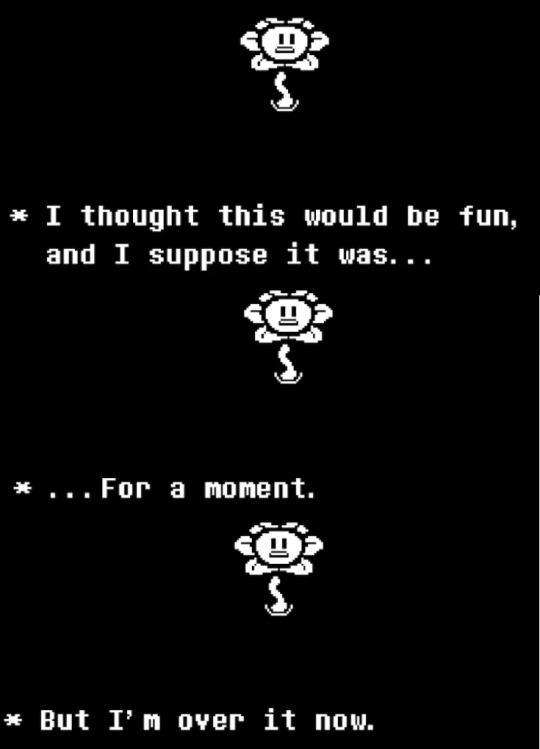
So what would have been better? Personally, I think the first phase of the fight is largely fine as-is. Phase 1 is by no means without its flaws, but it’s the phase that’s most relevant to Clover and the overall story on a thematic level—the boss attacks are a consequence of Clover’s actions and the vine chases (though repetitive) are meant to symbolize Clover’s endlessly repeated runs. And the thing is? The pieces are already there for the fight to end in a more natural way that respects the player’s time.
If the fight were to be given a page 1 rewrite, then I would end it at the section with Flowey’s subconscious that shows his past. Why?
It’s a great scene on its own that should be kept,
The scene would actually be relevant to the fight instead of it going unremarked on like it currently is (seriously, Flowey has nothing to say about it?),
It would fit the central conceit of the fight—Flowey is able to peer into Clover’s memories but Clover can do the same to Flowey and that scares him, and as a result...
It would be a more believable and character-driven “off ramp” for Flowey to back out of the fight.
This last point is especially important because we see throughout Undertale Yellow that Flowey is constantly hiding from other monsters—he clearly doesn’t want to entangle himself with them or have them interfere in his affairs. We can also pick up from his dialogue in Undertale and, to a lesser degree, Yellow that Flowey doesn’t want to talk about his past life as Asriel.
Having Clover intrude upon that territory would likely spur a strong reaction from Flowey, to the point where he’d rather abandon his plans, albeit temporarily, than open up that side of himself to a stranger. This would not only make the fight shorter and end it on a more emotionally resonant note, but I feel it also makes more sense for the narrative and themes of Yellow.
Flowey’s rationalization for letting Clover go could be something to the effect of needing to “tidy up” his head space before he’s ready to share it with someone else. Perhaps in the process he could drop a hint that he’s only opened himself up like this once before (with Chara) or that he had thought he had buried those old memories for good.
I also feel like this explanation would work better in the greater context of Flowey’s actions—Flowey quitting the fight out of boredom raises the question of why he’d repeat the fight on future neutral runs or why he’d be so confident that he could absorb the six souls in Undertale if one was too stubborn for him. Instead, having Flowey be emotionally unprepared for his plan but trying to find a workaround would lend itself better to him trying again in the future—to him it was just a little slip-up that he can overcome with enough attempts.
I don’t want to give the impression that my critique here is “the Flowey fight wasn’t done the way I’d have done it, therefore it’s bad.” My suggested “rewrite” to the fight is merely piggybacking off of what was already there, which are great concepts that I could never have dreamed up myself. The problem is that there’s just too much. Way too much. It feels like not enough was cut during the planning stage and what we’re left with is the epitome of “less than the sum of its parts.”
Of course, my rewrite omits the 2nd phase entirely—something that couldn’t be done with the current fight since it’s the most visually stunning segment of the entire game—like it or not, that genie is out of the bottle.
If I had to give any suggestions to improve the fight that we currently have? I’d say that I don’t think the “afterlife” portions of the 2nd phase need to be repeated so often. I think the phase would be better paced if afterlife only occurred at the very beginning and very end, and instead each mini-phase just brought you right back to Flowey’s petal roulette wheel to take you into the next mini-phase.
None of this is to say that I hated the Flowey fight overall. I still love many of the concepts that the fight brings to the table and I’ll watch moments of it on Youtube from time to time, but I just don’t care to experience it again firsthand any time soon, which is pretty much the opposite of how I felt with the Omega Flowey fight.
Looking at Yellow’s final bosses now that I’ve completed them all, I think my favorite might actually be Zenith Martlet? Which is insane to me because I hated that fight the first time I tried it—anyone who shared a Discord with me can attest that I was complaining nonstop when I attempted that fight.
Even now I’d say the Zenith fight is sloppy and the bandaid solutions for it in the 1.1 patch only illustrate how unbalanced this fight originally was. I’ve never beaten it on 1.0, nor do I intend to, yet in 1.1 I’d say I probably enjoyed myself the most with this fight. It doesn’t overstay its welcome like Flowey, nor does it have anything as egregious as the Kanako cutscene in the Ceroba fight. It respects my time, it has great music (though that’s par for all the bosses), the attacks (while chaotic) mostly stick to a consistent handful of themes, and the narrative context of the fight works (minus the bit with Alphys’ lab).
At first I found the Zenith fight unfitting for Martlet as a character. I thought “what? Martlet isn’t some hidden badass,” but that was exactly the point—this isn’t who Martlet is, and reality catches up with her. The 2nd phase is my favorite part of the fight as we see, in typical Martlet fashion, she didn’t plan ahead and can only hopelessly flail about as the “enemy retreating” motif overtakes her theme. It’s a somewhat understated and undignified ending to the character and that’s exactly what makes it work—it’s another example of the game showing restraint and being all the better for it, as opposed to overreaching.
That said, if I wanted to cheat, I’d say my real favorite final boss is the Asgore “fight” from the false pacifist ending. It’s focused on the characters and their goals and it doesn’t try to be anything too flashy. It’s an even more understated yet fitting final boss than Martlet, though the rest of the “false” ending outside of Asgore is a bit lackluster since it’s just a glorified neutral ending.
Conclusion
To wrap things up, I’m sure you’ve all noticed the throughline here: Undertale Yellow is at its best when it’s tasteful and restrained, and at its worst when its ambitions run wild. Of course, that’s easy for me to say from the outside looking in. It’s likely that many of the things I enjoyed about Yellow were ambitious in their conception but were handled carefully enough to appear restrained and effortless. I have no intention of downplaying that—the project as a whole was ambitious, given the time and effort lovingly poured into it.
As I mentioned in the beginning, my criticisms are not intended to dissuade anyone from trying this game. I would not want this game to be forgotten, but I also would not want it to be uncritically praised as some flawless masterpiece that eclipses the original game—that not only does a disservice to the people who worked on Undertale but also to the people who worked on Undertale Yellow. Both games were carefully crafted and both games have their triumphs as well as their flaws.
The last thing that I would want any fan creator to take way from Undertale Yellow OR the original game would be “this was perfect, just copy what they did.” What’s important is understanding why things worked and where they could be improved. Despite Undertale Yellow’s reverence for Undertale, it takes risks and finds places to innovate over the original game. Not all of it works, but I can respect the effort.
And that sums up my overall opinion of the game—it’s a game that I like but a game that I respect even more. The best complement that I can give is that even the parts of the game I didn’t like still had good ideas evident within them. The pieces were there.
With some tweaks, fine-tuning, and the courage to reign in a couple aspects, I honestly think this game could be made to rival the original one day. But even if that day never comes, Undertale Yellow is still a fine game as-is. It’s not a game I consider “canon” like some fans have argued, but I still plan to replay it alongside the original in the future, and I can’t think of higher praise to give than that.
105 notes
·
View notes
Text
TL;DR: My analysis of the quiet tone of the Cherry Magic movie -- the overarching theme of the movie was the development of family between Adachi and Kurosawa.
Well, I’ve turned this space temporarily into a Cherry Magic hovel, a kind of messy sanctuary, really, maybe a cave full of hoarded passing thoughts, rising and cresting emotions, lots of SIIIIGGGHHS, at least two and a half re-watches of the movie, many reblogs, plummeting away my phone battery on consuming more and more gifsets. I regret not being here on Tumblr for the original series, but I feel like I’m more than making up for it by doing all I can to contribute to the dialogue around the movie, which I want to continue doing, meta-style!
Two things have cropped up in my reads of reviews here and on Twitter, one about the tone of the movie, and the other about the pace of growth between Adachi and Kurosawa. I think the first point goes into the second, so here we go:
I’ve seen a lot of comments about how the movie was quieter than the series. I reblogged a quick statement on quiet Japanese BLs earlier this weekend, and I also learned a bit about what the OG CM fandom hoped for with the original series way back when, when there were rumors of a real kiss for the final episode, and how the fandom was slightly let down.
I think there’s an interesting dichotomy between heat and quiet in the kind of Japanese BLs I tend towards. If you read this space, y’all know my top three -- CM, Kinou Nani Tabeta, and Old Fashion Cupcake -- generally trend toward the quiet, with the slight exception of OFC, which turns up the heat in a panicked moment of revelation.
As I thought about this point, I asked myself -- why the draw towards quiet development and/or contemplation?
For me, all three of these dramas, especially KNT, center on family -- actively creating family, dealing with existing family, and/or managing expectations of creating a future family.
If you’re Asian, as I am, the thinking on and managing of family issues is, in my opinion, the dominant issue that you spend the majority of your life dealing with. That’s not to say that in Western lifetimes, less time is spent on family issues. What I mean to say is that family issues, I would argue, take up more of your brain space and your sense of morality and ethical engagement in humanity if you’re an Asian, as opposed to the manifest destiny of the West. When I was right out of college, for instance, and rolling with a majority white hipster crew at that moment, my friends would comment on how I’d visit my family’s house once a month. That was tooooo much for them. And they’d legit tell me -- you care too much about your family, you need to separate yourself from them.
These are surface-scratching statements, and if you’re Asian, I know you’ll immediately guffaw at how ridiculous and impossible it would be to even BEGIN contemplating how to “separate yourself” from your family. It’s taken me a LOT of my old lady years to even come to grips with the fact that I needed to live an independent life away from the expectations of my family. And for hundreds of millions of people in our Asian cultures, those Western notions of “separation” and “independence” simply don’t exist. You can cohabitate, be co-dependent on, be enabled by your family, and that is just fine. Family is the structure that gives meaning to the lives of many Asians, without question.
So to say that the movie tends towards the quiet, I think, possibly bypasses what I think is a major point that the movie is trying to make, both in a cultural arc and in the actual storyline: We are seeing Adachi and Kurosawa making a family together, THEIR family together.
IMHO, the king of family-oriented BLs was KNT. Both Yoshinaga Fumi, the mangaka behind KNT, and Adachi Naoko, KNT’s screenwriter, deliberately gilded the KNT script with the tadaima and okaeri greetings that you hear when someone comes home at the end of the day. That set-up was meant to indicate that Shiro-san and Kenji considered themselves family to each other -- because, you might be saying tadaima to your parents when you’re a child, or your spouse as an adult.
The clues to Adachi’s thinking about family are apparent. There’s the moment where he gives advice to his chief about the chief’s complaining wife. There’s the moment in the office when Rokakku and Fujisaki are talking about their lives, the very moment in their lives where they are single but happy at work and with friends. There’s the moment when Adachi picks up the mail and sees his name and Kurosawa’s name, while coming home.
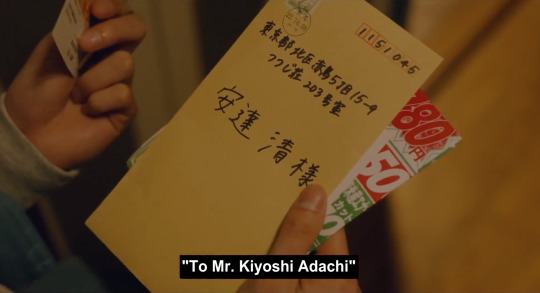


And of course, the gorgeous moment in the kitchen when Adachi states his desire for a public and permanently committed relationship with Kurosawa.


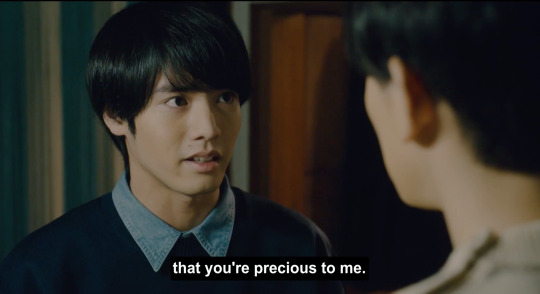
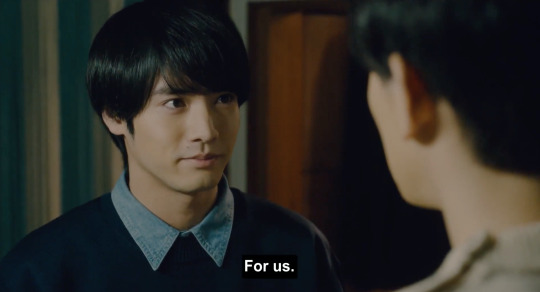
Adachi is creating his new family in that moment.
I want to tie this together with a comment I read on Twitter about how Adachi’s personal growth matched Kurosawa breaking down his walls of perfection, and how he originally projected his perfectionist nature on their relationship. We remember in the series Kurosawa being ULTRA cute in the office after Adachi’s original confession, saying he was going to create the best first date ever; and then all the practice dates they had; and all the planning that went into the Christmas date.
Those walls began breaking down a little bit in the last episode of the series, and we saw that even more as the movie began, when we realized that they had not, indeed, bonked, as we thought they had, on Christmas Eve. When Adachi’s hunger interrupted their potential love sesh, Kurosawa was like, WEEEEELLLL, through gritted teeth -- I’ll still be patient for Adachi.
That’s life. But as I originally wrote in my first review of the movie, what I didn’t expect to see in the film was that the movie would be utterly dominated by Adachi’s internal growth INTO the relationship, and how that ultimately steadied Kurosawa to be okay to be weak in front of Adachi, and in his own (Kurosawa’s) life. We know this is a HUGE DEAL, a HUUUUGE DEAL for Kurosawa. He mentions it in the essay he writes for Adachi’s family. He states it as a major point of being devoted to Adachi to his (Kurosawa’s) mother. Breaking down his walls is a major life moment for Kurosawa -- and it would not have happened without Adachi becoming his family.
Because -- family, often, is about rejiggering and redefining one’s boundaries, and creating new ones with the people you’ve chosen. If you’ve chosen well, and right, like our boys did, then your partner gives you the strength to do this major lifting.
AND: where else do we see these boundaries being rejiggered, besides between Adachi and Kurosawa themselves?
We see them in the family scenes. I think that the movie devoted a LOT of time to the family scenes says a lot about what I said earlier about Asian cultures.
I swear to jebus that I nearly had multiple heart attacks during the family scenes. Besides Kurosawa’s mom’s very apparent sadness and confusion, Adachi’s mom had me at moments, even though she outed herself as a fujoshi, basically, lol, when Kurosawa showed up. Why the heart attacks?
These confronting kinds of conversations to family about things like marriage -- I mean, I don’t know if I have the words to describe HOW MOTHERFUCKING HUGE THESE CONVERSATIONS CAN BE FOR MANY ASIANS. Like -- these conversations can be the culmination of a lifetime. They can destroy you. Y’all, if I wrote about what happened to me when my family learned I was dating my husband (in a cishetero relationship, peeps! Interracial and interfaith, yes, but otherwise, not really rocking the boat here!), I probably wouldn’t finish writing without breaking down in tears for an hour. It was horrible. My family couldn’t handle the growth, simply put.
This Asian family dynamic that an individual’s original nuclear family unit carries SO MUCH WEIGHT IN THEIR APPROVAL OF WHO YOU ARE AND WHAT YOU DO -- I emphasize here that this theme was major in the movie. The movie NEEDED to spend time on this in order to achieve Adachi’s dream of permanence with Kurosawa. Adachi NEEDED to tell Kurosawa that he (Adachi) would be present in front of Kurosawa’s parents -- because Adachi KNEW that Kurosawa would NEED Adachi there, because of how BIG that BIG CONVERSATION would be. I’m talking BIG, here, BIG. And I believe that the movie’s OG Japanese audience understands this very implicitly and very, very deeply.
Adachi NEEDED to grow into himself -- he needed to lose his magic, his crutch -- and needed to FIND himself to be the strength and pillar that Kurosawa would need to face his family. I want to take this point, make it into a Cherry Magic teddy bear, brand it with Gelato Pique, and place it on a mantle.
In order to face their families, our guys needed to become family. And that’s why I think the movie tended towards the quiet -- because THAT kind of growth takes a lot of internal work that comes out in the quiet moments of intimacy with the people you’ve chosen and you love.
#cherry magic#cherry magic meta#cherry magic the movie#cherry magic the movie meta#adachi kiyoshi#kurosawa yuichi#akaso eiji#machida keita#adachi x kurosawa#kurosawa x adachi#kurodachi#asian family dynamics#asian family culture#family boundaries#asian families
159 notes
·
View notes
Note
can you be a teenager and be polyamorous?
this sounds like a silly question, but can i explain real quick-
so i’m, ofc, a teenager, and i’ve never actually been in any kind of romantic relationship before, or even kissed anyone - not that i don’t want to, my parents are just homophobic - and idk, i think i’m polyam, but… like, am i allowed to be, if i’m a teenager? i’m ace and i already know i don’t want any kind of sexual relationship w/ anyone, and i know that polyamory is often only seen as a sexual thing by a lot of the general public, so maybe that’s why i’ve seen so much stuff online saying that kids can’t be polyam as it’s inherently sexual (i don’t think it always is), or the classic ‘they’re too young to know’ but i just feel like they’re right sometimes, like, i haven’t had the experience and years and stuff that adults have had, and that makes me feel like an idiot for even wanting anything to do w/ this part of the community.
except… it’s like. when i think of being older and married or in a relationship, i always think of it being someone who’s not a man (i’m a nonbinary lesbian), but like, i also think of it as more than one person? like. i’d be happy w/ two wives i think. or a partner who has a partner, that i’m not dating, esp since i’m ace and not of course everyone else is and everyone has different needs wants in a relationship. and while these are obviously just thoughts, i’ve also put. like. a lot of thought into it, and the traditional relationship structure (monogamous man/woman) doesn’t really seem like something that work for me. like also bc i’m aro and i could have a qpr but i wouldn’t mind if it was w/ more than one person or if my partner had like a date or other qpr partner or like… you get the gist. not even ‘wouldn’t mind’ i think it’d be neat, like the traditional relationship structure just never felt like it was right for me.
idk, i’m sorry, this ask is so incoherent. i just. wanted to know if i could be teenage and polyam, or if there’s something wrong w/ me and my thinking for wanting to be so, like i honestly don’t know if there is, and it’s not great sometimes, wanting to use a label for yourself in your head and not knowing if you… can
TL;DR (and it will be long): you can be whatever you feel, at any stage of life, forever. So, yeah, it could be other things, but if that's how your feeling, it doesn't really matter if you change your mind later. You can be it now.
So here's the thing: you do have a lot going on. All teenagers do, and as much as adults condescend to teenagers about it, the only way to figure it out for you personally is for you --personally-- to stumble through it. And you're clearly a bit overwhelmed. That's chill and normal. As stressful as it is, try not to stress it; these are all things that will be okay once the dust has settled.
When I was a teen, I didn't want to touch anyone. I thought I was ace. I barely even wanted a romantic relationship. Now I want several high-sex romantic relationships. I changed in that. I haven't changed in other ways, such as not wanting kids. Everyone told me I'd want them eventually, and here I am as an established adult, happily childless.
If you think you're poly now, you're allowed to call yourself poly! If you wanna say you're "questioning poly" or "interested in exploring" poly that's fine, too, in the same way bi people sometimes go "I'm mean I'm pretty sure I'm bi because my gender people SO HOT but some days I'm not feeling it and I've never actually had gay sex soooo for now I'm just going to call myself bicurious". And a lot of people will probably tell you you're too young to know, but that's not going to change how you feel. Maybe you'll grow in a different direction. Maybe you'll have a 10 year headstart on happiness that everyone on poly forums wishes they had. Both of those things sound fine to me. Those are both 👌👍✅ outcomes.
You can also want all those things and not consider yourself poly. Maybe you're just meant to join a commune 🤷
The point of labels is for you to be able to describe your experience, not to define you. If you think "poly" is an adequate word to describe the experience of "ace but wanting to build my life with multiple close women" then go for it! You could also describe yourself as other things to other people. Like, if you're in a very queer environment like Tumblr, you might feel comfortable saying "I wanna be in a poly lesbian QPR!" but to conservative adults you might just stick to "I'm not looking to get married too quick, its just going to be me and my best girl friends for awhile!" and to someone who's trying to understand but really isn't getting it you might choose to describe it as "I'm trying to found-family-trope my life. Like, we're not sexual, but we're everything for each other, you know?"
So I guess to wrap this up back to you initial question: "poly" isn't inherently sexual, and you can use it to describe anything you think it applies to, yourself especially. However, it may carry that connotation with others, so it might be a lot of trouble (up to you whether its worth that trouble) to identify yourself as that to those people. In your own head? do whatever the fuck you want lmao I'm not the thought police🚫🚓
Use them terms -- "poly" included -- when they suit you. Be that the current mood, the current conversation, the current stage in life, whatever.
#ask box is always open#I don't feel like I kept the thread here super well but you know what I'm getting at
13 notes
·
View notes
Note
feel so so free to ignore this but I saw in your tags you had some IF concepts with Pacific Islander ROs in mind 👀 I am eager for details (on the IFs or the ROs) but no pressure!!!
It's fine. Because they will probably stay concepts forever or become linear stories (because coding intimidates me), but there is a small part of me who dreams.
The first character is gonna gender flippable (even though I dislike that word. Is there another word?): Naomie/Noel -> Naomie Tikaram (F, she/her) and Noel Tikaram (M, he/him). FCs: Veronica Pome’e and Nemani Nadolo.
They're 6'3" and thick, because that is important to me. I don't remember where I said they're from but they're mostly raised from their teen years in an AU!Haiti. Basically the concept of the story is a Haiti that was never charged to pay back France or was never fucked up by America or the UK, etc. And the concept is lowkey Kings (except I haven't seen Kings, yet, so what I imagine Kings is). There's a prophecy, MC is the "chosen one" ... except not. Sorta, yes. They're connected to two other characters, tl;dr it was born of my desire of wanting more IFs that dealt with politics and corruption but in a sorta Shakespearean like vibe (where's my the Borgias IF? Where's my Scandal remake? Where's my kingmaking! Where's my Xanatos speed chess!)
N (haha) would definitely be one of the RO options and definitely the Lionheart to MC's King. To quote a friend, N's vibe was meant to explore a "character born into violence being thrust into the sudden gentleness of love." Even for a MC not romantically interested, the vibe is meant to be platonic life partners. Regardless if whether or not MC liked them, they're MCs guard and the direction of the story/MC would probably be inspiration for N.
A snippet from my ramblings: What Initially Attracted Them to Their Partner?: Salvation. I almost said hope, but differently than Danys. With Danys MC was light, fun, and even brightness. A joy. For N, MC is a saving -- from the mundane, from the past, from a lack of direction. It’s like MC is both a fixation and a fixed point. A part of them was drowning and MC was the hand that stuck in to grasp it.
-----
My second character is from a story more likely to definitely end up linear (mostly because I'm thinking it might actually be more interesting as a regular story/book). Basically, it is magic as a metaphor (the first one is too actually but also will probably have far too much Catholic undertones, soz. Not soz. I did say Kings.) but for growing up when you're in your 30s. So many IFs (and STORIES IN GENERAL) have people in their 20s and 30s and they're TOGETHER. Or if they're not it's ... in a, IDK secluded way? And basically this story is about a bunch of 30 somethings (and one 20 something. And one ancient being), who are figuring out their issues and life and the various ways they've disappointed their families / their families have let them down. And while a couple are successfulTM job wise ... in other ways ....
NEWAYS.
Isaako Malaitai. My trash baby. Isaako is what happens, in short, when you let misconceptions fester. His Character Sketch -> He definitely gets misconception as rough and “dumb”, and I think he plays that up. But he’s actually REALLY clever. And maybe even a businessman (maybe he’s the underestimated son).
In truth, his very clever but people just see him as the party guy. Charming but an asshole/catty. When he actually has more heart to him. (Though the only living person [he has dead parents issues, if I recall right] who knows it - or rather BELIEVES it - at the start of the story is probably his BFF Ariel.) He’s either gonna be the “bad guy” or a decoy to the actual bad guy (who I’m pondering is being his sibling. Basically MC inherits a B&B that’s connected to this magical hot spot, and it draws all the characters to it. Most of them are non-human, but I don’t know if they know it yet.)
Anyway, Isaako is partially Samoan and fc is Roman Reigns (but suited up Roman).
Hope this were satisfactory details! But I’m starting to nod off.
#plasticdodecagon#grapecase answers#thanks for asking!#i always love talking about my ideas#(jk thats a lie)#... sometimes#.... kinda#oc: noel/naomie#oc: isaako malaitai#<- if you wanna creep their tags#i dont have a lot of thoughts on them. just vibes#grapes chars#im hoping that isaako's culture is very relevant to him -- at least via magic#it will be likely more so than Ns -- though I would like to do very subtle touches for N#but again WE. SHALL. SEE#this is making me want to go through their tags and their pinboards tho ...#so thanks <3#lmao
3 notes
·
View notes
Note
holdon he’s a villain? i thought iru was just token comic relief manwhore
Sound of me falling up the stairs and then down again like I’m a character in a ytp
TL;DR he is definitely a villain but also comic relief somewhat depending on the situation at hand. More in-depth explanation under the cut.
Yes he is a villain. He’s not intended to be taken seriously in a personal sense or have the usual “evil” vibes, but he is very much a villain in all lives but his own and Lon’s. Sure he’s basically an incel, yes he has no sense of style, no he doesn’t exactly behave in ways befitting someone who knows he could very easily take down most who oppose him. The thing about Iru is that he thinks he’s entirely right and that the world is always logical and everything happens for a reason. He rationalizes things by making the world seem like it fits his thoughts, not by changing his thinking to be true to life. If something bad happens to him it’s almost never his fault, while if something good happens to him he simply earned it. In other words he’s very much the hero of his own story, and while those working against him aren’t necessarily villains in his eyes, he’s still the protagonist and always needs to win for the greater good. He finds as many ways to justify his own actions as he needs to.
What happened to him wasn’t a consequence of his actions, everyone else just hated him for no reason. He was guilty until proven innocent, but they never even gave him a trial. If Umbramakers were considered expendable enough to decommission and deconstruct on the government’s whim, there’s nothing wrong with him thinking so as well. So, if he wanted a part more, it was his right to take it, even if it meant doing the removal himself. Since it probably would’ve happened later he’d just be speeding up the cycle a bit. It’s fine that he’s been living entirely at the expense of others even before he became organic, because survival of the fittest is just how the world works! It’s not his fault that he’s the winner in such situations, maybe others should just stop being losers. Sure, murder isn’t great, but someone else’s deadly misfortune could just be his good luck nowadays. If the universe wanted him to starve someone wouldn’t have happened to wander into reach when he was feeling hungry.
Iru can’t deal with the idea that sometimes things aren’t that deep, so he simply doesn’t. It’s not that he just makes up explanations for everything, except that is pretty much exactly what he will do if he needs to “rationalize” something complicated. Jumping to conclusions and grasping at straws and stretching the truth and blurring the lines between right and wrong is all fair if it explains or gives reason to the situation. Well, the situation as he personally views it. Truth is subjective, someone else can think he’s a terrible person just as much as he thinks they’re pathetic and jealous of his successes. And because of that, there’s very few situations where he can’t bullshit his way into doing whatever he wants under the impression that it’s ok. This isn’t something he hides, either, he’s usually a pretty open book and genuine in most of what he does.
That’s part of why he can seem nonthreatening or even kinda pathetic at times. If he’s going to be a threat he will, but if not he won’t. Intimidation is generally pretty intentional on his part, but so is being casual or nonchalant in most other situations. He gets caught up in his own feelings because that’s just how he is; someone bullying him online is something he’d take personally. If he sounds offended or insulted it’s because he is offended or insulted, regardless of how minor the reason is. He’s rarely going to surprise someone(if his goal isn’t to do that in the first place), which leaves a bit less room for suspense that might otherwise make him seem worth taking a bit more seriously. He’s not necessarily predictable, but he is consistent.
In that regard he’s a bit of a foil to Lon, who will do things they know aren’t ok because they don’t care. They could stick to hunting animals and not people, but hunting people is more fun. They couldn’t give less of a shit about what impacts their actions have on strangers. “I felt like it” is a perfectly reasonable explanation for doing something in their mind. They have nobody else’s will to live under but their own, so why make up random or irrelevant limitations for what they can and can’t do? They’re unpredictable because they’re hard to get a read on most of the time. If they seem to feel a certain way about something you can never be entirely sure that’s a reflection of their true emotions. Even when not outright pretending to be someone else entirely, they’re far from open or outgoing, and they don’t readily reveal much about themself. They’re someone to take seriously because underestimating them is exactly what they want people to do. They don’t have much morality to hold them back.
In a way, they’re the lawful chaotic evil to Iru’s chaotic lawful evil: “I can do what I want, but I’m just gonna stick to benefiting myself, and whether or not it’s at the expense of others doesn’t really matter so long as I get what I want” vs “I have a moral code that I follow because I don’t want to do unnecessary harm, but I’ll also rewrite the rules if it would help me, and the rules don’t say anything about not causing harm if there’s enough motivation to do so anyways”.
#asks#rambling#my characters#iru#lon#basically being a villain and being comic relief aren’t necessarily mutually exclusive#what matters is how they’re balanced
3 notes
·
View notes
Text
That Dark!Madrigals Hot Fuzz Sorta-AU I Keep Mentioning
As I’m not sure I’ll ever actually write it: it’s basically the plot of the film Hot Fuzz with Mirabel as Nicholas Angel and Antonio as Danny Butterman only they’re not cops they’re a young woman who has studied psychology at university and a child who can talk to animals. TL;DR the Encanto is the best and most peaceful and charming village in all of Colombia and the Madrigals do everything they can to keep it that way. This means helping to clean up after nasty accidents which sometimes befall the citizens resulting in their tragic and ironically gruesome deaths. Mirabel comes home from college and...has questions.
Here’s the entire outline minus “spoilers” which is hilarious because again I have no idea if I’m ever writing this. Note that if I DO write the thing there are even odds your fave will be a stone-cold killer (except Antonio, I promise nothing bad will ever happen to this precious child):
The Hot Fuzz AU No One, Not Even I, Asked For
CHAPTER 1 - It Would Appear the Heavens Have Opened
Mirabel comes home from uni in Medellín and starts to realize that things may not be as perfect as she thought. The town seems happy and her family is ecstatic over a fourth generation receiving a gift. Everyone is eating cake. There’s the usual fixation on everything needing to be perfect, but from her studies Mirabel is starting to wonder if this is healthy.
CHAPTER 2 - It’s Just The One Hippo Actually
There’s been a hippo sighting. No time to worry, though, because Camilo and Antonio want to show her around town and drag her to the cantina to chill out before things get weird. Meet a bunch of townies, most of whom are about to die.
CHAPTER 3 - Decaffeinated?
…starting with the starring actors in the play they’re putting on to celebrate the upcoming ceremony, who get their heads lopped off. Mirabel is horrified, everyone else thinks it’s ~just an accident~. Some vines get trimmed by the river that shouldn’t be, Antonio, Mirabel, and Isabela investigate.
CHAPTER 4 - Nasty Way To Go
A local businessman is blown up. Accidentally. Mirabel grows increasingly concerned and starts throwing around the M (murder) word, Antonio reassures her that all is well. Then a journalist is crushed and tensions rise, but Julieta promises her daughter everything is fine. Nothing is fine at all.
CHAPTER 5 - You Don’t Know How To Switch Off!
Mirabel’s use of the M word becomes an issue among the family. Her mother and Tio Felix do their best to reassure her, Abuela is in full denial mode, Antonio tries to see her side but can’t quite get there, and despair starts to creep in. The village florist has An Accident.
CHAPTER 6 - This Shit Just Got real
Mirabel absolutely loses it, has a confrontation with Luisa, and makes her way to Castia’s basement. Confrontation when she reemerges! She is murdered by Antonio’s jaguar.
CHAPTER 7 - Judge Judy and Executioner
Or not, because Antonio is the best twelve-year-old protagonist ever. He and Mirabel formulate a plan to sort this absurd story out. Who can they trust? Who must they stop?
CHAPTER 8 - The Greater Good
Mirabel, Antonio, & whatever allies they’ve acquired kick so much ass. People might die! Horribly! But at the end of the day justice will be served.
Chapter 9 - A Hell Of A Lot Of Paperwork
It’s all over, OR IS IT? One last villain needs to be put out of commission, and then an epilogue can be enjoyed.
#the greater good#encanto au#i want to write this for six or possibly seven words#but it will probably just lurk in my head#forever
6 notes
·
View notes
Text
my proposal for tropes we as a fandom should adopt in all fanworks going forward: Duke Thomas edition
So every fandom has tropes and characterization quirks that have been generally accepted into fanon and, like, maybe? they were originally based on some obscure comic panel from the 80s or something but it doesn’t really matter because we’re all just,,, cool with it? Like for example- in the dc comics fandom, an art piece could show 3 of the bats that look virtually identical except one of them is holding a box of cereal so that one is obviously Dick Grayson. . . Y’know?
Anyway, these things usually come up naturally I guess but I’ve been here a while and it’s finally time to put my foot down. It’s high time for Duke Thomas to be more in fanon than “the sane one.” Because he might be the relatively new guy but he is certainly fears no gods or laws of the land just as much as the other bats, lemme tell ya.
TL;DR here are character quirks (”canon-based” or otherwise) that we should all really latch onto seriously I’m begging y’all to make at least one of these happen-
Duke “Habitually Jumping Out of Moving Vehicles” Thomas
This one’s actually based in canon y’all; Duke did indeed yeet himself out of the back of a cop car and off of a bridge (in We Are... Robin). Normalize Duke’s wearing knee and elbow pads as Signal because jumping out of a car turns out relatively fine once and then suddenly Batman’s rooftop disappearing act seems mellow compared to the amount of times Gordon has whipped his head around to see a now Signal-less backseat.
Like, he’s going 60 mph?? And he didn’t even hear the door open?? and tHE DOORS ARE STILL LOCKED??
Imagine this leaking into civilian life and Bruce waking up to a blurry photo of Duke mid-escape from a limousine on the front page of the Gotham Gazette.
(more under cut)
Duke “Puzzles are my Passion” Thomas
Duke is ~canonically~ very skilled at both solving and concocting riddles (as a child during that time where The Riddler just,,, controlled Gotham, he worked non-stop on riddles, trying to make the perfect one). Please y’all- let Duke solve puzzles. Have the other bats ask him for help after 36 hours straight of brooding over some brainteaser that Duke works out within the half-hour. He texts a picture of the solution scribbled out on loose leaf in the margins of his pre-calc homework because this boy shows his work.
My guy is a word-cross FIEND. A mind-sweeper speed-runner. That guy who mails into the Gazette to correct a solution in the “fun & games” section and also ps that photo is not of me I am simply a polite young man who is much too busy writing into the paper in the year 2021 to jump out of limos-
I also would love to see this integrated into the type of cases he investigates / runs into on his daytime patrol. Like, obviously the criminal activity is going to dramatically differ before and after sundown, but that doesn’t make Duke’s work any easier or less important. It’s a different skillset; he has to work differently. Instead of jumping into fights, halting mob meetings, saving civilians in dark allies, etc. Duke has to sort through all of the moving pieces before they all converge into something catastrophic.
It’s a known fact that criminal organizations in Gotham make and execute a lot of behind-the-scenes plans during the day specifically not to run into the bats. And Duke knows and monitors this shit all by himself; his work is crucial to logistics and information gathering for the bats as a whole. Now criminals have like, a 2 hour gap between bat-shifts to try and get stuff done. But Duke would 100% set traps on timers or lead them on this pre-set convoluted goose chase to distract them until the night bats come out and to let himself enjoy the whole thing playing out on the news while he finishes homework that’s due at midnight.
Duke “I Know a Guy” Thomas
So in going off of the basic concept for the “We Are. . . Robin” run in combination to his general likability, Duke has a lot of friends all around Gotham. Okay, sure, he doesn’t have a Super best friend or a Speedster on speed dial, but he does know this guy who details cars up on West 35th and will tell them all about the new mods on Black Mask’s transport vans if they come through the third floor window and bring takeout.
Bruce and Tim will be waiting for the facial recognition software to identify at least a partial match off of security cam footage when Duke pulls into the cave, takes one look at the screen, and says “Oh, that’s <insert name, address, abridged life story, and known associates here>.” This also brings in the opportunity for Duke to have some sort of perfect recall for faces, voices, names, etc. which I think could be a really cool element for his position as the batfamily member who has a lot more personal interaction with the people of Gotham.
I’m also into the idea of a lot of people knowing/telling stories about Duke. Not to reference the Chuck Norris meme but almost like the Chuck Norris meme lmao. Think about Jason mentioning his brother to someone and she replies, “Duke Thomas? Like that Duke Thomas? The one who swam across the harbor because he said it’d be faster than the subway and it actually was?” These stories have varying levels of truth to them but Duke will never confirm nor deny when he gets random calls from family members yelling “you dID WHAT”
So those are my top three, and the following is a little speed-round of headcanons :)
Duke has a super expressive face. Like when he’s relaxed around family, you can tell exactly what he’s thinking and how he’s feeling by his visual reactions to things
Duke rotates through picking up new and revisiting old hobbies at a pretty rapid pace. Some hobbies include: bullet journaling, origami, viola, cello, synth, conversational basics in multiple languages, up-cycling and embroidering clothes
Duke has a really fucking adorable smile. He can’t help it. He’ll try to grin sarcastically or smug to be annoying but his smile just cannot be anything other than endearing. He also has a very specific booming laugh that’s an absolute treasure to hear, because it’s the most genuinely happy thing ever.
Duke unironically enjoys Signal by Twice even though the first time he heard it was after Steph had set it as his morning alarm.
So.
Come and get your food, I guess.
Feel free to add on if you’d like! I’d love to see anything you guys write/draw/etc. based on anything from here if you feel compelled to do so!
Stay safe and be well :)
#duke thomas#the signal#signal#batman#dc comics#duke thomas fanfiction#duke thomas headcanons#dc#batfam#batfamily#batfamily fanfiction#dick grayson#Bruce Wayne#Tim Drake#Stephanie Brown#Jason Todd#gotham city#Duke Thomas-wayne#i love him your honor#headcanons
2K notes
·
View notes
Text
coming back to this post i made again to elaborate - especially as the ted lasso fandom is discussing sam/rebecca and fandom racism in general. there are takes that are important to make that i had failed to previously, but there's also a growing amount of takes that i have to, As A Black Person™, respectfully disagree with.
tl;dr for the essay below sam being infantilized and the sam/rebecca relationship are not the same issue and discussing the former one doesn't mean excusing the latter. and we've reached the glen of the Dark Forest where we sit down and talk about fandom racism.
i should have elaborated this in my last post about sam/rebecca, but i didn't. i'll say it now - i personally don't support sam and rebecca getting together for real. i believe what people are saying is entirely correct, even though sam is an adult legally, he and rebecca are, at the very least, two wildly different stages of life. for americans, he's at the equivalent of being a junior in college. there are things he hasn't gotten the chance to experience and there are areas he needs to grow in. when i was younger, i didn't understand the significance of these age gaps, i just thought it would be fine if it was legal, but as someone who is now a little older than sam in universe, i understand fully. we can't downplay this. whether or not you think sam works for rebecca or not, even despite the gender inversion of the Older Man Younger Woman trope, whether or not he is a legal adult, i don't think at this point in time, their relationship would work. i think it's an interesting narrative device, but i don't want to see it play out in reality.
that being said!
what's worrying me is that two discussions are being conflated here that shouldn't be. sam having agency and being a little more grown™ than he's perceived to be does not suddenly make his relationship with rebecca justified. i had decided to bring it up because sam was being brought into the spotlight again and i was starting to realizing that his infantilization was more common than i felt comfortable with.
sam's infantilization (and i will continue to call it that), is a microaggression. it's is in the range of microaggressions that i would categorize as 'fandom overcompensation'. we have a prominent character of color that exhibits traits that aren't stereotypical, and we don't want to appear racist or stereotypical, so we lean hard in the other direction. they're not aggressive, they're a Sweet Baby, they're not world weary, they're now a little naive. they're not cold and distant, they're so nice and sweet that there's no one that wouldn't want approach them, and yeah, on their face, these new traits are a departure and, on their face, they seem they look really good.
but at a certain point, it reaches an inflection point, and, like the aftertaste of a diet coke, that alleged sweetness veers into something a lot less sweet. it veers into a lack of agency for the character. it veers into an innocence that appears to indicate that the person can't even take care of themselves. it veers into a one-dimensional characterization that doesn't allow for any depth or negative emotion.
it's not kind anymore. it's not a nice departure from negative stereotypes. it's not compensating for anything.
it's patronizing.
it is important that we emphasize that characters of color are more than the toxic stereotypes we lay on them, yes, but we make a mistake in thinking that the solution is overcorrection. for one thing, people of color can usually tell. don't get it twisted, it's actually pretty obvious. for another, it just shifts from one dimension to another. people of color are still supposed to be Only One Character Trait while white people can contain multitudes. ted, who is pretty much as pollyanna as they come, can be at once innocent and naive and deep and troubled and funny and scared. jamie can be a prick and sexy and also lonely and also a victim of abuse. sam, however, even though he was bullied (by jamie, no less), is thousands of miles away from home, and has led a protest on his team, is usually just characterized as human sunshine with much less acknowledgement of any other traits beyond that.
and that's why i cringe when fandom calls sam a Sweet Baby Boy without any sense of irony. is that all we're taking away? after all this time? even for a comedy, sam has received a substantive of screen time over two whole seasons, and we've seen a range of emotions from him. so as a black person it's hurtful that it's boiled down to Sweet Baby Boy.
that's the problem. we need to subvert stereotypes, but more importantly, we need to understand that people of color are not props, or pieces of cardboard for their white counterparts. they are full and actualized and have agency in their own right and they can have other emotions than Angry and Mean or Sweet and Bubbly without any nuance between the two. i think the show actually does a relatively good job of giving sam depth (relatively, always room for improvement, mind you), especially holding it in tension with his youth, but the fandom, i worry, does not.
it's the same reason why finn from star wars started out as the next male protagonist in the sequel trilogy but by the third movie was just running around yelling for REY!! it's the same reason why when people make Phase 4 Is the Phase For Therapy gifsets for the mcu and show wanda maximoff, loki, and bucky barnes crying and being sad but purposefully exclude sam wilson who had an entire show to tell us how difficult his life is, because people find out if pee oh sees are also complex, they'll tell the church.
and the reason why i picked up on this very early on is because i am an organic, certified fresh, 100% homegrown, non-gmo, a little ashy, indigenous sub saharan African black person. the ghanaian tribes i'm descended from have told me so, my black ass parents have told me so, and the nurses at the hospital in [insert asian country here] that started freaking out about how curly my hair was as my mother was mid pushing me out told me so!
and this stuff has real life implications. listen: being patronized as a black person sucks. do you know how many times i was patted on the back for doing quite honestly, the bare minimum in school? do you know how many times i was told how 'well spoken' or 'eloquent' i was because i just happen to have a white accent or use three syllable words? do you know how many times i've been cooed over by white women who couldn't get over how sweet i was just because i wasn't confrontational or rude like they wrongly expected me to be?
that's why they're called microaggressions. it's not a cross on your lawn or having the n-word spat in your face, but it cuts you down little by little until you're completely drained.
so that's the nuance. that's the subversion. the overcompensation is not a good thing. and people of color (and i suspect, even white people) have picked up on, in general, the different ways fandom treats sam and dani and even nate. what all of these discussions are converging on is fandom racism, which is not the diet form of racism, but another place for racism to reveal itself. and yeah, it's uncomfortable. it can seem out of left field. you may want to defend yourself. you may want to explain it away. but let me tap the sign on the proverbial bus:
if you are a white person, or a person of color who is not part of that racial group, even, you do not get to decide what is not racist for someone. full stop. there are no exceptions. there is no exit clause for you. there is no 'but, actually-'. that right wasn't even yours to cede or waive.
(it's also important to note that people of color also have the right to disagree on whether something is racist, but that doesn't necessarily negate the racism - it just means there's more to discuss and they can still leave with different interpretations)
people don't just whip out accusations of racism like a blue eyes white dragon in a yu-gi-oh duel. it's not fun for us. it's not something we like to do to muzzle people we don't want to engage with. and we're not concerned with making someone feel bad or ashamed. we're exposing something painful that we have to live with and, even worse, process literally everything we experience through. we can't turn it off. we can't be 'less sensitive' or 'less nitpicky'. we are literally the primary resources, we are the proverbial wikipedia articles with 3,000 sources when it comes to racism. who else would know more than us?
what 2020 has shown us very clearly is that racism is systemic. it's not always a bunch of Evil White Men rubbing their hands together in a dark room wondering how they're going to use the 'n-word' today. it's systemic. it's the way you call that one neighborhood 'sketchy'. it's how you use 'ratchet' and 'ghetto' when describing something bad. it's how you implicitly the assume the intelligence of your friend of color. it's the way you turned up your nose and your friend's food and bullied them for it in middle school but go to restaurants run by white people who have 'uplifted' it with inauthentic ingredients. it's telling someone how Well Spoken and Eloquent they are even though you've both gone to the same schools and work at the same workplace. it's the way you look down at some people of color for having a different body type than you because they've been redlined to neighborhoods where certain foods and resources are inaccessible, and yet mock up the racial features that appeal to you either through makeup or plastic surgery.
it's how when a person of color behaves badly, they're irredeemable, but a white person performing the same act or something similar is 'having a bad day' or 'isn't normally like this' or 'has room to grow' and we can't 'wait for their redemption arc', and yes, i'm not going to cover it in detail in this post but yes this is very much about nate. other people have also brought up the nuances in his arc and compared them to other white characters so i won't do it here.
these behaviors and reactions aren't planned. they aren't orchestrated. they're quite literally unconscious because they've been lovingly baked into western society for centuries. you can't wake up and be rid of it. whether you intended it or not, it can still be racist.
and it's actually quite hurtful and unfair to imply that concerns about racism in the TL fandom are unfounded or lacking any depth or simply meant to be sensational because you simply don't agree with it. i wish it was different, but it doesn't work that way. i'm not raising this up to 'call out' or shame people, but i'm adding to this discussion because, through how we talk about sam, and even dani and nate, i'm yet again seeing a pattern that has shortchanged people of color and made them feel unwelcome in fandom for far too long.
coach beard said it best: we need to do better.
316 notes
·
View notes
Text
BnHA Chapter 316: We've Had One, Yes, But What About Second Explosion
Previously on BnHA: Deku was all “[powers up like whoa because it’s time to end the fight]”, and he saved Overhaul from getting not-shot, and then smashed up Nagant’s arm with the power of his new rechargeable super knees. Nagant was all “yoooo this kid is crazy strong whaaaat, it’s like he’s some kind of protagonist or something.” Deku was all “I AM A PROTAGONIST, ACTUALLY, DO YOU WANT TO JOIN FORCES AND FIGHT BAD GUYS WITH ME?” Nagant was all “ah shit why the hell no -- ” and then AFO was all “SURPRISE” and everyone was all “?!?!?!” and AFO was all “TIME TO EXPLODE NOW” and made Nagant explode because he’s an absolute fucking dick. And then Hawks showed up, because Horikoshi just wanted to stuff as many plot points as humanly possible into a single chapter I guess.
Today on BnHA: Hawks is all “good job giving motivational shounen redemption speeches Deku but I’ll take it from here” and screams very earnestly right in Nagant’s face until she finally wakes up. Nagant is all “oh hey it’s my successor, you seem surprisingly unfucked-up from your own HPSC tenure, how did you manage that?” Hawks is all “fandom is going to love hearing this one, but basically it’s because I’m very upbeat and also I had the world’s best role model Endeavor to look up to,” and I swear this man stirs the pot on purpose, but damn it I still love him so damn much. Overhaul is all “HELLO AGAIN, JUST A REMINDER THAT, THE BOSS!!” and Deku is all “MAYBE TAKE TWO SECONDS TO REFLECT ON HOW YOU TORTURED A LITTLE GIRL,” which, thank you, lol. Nagant is all “btw AFO’s hiding in a house in the woods”, and so Deku and the gang go to the house in the woods. Video recording!AFO is all “hi I’m AFO welcome to Jackass” and blows up the house. Sometimes I wonder if this manga is just a weird dream.
I am once again reading the Bean version because I think it was actually the best out of all three translations last week. and that is surprisingly including Viz’s. “faux” is not nearly as entertaining as “knockoff”, and also I have literally no idea why Caleb thought Deku was saying the Third’s lines lol
oh hey, Endeavor’s here too! not that you’d ever be able to tell from this first panel lmao
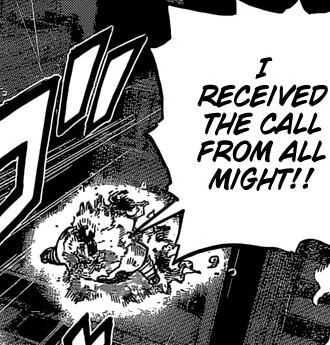
glad you received All Might’s call, mysterious unidentified glowing smudge
oh snap he says he’s weaker in the rain. is that why AFO told Nagant to attack then?? except that as we discussed the other day, I believe that AFO fully intended for Nagant to lose the fight, so him giving her info that would give her an advantage doesn’t really fit in with that. maybe he wanted Deku to be separated from Endeavor and the rest for maximum angst, though
btw Deku’s eyes are unsurprisingly back to the new normal here
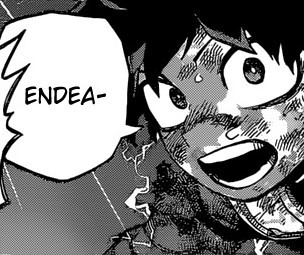
alas, the angst continues. I say, pretending like I’m not totally eating it up each and every week and writing essay after essay about it lol
anyway so apparently Hawks can’t actually fly lmao. he was just yeeting himself with style
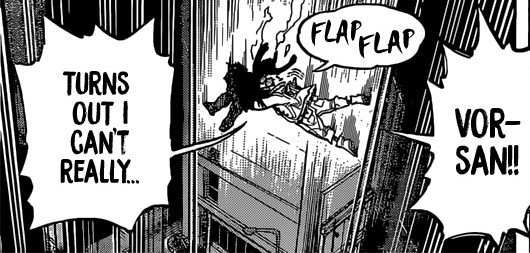
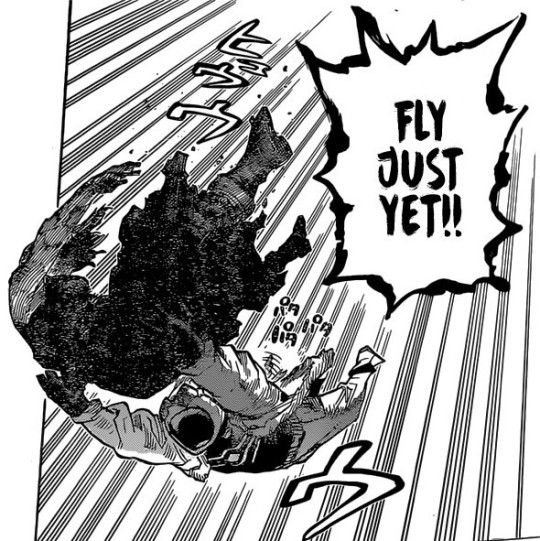
for some reason this is the funniest fucking thing I’ve ever seen omfg. wave to Hawks, kids! say “bye, Hawks!”
j/k of course Deku is catching them. -- except???
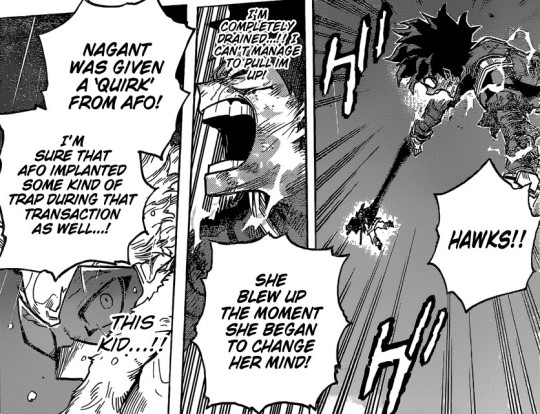
wow so he was just running on fumes there at the end. well, good to know there is actually a limit to his shenanigans, particularly regarding this new “knockoff” 100% OFA. it will definitely not alleviate any of the discourse, but it’s good for my own peace of mind because it’s solid confirmation that he still needs his pals in order to win this thing
anyway, but on to the rest of this conversation, which is basically Deku deducing what we all deduced last week -- AFO implanted some sort of trap into Nagant when he gave her Air Walk. though I’d still like to get the actual details from AFO and/or Horikoshi, because this was particularly wild even by quirk standards lol
omgggggg
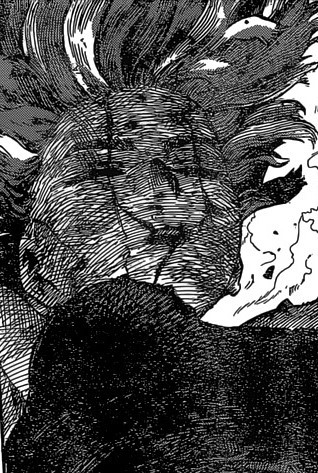
she still has a face after all!! so it’s confirmed, Horikoshi has no idea what “blowing up” actually means. we might have guessed, based on what happened to Toga in the MVA arc, and also based on everything Katsuki does ever, but shhh
so now Hawks is all “NAGANT PLEASE WAKE UP, IF I SHOUT MY NAME AT YOU WILL THAT DO THE TRICK”
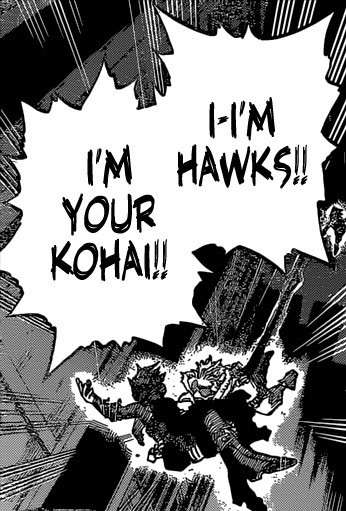
this is actually kind of touching though because even though we all know (or most of us acknowledge at any rate) that Hawks is a pretty caring person, it’s rare to see him actually panic over someone’s welfare like this
oh shit Horikoshi is really doubling down on it
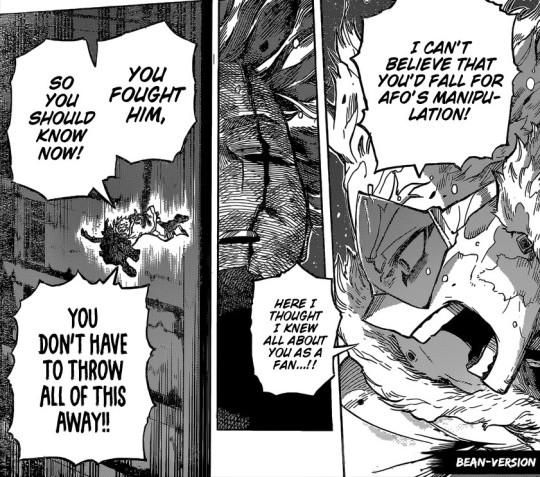
I wonder how much Hawks knew about what really happened between Nagant and the HPSC. regardless, he probably sees her as a kindred spirit of sorts, and I’m more than happy for Deku to pass the redemption torch onto him now that he’s on the scene. like no offense Deku but they actually know each other and stuff lol
DAMMIT NAGANT CAN’T YOU SEE HOW LOUD HE IS YELLING

apparently being freed from his HPSC shackles has finally given Hawks the space to embrace his own inner shounen protagonist. is there anything more shounen than trying to motivationally scream someone awake when they’re lying in your arms inches from death?? 100% guaranteed to work
!!! IS THIS NAGANT’S POV OMG
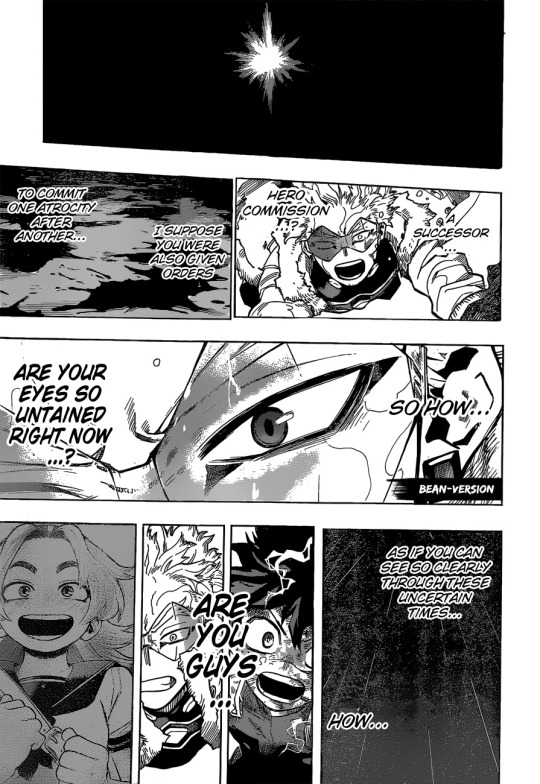
SO SHE IS ALIVE. THANK GOD. Horikoshi doesn’t want to meet with my emotional distress lawyer today after all
love how she’s all “just gonna stir up the weekly Hawks Discourse pot here by implying that he probably committed a lot of Atrocities just like I did, so now people can get all hopped up about that, even though there’s no evidence he’s ever killed anyone aside from that one horrible ‘damned-if-you-do...’ situation with Twice.” no one asked for your provocative speculation young lady!! trust me Nagant, our rabbles don’t need the rousing lol
but nice save there with the “so how are your eyes so untainted” well you see it’s because even when he was following the HPSC’s orders he always went to great lengths never to go against his own moral compass. which just to be clear was incredibly difficult, and led to a ton of pain and suffering on his part, because the life of a spy is basically just one impossible situation after another. but in spite of that he never stopped trying to do his best to help people. I don’t really know where this tangent came from or is leading to, lol, but anyway p.s.a. I love Hawks a lot and he’s a good kid dammit
oh shit??!?

how is the League always able to swing all these fancy forest mansions. where do they find them. how many do they have
so Deku’s dropping them -- very roughly, not sure if he was reacting to finally getting AFO’s location, or if his energy really is giving out -- and now Nagant’s saying that AFO hired other villains as well. well of course he did. gotta keep chipping away at OFA’s ninth successor little by little
now Nagant is asking Hawks how he’s able to keep making “that” face. I assume she’s again talking about the fact that he somehow didn’t let the HPSC wear down his spirit
oh my god???
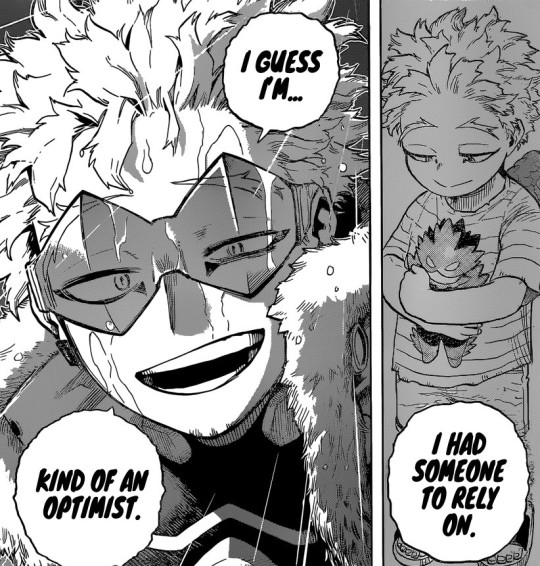
thanks for stuffing this chapter to the brim with good nutritional Hawks Feels, Horikoshi. what a good. he just keeps on trudging forward undeterred no matter what bullshit comes his way. what a steadfast little guy. I WILL PROTECT YOU FROM DISCOURSE MY SWEET SUNSHINE
lmaoooo
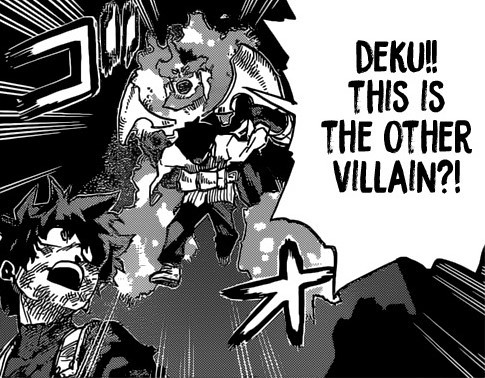
“SPOTTED THIS DUDE JUST CHILLING OUT THERE ON THE ROOF WITH NO ARMS, SEEMED PRETTY SUS” good job Endeavor
anyway so you don’t really need me to tell you that Overhaul is immediately starting in with the “BUT THE BOSS WHEN ARE YOU GOING TO TAKE ME TO THE BOSS YOU PROMISED YOU WOULD TAKE ME TO THE BOSS” stuff again. but I will go ahead and tell you anyway. so yeah. he’s doing that
OMG YOU GUYS LOOK AT DEKU’S “of all the fucking assholes to just randomly drop in on my life once again why did it have to be you” FACE THOUGH, OMG
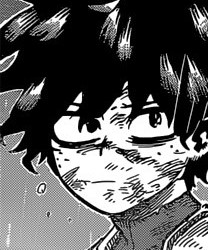
fun fact, if you go back to chapters 124 through 160, there was an entire story arc where Overhaul imprisoned and tortured a little girl. yeah, I know!! suuuuuuuuper evil. anyways just an interesting little anecdote for you all that’s somewhat relevant to the current situation
OMG, YES. FUCK YES, DEKU
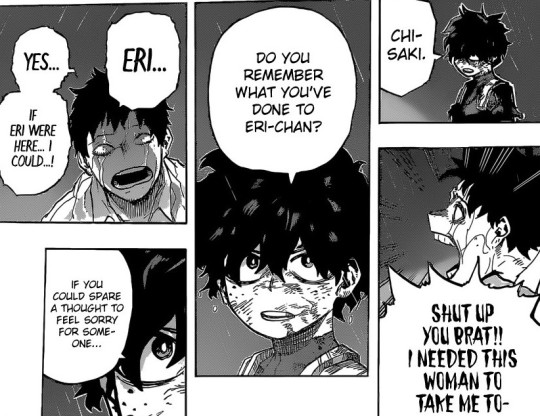
THEN WHAT ABOUT SPARING ONE FOR HER!!! YES!!! EXACTLY!!! JESUS FUCKING CHRIST, SOMEONE GETS IT
HERE’S THE PANEL OF DEKU SAYING THE EXACT SAME THING I’M SAYING LOL
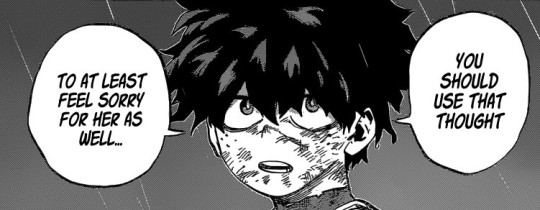
(ETA: so apparently there’s some discourse about this because some people are interpreting this as Deku saying “you should apologize to Eri”, which would obviously be a terrible idea even if Overhaul actually wanted to do that, because Eri shouldn’t ever have to see him again. however I just want to point out that there is a HUGE difference between saying “it would be nice if you could direct that feeling of regret/being sorry towards Eri as well”, vs saying “you should also apologize to her.” all Deku is doing is rightfully pointing out that Overhaul has hurt way more people than just his boss, and if he really is remorseful, then he should extend those feelings of remorse to Eri and the rest as well. it’s not a directive to take any specific action, and I’m 1000% sure no one at U.A. would let Overhaul within 100 miles of Eri ever again.
tl;dr “try feeling remorse sometime” =/= “do you want me to fly you over to U.A. right now to surprise the little girl you traumatized”, lol.)
[slings an arm around Deku’s shoulders] you’re a good kid. I like you. I don’t know if I tell you that enough, but it’s true
meanwhile here is Overhaul’s “spare... a thought... for Eri...???????” face sigh
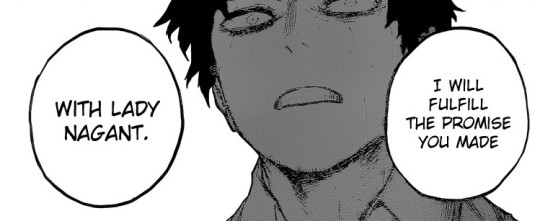
the struggle is real y’all
(ETA: and that’s... the last we ever saw of Overhaul, I guess? well all right then. I assume Deku will make good on his promise, so we know he’ll get that little bit of closure before going back to jail or whatever, and I confess I’m more than fine with leaving the rest of it open-ended, especially given his character’s history. I think this was pretty generous all things considered.)
lmao holy shit
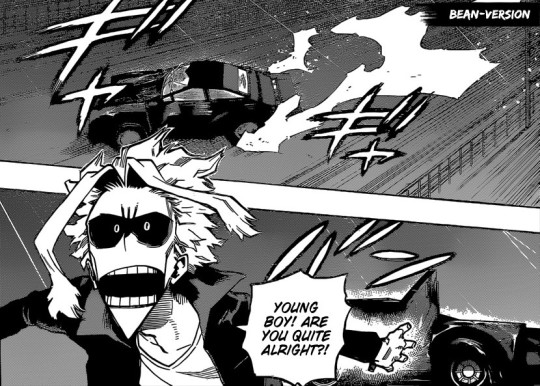
All Might what did you do to those tiki torch guys?? did you thrash them. did you give ‘em those hands. did you deliver their own asses to them complete with a sticker reminding them Amazon Prime Day is on June 21. we missed out goddammit
so Endeavor, who wasn’t the one he was asking, is telling him that they captured (well let’s be real, Deku captured, give the credit where it’s due) Nagant and Overhaul. and so I guess they’re going to take Nagant to the ER now

fire is no one’s weakness
-- oh my GOD I scrolled down and audibly gasped
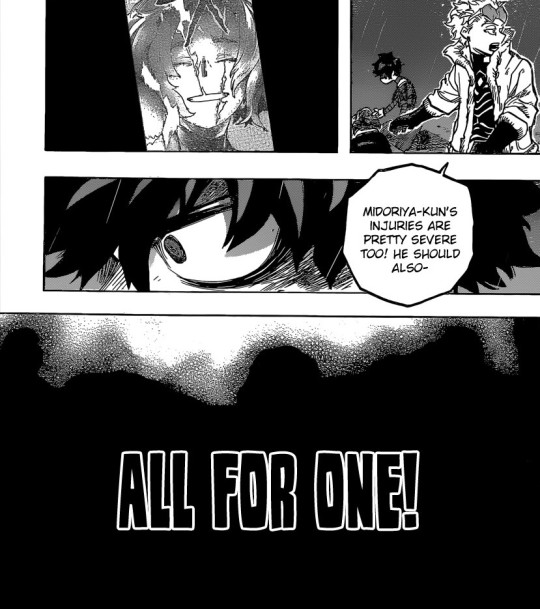
[is politely but firmly approached and asked to remove my arm from Deku’s shoulder by the physical manifestation of all this Dekuangst] “we’re sorry, he’s not allowed to have visitors right now” oh shit, my bad. [goes to stand behind a police barricade]
lmao what. did you run out of room on the previous page

what an exaggerated fade to black lmao
-- AHHHHHHHHHHHHHH
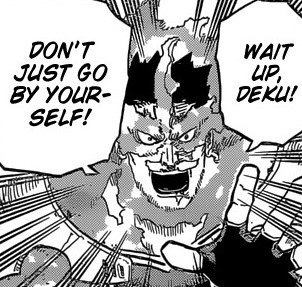
I actually can’t see what he’s reacting to so maybe I’m just seriously jumping the gun here lol, but THE HELL WITH IT. the next panel appears to be a cut to Haibori Forest, so I’m just gonna go ahead and declare that Deku ran off on his own all wounded to go have more Dekuangst, just like I manifested. now go call Katsuki goddammit
[scrolls three more inches down] oh
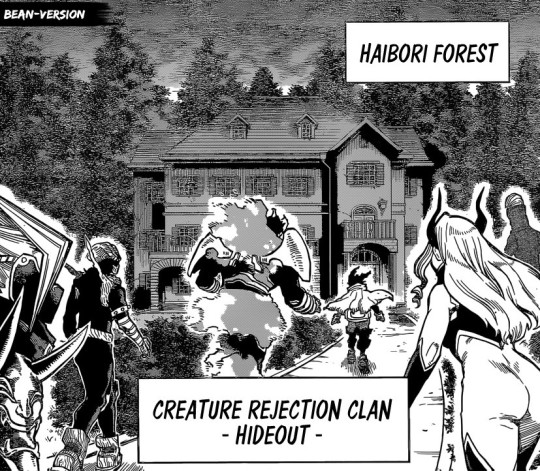
yeah so like I said, Deku is walking very slowly a few feet in front of Endeavor, who’s telling him to wait up. yep. we’ve all gotta be so careful to not just jump to conclusions. I know we’re excited but still
anyway, so! welcome back to Mt. Lady and Kamui Woods (ARE YOU GUYS DATING) and Edgeshot! have fun walking into this obvious trap lol
dammit Deku why are you so determined to tempt fate
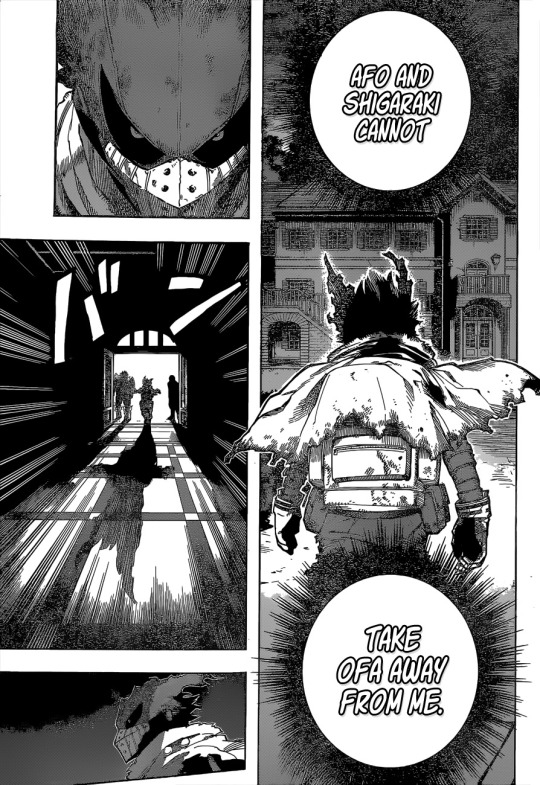
[monkey puppet meme faces]
OH MY GOD THIS IS PURE GRADE-A CHEESY COMIC BOOK VILLAIN 101 SHIT AND I’M HERE FOR IT
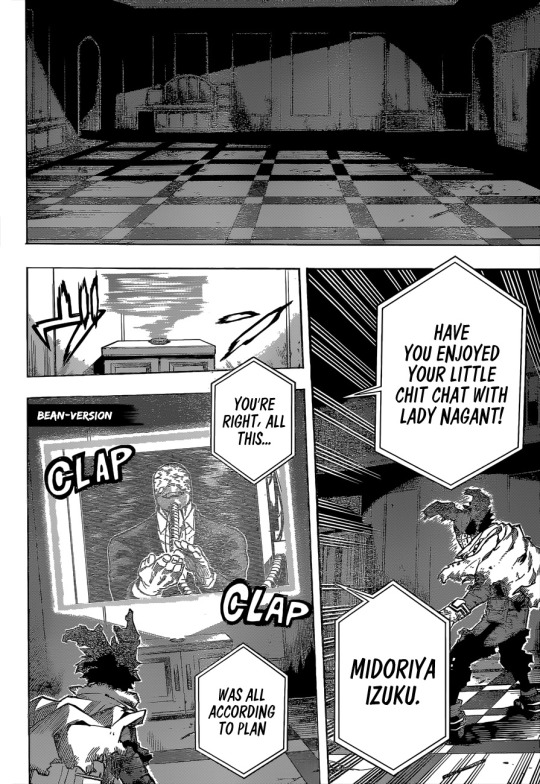
that’s such a weird way of clapping who claps like that
unlike certain other people who shan’t be named, AFO doesn’t feel the need to inexplicably take his shirt off when recording sinister villain monologues. I think we’re all pretty grateful for that
high fives to everyone who called it!! yep yep
anyway so this whole scene has major booby-trap vibes, which I’m enjoying immensely even though I don’t think anything is really going to come of it lol. probably just another long-winded AFO Speech. but wouldn’t it be funny if like the ceiling started lowering down to try and squish Deku afterwards lol
(ETA: well the explosion was still pretty funny too ngl.)
ffff

[“Dekuangst is the trap” intensifies]
anyway so yeah. he’s just hitting up all of his usual villain talking points. we get it, you’re so smart and you see right through the thin veneers of society and people who don’t conform are left to fend for themselves and labeled as villains and history is written by the victors, and blah blah blah dude are you just jumping randomly from one soundbyte to another lol. literally what are you talking about. what does this have to do with you blowing up Nagant
-- holy shit??
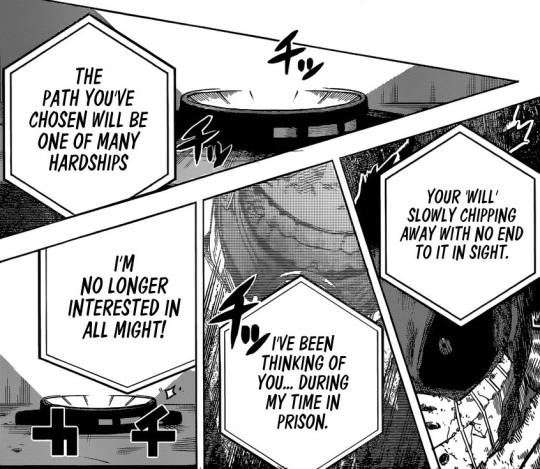
[”Dekuangst is the trap” intensifies MORE?????]
LOL WHAT
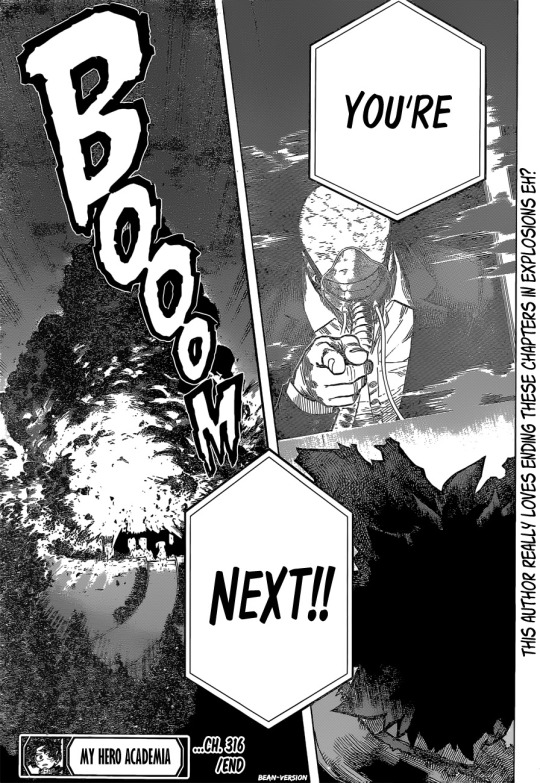
BRO. WHAT IS WITH YOU. DON’T YOU KNOW HOW TO LAY ANY OTHER KIND OF FUCKING TRAP GOOD LORD
“YOU’RE NEXT” THE CALLBACK?? THE PARALLELS?? THOUGH WHEN ALL MIGHT POINTED HE MADE IT LOOK WAY COOLER. AFO’S POINTING JUST LOOKS LIKE SMOKEY THE BEAR
HAS ANYONE CHECKED IN ON KAMUI WOODS I HEAR HE IS WEAK TO FIRE?? THE ONLY ONE WHO IS, APPARENTLY
r.i.p. to this particular forest mansion. don’t worry they have a ton of backups
remember last week when I said maybe AFO thinks explosions are gauche. well never mind. he fucking loves explosions
anyway so that’s the end of BnHA, everyone. hope you enjoyed. it was a good ride while it lasted. see you all, good luck in your travels
#bnha 316#hawks#takami keigo#lady nagant#midoriya izuku#all for one#bnha#boku no hero academia#bnha spoilers#mha spoilers#bnha manga spoilers#makeste reads bnha#manifesting 317 opening with a slightly modified version of my previous fantasy scenario lmao#'WHADDYA MEAN THEY BLEW UP THE NERD'#that's *his* job#sorry lol I kid I kid
401 notes
·
View notes
Note
Can I request a fic or hc of what would happen if r broke one of Sissy's rules.
Sissy's Brat
A/N: ahhh yess! not much to say here in the AH except how's't'dve did it get so long. Weird formatting.
WC: 1k
CW: stepsister Wanda; NSFW under the cut!!; dom-sub; punishments; power play
To recap the rules:
“One: You always call me Sissy. When we’re in front of others, I’ll call you (y/n/n) so people don’t question it.
“Two: You don’t question or talk back to Sissy. If you do, you’ll be punished.
“Three: You are not allowed to touch yourself without Sissy’s permission.
“Four: No one else is allowed to touch you without Sissy’s permission. If they do, you tell me straight away.
“Five: All you sleep in is a t-shirt or a nightdress, no panties.
“Six: Sissy knows best.
“Seven: When it’s just us, you sit on the floor unless Sissy says otherwise.
“Eight: If Sissy ever does something you really can’t handle or hate, you say ‘red.’ This one is very important,” she says. “It’s called a safeword.”
The punishment will definitely be different depending on what you break and how. Some of the rules, like four and eight, are there to keep you safe rather than to control you in the typical sense. Any good dom has some of those rules. Of course, as more rules are added, more punishments will be added, too.
One: you call her Sissy
"Wanda, it's my turn," you whine, trying to grab the controller. You slap your hand over your mouth upon realizing what you just said. "I'm sorry Sissy, I didn't mean to, it just slipped-"
"Room. Now." you nod and go silently to your room, sitting on the floor with your book in your lap. She enters quickly, closes and locks the door behind herself and sits on her bed. "Take off your pants and underwear, then over my knee," she says. You whimper but comply quickly. "Now, y/n/n, what did you do?"
"I-I called Sissy Wanda and broke rule one," you said.
"Yes. And for this I am going to spank you fifteen times, and you are going to count them. If you mess up, we start over. Understand?" she says. You nod, bracing yourself...
Two & Six: no talking back or questioning her
"What if I don't wanna?" you challenge, crossing your arms. She raises an eyebrow and crosses her own arms.
"Was that some back-talk I heard, little one?" she asks.
"I-I don't know, I-"
"I think it was," she nods slowly. "Meet me in our room with your book," she says, and you do. "Now, because you talked back and questioned me, you are going to write two pages front and back of lines. Let me see," she takes the book from you and writes a line at the top of each page: I will not be a brat to Sissy. You nod and begin your work, her leaning back on her bed and browsing her phone, keeping an eye on you.
Three: no touching yourself without permission
I think for this one, it would be your standard overstimulation or edging, depending on her mood and the nature of your infraction. If it seems like you're desperate to come, then fine, you'll come until you can't anymore and then some. If you seem to just be touching to touch, it would be edging. If you come, it will be different than if you don't come, and I think even how you're touching would change the punishment. TL;DR, if you touch yourself, she'll be playing with you for hours in one way or another.
Four: nobody else can touch you
This one I put in more considering reader is innocent and might get taken advantage of at one point or another. She wouldn't punish you for this, of course. She would comfort you to no end, cuddling you if you wanted that, getting you your favorite foods, letting up on all the rules until she thinks you're ready again, etc. And when you were asleep, she would go find whatever dirty fucker had hurt her precious little baby and make them pay so hard they wished their mother had never been born, not just them.
Five: you sleep in just a shirt or nightdress without underwear.
Okay, I feel like this one is simple enough that if you broke it, it would entirely be on purpose, especially since you share a room and generally get ready for bed around the same time. You would be asking for a punishment, essentially. First, Wanda would determine why you were acting out, and then decide the punishment. Maybe you're feeling like she's not paying attention to you- that would result in a milder punishment with some playtime after. If you legitimately wanted the punishment because you were feeling bratty, you'd get spankings and probably some overstimulation, too. If you were trying to punish yourself, it would be ultra cuddle time and some soft playtime, because even if she's firm, she loves you and never wants you to hurt like that.
Seven: you belong on the floor.
For this one, I think the first few times would be a few spankings so long as you corrected yourself. It takes some adjustment, yknow? But as time goes on, I think kneeling on the bathroom tile floor for awhile would do it. Maybe she'd even fuck your mouth before letting you stop...
"Go kneel on the bathroom floor, brat," she says, shoving you off of your desk chair. "Naked." you nod and comply. She comes in, turns the lights off, and slams the door shut behind you, then stuffs a towel under the door. It's dark and silent, and all you can think about is how much this is starting to hurt and how sorry you are.
After who knows how long, Wanda comes in, naked except for a strapless strap. She doesn't speak, just grabs your hair and pushes into your mouth, fucking your throat roughly. When she finally lets you go, you fall onto your hands and knees, coughing with tears running down your face. She's on the floor beside you, pulling you into her lap and rubbing your aching knees.
"I'm sorry Sissy," you whimper when you stop coughing.
"I know, I know little baby, it's okay now. You did such a good job. So good for me," she soothes and pets you. "Such a good baby."
Eight: safeword.
If you use your safeword, Wanda will instantly stop everything and start taking care of you. She gets you water, cleans you up, and cuddles you close. She'll make you your favorite food if you want, put on your favorite show, and just hold you close until you're ready to talk about what was too much.
#marvel#mcu#wanda x reader#wanda maximoff#reader insert#gender neutral reader#x reader#x trans reader#if you want#or not#stepsister wanda#sissy wanda#smut#wanda smut#nsft#marvel x reader#d/s writing#request#anon#noah writes sometimes
324 notes
·
View notes
Text
Edward Cullen: That Boy Ain’t Right
So I was doing a reread of @therealvinelle 's collection of Twilight metas, as one does, and in "Edward, Denial, and a Human Girlfriend" she mentions that she doesn't believe Edward is sane. I thought, "ha, yeah, he's definitely not," and also, "but wait, what does that mean exactly, please say more about that." But since she's already inundated with asks, I've decided to use my own head-muscle and explore this idea. (TL;DR: I start out more or less organized, synthesize some points Vinelle has made across several posts (and have hopefully linked to them all where relevant but please tell me if not), touch a little on narcissism, then take a hard left into the negative effects of being a telepath.)
Just a couple things to note at the outset, though. Theses have been written already (probably) about Edward as an abuser. Edward being insane doesn't negate that at all; he's definitely an asshole and just...a disaster of a human being. (I find it more funny than anything, but YMMV.) I'm also going to try to avoid talking specifically about mental illness and how it relates (or doesn't relate) to abusive behavior -- that's territory I'm not really equipped to discuss, like at all. My starting point is "Edward has a deeply warped perception of reality," not "Edward has X disorder."
So: deeply warped perception of reality. The evidence? Goes behind a cut, because my one character trait is Verbose.
Vinelle provides a great example of it in the post linked above, which I'll just quote because she does words good: "[Edward] keeps acting like his romance with Bella is a romantic tragedy, and all the cast of Twilight are actors on a stage making it as sublime as possible." Edward's the one to pursue Bella, but he does so with the full belief, from the very beginning, that it will never last; Bella will "outgrow" him, go on her human way, and he can spend the rest of eternity brooding magnificently over his too-short romantic bliss. [Insert premature ejaculation joke.] Turning her is never an option, even though Alice, Noted Psychic, says that romancing Bella will either end with her dead (exsanguinated) or dead (vampire).
This framing, where he's a dark anti-hero in love with -- but never tainting! -- the pure maiden and eventually leaving her in a grand, tragic sacrifice to preserve her soul? It's fucking bonkers. Bella isn't a person to him in this scenario. As Vinelle points out, Bella's never really a person to him at all; he falls in love with his own mental construct, cherry-picking from what he observes of her behavior and her responses to his 20 (thousand) Questions to convince himself that she is the ideal woman.
Bella's not the only one who gets the projection/cardboard-cutout treatment. Edward sees everything and everyone through a highly particular, personalized lens. He filters his entire reality, which we all do to an extent, but the thing with Edward is that he starts with his conclusions and then only pays attention to the evidence that supports those conclusions. Often that evidence consists of what he admits in New Moon are only "surface" thoughts -- but recognizing that limitation doesn't keep him from taking those thoughts as representative of what people are. Edward then becomes absolutely convinced by his own "reasoning" and won't be swayed from what he has decided is Objectively True. It's obvious with Bella; it's also painfully obvious with Rosalie. (Vinelle explains this and brings up Edward's raging Madonna/Whore complex in the same post, so refer to that again -- she's right.)
He also catastrophizes. Everything. Bella's just vibing in her room, rereading Wuthering Heights for the 87th time? She's gonna be hit by a meteor, better sneak into her room while she sleeps. Bella's going to the beach with the filthy mundanes their human classmates? She's gonna fall in the ocean. Jasper's cannibal pals are stopping by for a visit, but know not to hunt in the area? DISASTER, DEFCON 1, ALSO FUCK YOU JASPER FOR EVEN EXISTING IN MY AND BELLA'S SPHERE YOU UNSPEAKABLE BURDEN. Edward must believe that Bella is vulnerable and in near-constant peril, to support the reality he has created in which he is the villain turned protector and maybe?? hero??? (!!!) for his beloved. So when the actual, James-shaped danger arrives, he goes berserk, snarling and flipping his shit and generally not helping the situation. His fantasy demands that Bella remain human, so instead of doing the very thing Alice, Noted Psychic, assures him will neutralize the threat (and not just a threat to Bella, either, but to Bella's family and any other human James might decide to include in the "game"), he vetoes it immediately, no discussion. Bella Must Not Turn, and he sticks to those guns despite James nearly reducing her to ground beef, despite leaving Bella catatonic with depression (but human! success!) in New Moon, despite Aro's order and his family's vote and, let's not forget, Bella's clearly and repeatedly stated desire to be a vampire. It's going to happen. But he doesn't accept it until Renesmee busts out of Bella like the Kool-Aid man and the poor girl's heart finally, unequivocally stops.
Sane people don't behave this way. I don't want to slap labels on Edward, but I can't help but note that he comes across as highly narcissistic. He's the only real person in his universe, the lone player among us NPCs. That probably has a lot to do with him being frozen in the mindset and maturity of a seventeen-year-old boy, but I think it's also just...him, on some fundamental level. His failure to connect with others and recognize them as full, independent beings with their own wants and priorities isn't like Bella's failure -- she's badly depressed. Edward is...something else, and I get the sense that his sanity has been steadily deteriorating over time. And a cursory google of narcissistic traits turns up some familiar-looking stuff. He's self-loathing, yes, but also grandiose; he hates himself for the monster he is (and hates most vampires besides Esme and Carlisle for their monstrosity, too) but still feels superior to humans, to the extent that he felt entitled to human blood and resented Carlisle for depriving him of his "proper" diet. He eventually returns to Carlisle, but he's far from content -- the beginning of Midnight Sun finds him in a state of ennui, bored and dismissive of (if not outright disgusted by) everyone around him, that has apparently persisted for years and years. He doesn't play the piano, he doesn't compose, he doesn't enjoy anything...at least until Bella comes along and then he becomes obsessed to a disturbing degree with her and his new, romantic tragedy spin on reality.
[Next-day edit: I’m not sure where else to fit this in, but the way Edward casually contemplates violence against people who have, at best, mildly annoyed him is...chilling. I have a hard time writing off his strategizing how to murder the entire Biology class as a result of bloodlust -- it’s so calculated, nothing like the blackout state of thirst Emmett describes when he encountered his own “singer,” and that is probably the default for when a vampire is extremely thirsty. But even ignoring the Biology class incident, Edward still does things like consider, with disturbing frequency, how he might grievously injure or kill Mike Newton, all because...Edward considers him his romantic rival (despite Bella barely giving the kid the time of day). He thinks about slapping Mike through a wall, which might be an amusing slapstick image, except as a vampire Edward’s actually capable of turning this boy’s skeleton to a fine powder. So it’s, y’know, kind of sick when you think about it.
But even worse than that, when Bella tells Edward about how she flirted with Jacob to get at that sweet, sweet vampire lore, Edward chuckles and then, after dropping Bella home, flippantly observes that now that the treaty’s broken, why not genocide? I’m not even kidding, it’s right there in Midnight Sun; he seriously thinks about the fact that he’d be technically justified now in wiping out the entire tribe because a teenager tried to impress a girl with a spooky story. That is fucked. Remember, Edward was there with Carlisle when the treaty was first established. He knows how remarkable it is that they even came to a truce in the first place, that it was only ever possible because Carlisle is...well, Carlisle, and that it marks a pretty significant moment in supernatural history. He doesn’t care; he doesn’t respect it, or he’d never think something like “Ha ha, if I went and killed them all, I wouldn’t even be wrong. I mean, I won’t do it, but I’m just saying, I wouldn’t be wrong.”
Again: not the thought process or behavior of a sane person. (Or a person that respects life in general -- sorry Carlisle, big L.)]
Finally, whether he's a narcissist or not, I think the fact that Edward has constant, unavoidable access to everyone's thoughts is a powerful contributing factor to his instability. He can tune out the mental noise to an extent, but he can't stop it -- so he comes to rely on it like another sense. This causes issues with disconnect and lack of empathy, of course, but there's another facet to this shit diamond: he's basically experiencing a ceaseless flow of intrusive thoughts. His narration in Midnight Sun suggests that he "hears" the words people think, can "see" what they visualize in their mind's eye, and can sense the emotional "tone" and intensity of their thoughts. Therefore, perceiving Jasper's thirst through his thoughts makes Edward more aware of his own, "doubling" the discomfort. This would be a lot to deal with even from just his immediate coven members, but Edward gets all of this pouring into his head like a firehose on a day-to-day basis because the Cullens live right alongside humans. I know Meyerpires have galaxy brains or whatever, but that's a ton to process.
Besides the compounding effect on his own thirst when he "feels" the thirst of others, Meyer never suggests that Edward has difficulty separating his own thoughts from other people's; even when he was newly turned, he recognized Carlisle's "voice" in his head as Carlisle's. That would create a whole different host of issues around identity, but it looks like Edward's escaped that particular torment. However, I can easily imagine that what he does experience is just shy of unbearable nonetheless, with an eroding effect on his sanity over decades. He can't sleep to escape it; he's on a dishwater diet and probably (like the rest of his family) experiencing a perpetual, low-grade physical discomfort due to his thirst never being fully satisfied; and he's around far more people than is the norm for vampires -- even discounting all the humans, his own coven is unusually large -- meaning more noise.
Honestly, it would be weirder if he were all there, considering.
And even though I feel like I lost a sense of structure around where I started ranting about telepathy, I've written like 1.5k words about Edward fucking Cullen and I think that's enough for one post.
#twilight#twilight renaissance#twilight meta#edward cullen#i stared too long and the twilight abyss gazed back#long post#major credit due to therealvinelle for having basically all the ideas already#theoriginalcarnivorousmuffin too since they agree and build off each other's metas a lot#idk how people who write meta can just crank these posts out i've been here for two hours#edited to add stuff i forgot to mention about edward's disproportionately violent fantasies
314 notes
·
View notes
Text
I wasn't sure if I was going to post this, but I may as well.
I keep starting to reply to things and then stopping bc the words just aren't there, and I suppose I figured out the core of what bothers me so much (and is making me have such a rollercoaster of a fan experience) about the show.
(cut for length)
It's not well-written. My opinion is my opinion, so I'm saying this subjectively, take it or leave it, but ... I feel that it's not well-written. The overall story is fine, and the plot is fine, but I don't know if it's because of the limited number of episodes not being enough to house the story, or because of the relative inexperience of the writer/showrunner+director, or both, or something else, but -
In an earlier reaction post to episode 4, I mentioned really wanting to sink my teeth into all of the subtext I picked up on. That was what made me initially enjoy the episode so much - there were a lot of little moments that I initially felt revealed so much about the characters and about Loki, and I wanted to analyze them. But at some point, as I gathered more information, my perspective changed and now I no longer want to analyze the subtext bc ... subtext = good. Subtext w/out payoff = not as good.
I'll go into more detail in a moment, but I think the tl;dr of it is that I feel like the narrative requires the audience to work way too hard to put together all of the moving pieces here and, like, I kinda just don't want to do that work? Not so much of it, and not in vain. A lot of the enjoyment of Loki's characterization is coming from fans who are rationalizing why he's behaving as he is, but the narrative never actually confirms those rationalizations. It's asking us to figure it out and maybe our conclusions will be correct but maybe they won't, though. At some point, subtext isn't enough without explicit follow-through.
I thought my issue was with the lack of character development - that is, not having enough narrative space to really earn the big things that are happening now, like Loki/Sylvie or Mobius turning against the TVA. And that's still true, to an extent; I still feel like the pacing is all very off and it seems like most of these things kinda came out of nowhere (but are not unbelievable - just undeveloped).
But, yknow, it is what it is, it's a limited series, and I can excuse some things. Ultimately, my issue isn't a problem with what the narrative isn't doing, it's a problem with what the narrative already failed to do and probably cannot recover from at this point.
The narrative has left out significant details that should at least help us do some of the work here. If a person turned on Loki and started episode 1 and had no background knowledge of the character besides that he tried to take over New York - how would that person interpret Loki? Would that person say, oh, well, he's been through X, Y, and Z, and plus A happened, not to mention B, C, and D, so really, it makes sense that he seems off-the-rails, or that he'd want to get ridiculously drunk at the worst time ever.
Maybe we'd like to believe they would, but how would they be getting to that conclusion? The narrative hasn't led them in that direction so, no, they would not say well we have to consider this, this, and that. It would be impossible to really understand Loki as a character from just what we've gotten in the series. The general audience would probably interpret Loki as being out of his element and so it becomes, I wonder how this character is going to get the upper hand here. And, while that's not wrong, it's just so limited.
The narrative at face value does not address Loki's identity crisis from Thor 2011. It does not address his hurt and devastation at being lied to, nor does it address how complicated his self-image is (bc it sucked to begin with and that was before he found out he was part of a race of "monsters," as he'd been taught his entire life). It does not reference Loki being so broken at the end of Thor 2011 that he deliberately let himself fall into the void of space (aka tried to kill himself). It does not reference that he was tortured by Thanos or even that he went through a seriously dark time in between Thor and Avengers, and it absolutely does not reference or address any influence or control of the mind stone.
These are all things that we, the fan audience, know because we've already invested our time into this character's story. But tons of people, the general audience, wouldn't know these things. Or if they did, bc they saw Thor and Avengers, they wouldn't be thinking about them as deeply as we would, nor contextualizing them with how Loki is behaving now, or why it would make sense that he needed to get drunk, or why it's understandable that he needs to keep going-going-going in order to not have a spare second to think or feel.
They'd probably look at Loki, again, as a character who was a villain and is now getting his comeuppance in a place where he has no power or control, and no literal powers, and even when he manages to escape and catch up to the variant, he proceeds to fuck up their plan for seemingly no real reason except that he wanted to get drunk bc he's hedonistic. Which Sylvie even berates him for! I mean. This is not exactly a complex character breakdown, nor a very flattering one, but that's what the narrative has given us.
(If the narrative has addressed Loki's mind control, his torture, his mental breakdown, his suicide attempt, and his general shitty self-esteem as a result of his upbringing, please point it out to me. If the narrative has explicitly acknowledged and referenced these things anywhere and I am missing it, please show me where. Please explain to me how the casual viewer would know any of these things that they need to know in order to actually understand what's happening in this story.)
So I mean, okay, we have a narrative that doesn't paint a full, accurate picture of Loki. Fine, sure. But because the general audience starts out on the wrong footing, they're not going to get out of the overall story what the writers probably intended them to. For example, in episode 3, a lot of us theorized that Loki had some kind of plan - that he broke the timepad on purpose, for some reason, bc otherwise it wasn't believable that he'd be such a failure. But episode 4 revealed that no, there was no bigger plan, Loki just plain old messed up. Which is fine if, again, one is only considering the surface-level portrayal here, but it's not true to Loki's actual characterization.
I mean. Loki is not perfect and Loki actually fails a lot, this is true. He fails for a lot of reasons, but incompetence has never been one of them. Usually it's that either things grew beyond his control, or there ended up being too many moving parts, or he had to change his plan at the last minute due to some roadblock or another being thrown his way, or even that he got in his own way - whatever the case may be for his plans' failures, he was always at least shown to know what he was doing.
That wasn't the case here. The "plan" to fix the Timepad failed as a direct result of Loki's actions, which were careless and made him seem incompetent, like he couldn't even handle this mission. "You had one job," etc. And there were pretty big consequences for this; they were not able to get off-world in time and would have been killed had the TVA not shown up at the last second.
And maybe none of these things matter bc the writers never intended any of this to be a reflection on Loki's character, positive or negative. The situation exists solely because the writers needed to put Loki and Sylvie together in some kind of hopeless scenario so that they could get closer, and thus the narrative could set up their romance. I get that - but, there were other ways to do it that didn't require Loki to look foolish.
Furthermore, the whole reason they needed to set up the romance is to show Loki eventually learning to love himself (like, figuratively but also literally). The audience is supposed to gather that Loki and Sylvie fell for one another, possibly due to the high emotional aspect of, yknow, being about to die (in addition to the variant-bond). The intent is clear: Loki and Sylvie almost die but get rescued at the last minute, having now created an emotional bond --> Loki and Sylvie team up and the narrative further establishes that Loki, at least, has caught feelings --> Loki might confess them but is pruned before he gets the chance --> he somehow survives, he and Sylvie are reunited and don't want to lose one another again, and the combined power of their love is enough to break the sacred timeline and spawn the multiverse, and the reason that the power of their love is so, well, powerful is because it's about self-love and self-acceptance as much as it is about having the capacity to love someone else. The end.
I get all that. The writers more or less said all that. And, I mean, it's certainly not the way I would have chosen to go about it, but it's a fair enough arc to explore. I don't really have an issue with the intent - but my question, however, is this: if the narrative has so far not addressed Loki's background issues (as outlined above), and has furthermore kinda gone out of its way to portray Loki as hedonistic and narcissistic, among other things (like kinda incompetent), and the context the audience starts with is that Loki's this villain who deserves what he gets -
- my question is 1, why should the audience care whether or not Loki gets to a point of loving and accepting himself (thus to make the theme of self-love, via the romance, hold weight) if they don't know that he hates himself to begin with and 2, why should the audience root for Loki to reach that point when so far the perception of him is that he's "kind of an asshole"? if he's a hedonistic narcissist, he probably already has a pretty inflated sense of himself, right? A misplaced inflated sense of himself, at that, because, again, the narrative has made him out to be not that capable of much of anything. (And it didn't start out that way! It seemed to start out with Loki being capable and intelligent but it's like episode 3, in trying to set up the romance, just jumbled it all up somewhere. I think this is why I'm harping on the Loki/Sylvie aspect so much - it's frustrating bc it kinda messes up the whole story and can't even accomplish what it's supposed to anyway.)
Anyway, that's beside the point. What I'm ultimately getting at is, at what point is the audience supposed to get invested in Loki's personal growth journey?
They can't, not really. Without understanding and having the context of everything Loki has been through up until now, and why he hates himself, and why it's so important that he learn to love himself, then the "payoff" becomes kinda pointless bc the significance of it is lost in translation. So suddenly we're left with this romance that comes off as either "Loki loves Sylvie bc of Reasons" (best-case scenario) or "Loki loves Sylvie bc he's vain, narcissistic, and kinda twisted" (worst-case scenario). Neither of these conclusions are what the writers intended or were going for, I'm positive, but there we are, regardless.
In order for the writers' intent in these storylines to land, they need to address the context of what makes these particular stakes high for Loki. So far, they haven't done that. They're asking the audience to pick up on all of these things, and they're showing things that subtextually make sense and are relatively in-character - but only if you realize there's subtext in the first place.
But you can't expect the audience to do all of the work for you. If you don't want the audience to think that Loki is a narcissistic asshole and instead you are trying to convey that, worst-case scenario, he thinks he's a narcissist but is an unreliable narrator, then you have to address that. If you need the audience to understand why you're going the selfcest route and why it's important to explore Loki's capacity to love himself and others, you have to address where that exploration is starting from and why it matters. Etc etc etc.
The narrative isn't doing any of that. And it isn't like it'd be that hard to do it. They don't need to reinvent the wheel here; a lot of the pieces are already there. A few lines of dialogue for context, a brief scene here or there addressing the issues, a little more care and consistency in how Loki handles things - these are all little things that could go a long fucking way in making the narrative stronger.
I'm rambling. My basic point is that my rollercoaster of emotions with this show is because
- as a part of the fan audience, not the general one, I can contextualize and analyze the subtext and come to the conclusions the show wants me to, and thus find the story and the characters more or less enjoyable,
- but I am also going to be using the subtext to come to conclusions that aren't there but probably should be (I think it would be a better story, for example, for Loki to confuse platonic love with romantic love bc it would pave the way to explore just how fucked up Loki's understanding of love - whether of other people or of himself, and the different forms it can take - actually is)
- and when they're ultimately not there, then I think, okay why am I bothering doing all this work just to ultimately feel very unfulfilled? They don't even have to write it the way I would, I'm not saying that, but they do have to do something to make the story feel rewarding.
If we don't get some confirmation of what Loki's been through, and where his headspace is, and why it matters for him to love himself, then the story remains pretty shallow and, for me, it's not fulfilling enough. It's not engaging enough. There isn't actually anything to sink my teeth into, so it becomes kind of boring. Maybe it's rewarding to other people, and that's great for them, but like - I need more than whatever this is.
So I'm just like - well, I had a lot of worries about this show, but my being bored wasn't one of them and now there's only two episodes left and am I really not going to get anything out of this, in the long run? No new canons, no new depths or layers, no new information on Loki's experiences? This is it?
I don't dislike it. I didn't start out disliking it, and I probably wont end up disliking it. I mean, there are a lot of good moments, and good things, and fan service-y things that I appreciate. As far as inspiration for fic goes, it's a goldmine, both plot-wise as well as aesthetic-wise. All of that is great. I don't dislike this show.
But I am disappointed in it, and I feel like I'll be watching the next two episodes lacking the sense of anticipation that would make it exciting. I'll still enjoy them, probably, if for nothing else just the sheer Loki content, but whatever it was I felt watching episodes 1 and 2 is gone and I'm sad about that, too. Because I really wanted to feel fulfilled by this series; I wanted it to fill up the void that Loki's death in IW created three years ago. And I just ... don't feel it. Maybe, maybe that'll change over the course of episodes 5 and 6. I don't know.
Everything that I end up enjoying long-term, I think, will come about as a result of my own interpretations and analysis and while theoretically there's nothing wrong with that, if I had known all I'd get out of this series was more headcanons or support for my current headcanons then, well - that's fine, I suppose, but I'll definitely a little bit robbed.
149 notes
·
View notes
Note
Was Napoleon a tyrant? I don't necessarily think he was: at least, I believe he was a better alternative to the absolute monarchs he was fighting. But there are those who disagree. What are your thoughts on the subject?
This is a can of worms to be sure.
I mean....how are we defining the word tyrant? All monarchs are tyrants to someone. Monarchy, by its very nature, is tyrannical in one way, shape, or form, no matter who is at its head. Even in the more neutered forms we see now days with the British. The Queen still exerts a ridiculous amount of power, all things considered.
Napoleon was no better or worse than any other monarch in Europe at that time. Indeed, better than some, worse than others. Because you know, he was human!
-
This got VERY long. SO LONG. Choice excerpts from below the cut:
"'Power was encroaching with large strides behind the words order and stability,' as Thibaudeau put it."
"(And I suspect he was concerned about seeming too eager for power/setting up a monarchical system.
Fouche: You're about as subtle as a canon going off right next door.
Napoleon: Hush.)"
"Theeeeeen the little bastard (affectionate) became Emperor."
"Napoleon Vs. Jeff Bezos: fight! fight! fight! (I'm putting my money on Napoleon.)"
--
tl;dr: a more or less benevolent emperor who had his faults and who was intimately aware, for better or worse, more than most monarchs, that the head is only tenuously attached to the body. (Skim to the bottom for my thoughts on the personal things i.e. how I interpret Napoleon's actions and brain)
But, more seriously, as with most absolute statements, I am opposed to calling him a tyrant because it is reductive and serves no purpose except to make broad sweeping political statements that I believe are far more about the person making the statement exemplifying their modern political, republican position (as in, actual republican-I-support-the-existence-of-republics not the gop) rather than expressing any sort of truth about the past. (wHaT iS tRuTh.)
For historical purposes, it can over-simplify the situation and lead to skewed interpretations of events because you're coming in with this word that has a lot of modern, 20th and 21st century baggage to it.
And, because these people are coming in with this big, bad word of tyrant as a label for Napoleon, it doesn't allow them to engage with the nuance and complexities of his reign.
Anyway.
Napoleon, as emperor, supported centralized power held in his own hands, with support from other governing bodies (senate, council of state etc.). However, Napoleon had a lot of influence in the structuring of these governing bodies and the subsequent appointments as a means to exert control over entities that would otherwise be able to act somewhat independent from him and impinge his power.
We see this consolidation of power beginning, obviously, under the consulate. 'Power was encroaching with large strides behind the words order and stability,' as Thibaudeau put it.
There was the whole theatre around the Tribunate offering to extend Napoleon's tenure as First Consul for another ten years as a means of thanks/showing gratitude for all he did for France (Fouche was like: fuck that, let's just make a statue of the guy). Napoleon played the part of Humble Servant of the Public and refused both statue and the ten year extension. (Very Julius Caesar: You all did see that on the Lupercal, I thrice presented him a kingly crown, which he did thrice refuse. Was this ambition?)
In actuality, though, he was pissed because he wanted it extended for life.
This resulted in the Council of State deciding "independently" (i.e. Napoleon wasn't present but he sure as hell influenced that Council session) to hold a plebiscite in order to ask The People two key questions: 'Should Napoleon Bonaparte be consul for life?' and 'Should he have the right to designate his successor?'
Napoleon nixed the second question saying to Cambaceres, 'The testament of Louis XIV was not respected, so why should mine be? A dead man has nothing to say.' Which is to say, he knew people would vote for him to be Consul for life, but the prospect of him choosing a successor, a la the Roman Empire, and having that choice be without input from the people and respected upon his death? Less clear.
(And, I suspect he was concerned about seeming too eager for power/setting up a monarchical system.
Fouche: You're about as subtle as a canon going off right next door.
Napoleon: Hush.)
For the Plebiscite, there were around 3.56 million votes for Yes to the question of Napoleon as consul for life and only around 8,300 for No.
The turnout rate was 60% which is uhh...impressive! (To be fair, there was no real evidence of tampering with the vote. Unlike in subsequent Plebiscites, such as the results for Do We Make Him Emperor, which were absolutely doctored. But, considering the highest turnout ever seen in the French Revolution was around 30/35%, double that is certainly something.)
Lafayette was pissed with this. He kicked up a fuss in the Senate and wrote to Napoleon saying that his 'restorative dictatorship' had been well and fine for now but has Napoleon thought about restoring liberty? and that he was certain Napoleon, of all people, wouldn't want an 'arbitrary regime' to be installed!
Napoleon: Bold of you to assume that, Lafayette.
There were, at this time, some mumblings and grumblings about tyranny from the liberals and those still wanting to continue the experiment of the French Republic, to be sure. They increased as time went on and Napoleon's power continued to consolidate.
Theeeeeen the little bastard (affectionate) became Emperor.
Lafayette: WhAt Is tHiS??
Napoleon: Look into my face and tell me honestly that you are shocked.
--
His government, as Consul and as Emperor, was centralized and very top-down in how it operated. Little was done without Napoleon's input.
The seemingly democratic institutions that had propped him up into power were retained and Napoleon used them as a means to facilitate his rule. As noted earlier, Napoleon had a heavy hand in appointments and the processes in place to fill various offices. Nothing was really...independent of him and his influence.
Though, in terms of Image Building of Empire, Napoleon worked hard to try and maintain the façade of impartiality as emperor. That he was head of state, sure, but all state apparatuses operated independent of him.
(Why is Napoleon's hat so big? because it is full of lies supporting the imperial image making machine.)
That said, when it came to filling those offices, Napoleon focused on merit more than anything as he wanted his governing officials to be capable, hardworking and, above all else, loyal.
(A good quote from Napoleon in one of his more Eat the Rich moments of the consulate: 'One cannot treat wealth as a title of nobility. A rich man is often a layabout without merit. A rich merchant is often only so by virtue of the art of selling expensively or stealing.'
Napoleon Vs. Jeff Bezos: fight! fight! fight!
(I'm putting my money on Napoleon.) )
--
This is getting really long and I feel that I've not addressed anything in a useful manner, but am I going to stop? No.
--
Napoleon, himself, at least in 1803, did express some conflicted views about assuming an imperial title. To Roederer he said, 'So many great things have been achieved over the past three years under the title of consul. It should be kept.'
Cambaceres said to Napoleon that upon assuming an imperial title 'your position changes and places you at odds with yourself.' No longer are you merely a public servant, an upholder of the Republic's ideals. Now you are a man wearing a crown, trying to be the upholder of the Republic's ideals.
(nb: I feel that duality is something Napoleon never fully got a handle on. He would veer strongly into authoritarian monarch then have moments of Rousseau-ian Idealism.)
Napoleon was insistent that his rule be a parliamentary monarchy (keeping the governance framework implemented in the Constitution of Year VIII, if I am not mistaken. But don't quote me on that.) and that the French were not his subjects but his people.
So, the imperial government worked thus with the Legislative process divided between four bodies:
Council of State which would draw up legislative proposals,
Tribunate which could debate on legislation but not vote on it,
a legislative body which could vote on legislation but not discuss it, and
Senate which would consider whether the proposed legislation conformed to the Constitution.
The Senate and the Legislative body could, theoretically, curtail Napoleon’s freedom/power. However, considering the fact that he was involved in the appointment process of these offices, and the general rhythm of daily governance, how much power they were able to exert over him was limited.
(This is at his height! Of course, towards the end we see a shift in that. But that's largely tied up in his military defeats and the British banging the door knocker demanding to be let in. Also they brought with them some friends. You might have heard of them? Bourbons?)
The initial terms the Senate brought to Napoleon with their offer of accepting him as a hereditary monarch included, but weren't limited to:
liberty cannot be infringed
equality cannot be jeopardized
sovereignty of the people must be maintained
the laws of the nation are inviolable
all institutions were to be free from undue imperial influence (e.g. the press)
the nation should never be put into a position where it needs to behead the head of state. Again.
Napoleon was uh. Not best pleased with this and had a new version drafted up that included acknowledgement of the sovereignty of the people, but a lot of the other things (e.g. freedom of the press) were cut out.
Yet, Napoleon maintained certain parts of the French Revolution's values which were reflected more in the 1804 Code Napoleon and other legislative and legal pieces than in the initial terms of Senatorial acceptance of his imperial title.
Some of the things enshrined in the Code that were carry-over from the Revolution include, but aren't limited to, the abolition of feudalism, equality before the law, freedom of conscience (to practice their own religion), gave fixed title to those who had bought church and émigré lands during the 1790s, and the equality of taxation was maintained (tax those aristos and the church). Also, there was affirmation of the idea of careers being "open to talent" rather than an accident of birth (as touched on above).
The Freedom of Conscience clause in the Code was a further formalization of several Articles Napoleon amended onto the Concordat in 1802. The Articles guaranteed the principle of religious toleration and made the Protestant and Jewish churches similarly subject to state authority (alongside the Catholic).
These are just a brief summary of some of the more liberal/revolution-informed aspects of Napoleon's governing.
The non-liberal ones I believe we're all pretty familiar with: suppression of the free press, roll-back of rights for women (women are for babies!), reinstatement of slavery (which he later reversed circa 1810/12-ish), top-down Emperor-has-final-word approach to ruling (Napoleon was all about Authority From Above, Trust From Below) etc. etc.
At the end of this, I would say Napoleon's empire falls into that "benevolent monarch" situation. For a given value of "benevolent." As stated at the start, he was like most other monarchs in Europe at the time. Better than some, not as great about certain things as others.
--
Really, it all ties back to Order and Stability.
Napoleon's assent, and his approach to strong, centralized ruling, was a result of uncertainty and constant government change over ten years of revolution alongside the growing belief, by 1803, that a republic like the Romans or Greeks was not going to happen any time soon. Not without constant warfare and the forever looming threat of a Bourbon restoration.
In addition, Napoleon was doing imperial drag. (If that makes sense.) He was dialing the notch of Emperor up to 11 - being the most emperor of all emperors. So, state control was absolute because he couldn't show any signs of weakness - either in his own body, his familial body, or the body of state. The court protocols were intense and over-the-top at times because he had to prove he was not just a second son of a parvenu lawyer from the sticks. No! he was worthy of this pomp. He was worthy of imperial majesty. He was worthy of the crown and scepter.
Napoleon was not raised to be anything other than a military officer and a middle-class head of a family (would have been a MASTER at doing Sunday Dad Puttering About the House). When he dawned the mantel of power, particularly that of empire, he had to make it up as he went along. For such a self-conscious and proud man, this was difficult. He never wanted to misstep and be embarrassed - on a personal level, political or military.
At the same time, he was reared on Rousseau and Revolution so still had those values and ideals imbedded in him, and those fears and memories. Napoleon knew as well as any Frenchman that a monarch's head is easily removable should it become necessary. Therefore, he sometimes ran roughshod over the liberty to ensure security. For better or worse, that was the choice he made.
--
Napoleon was a flawed leader with a complex approach to governing that was focused on a centralization of power within him while, at the same time, trying to be the Successor of the Revolution, the Roman Republic and the Roman Empire. Layers! Like an onion.
His approach as emperor really was within the realm of normal-for-the-times when compared to most other monarchs on the European stage in 1800. He also granted liberties to his people that were unheard of in other countries.
I feel like all my Napoleonic ramblings end with the same message: Dude was nuanced. Dude was complex. Dude did good things and bad things. Dude helped people and hurt people. Dude contained multitudes. Because he was simply human, at the end of the day.
--
ANNNNNNND we are done.
Gods bless all y'all who made it this far.
Have my favourite picture of Napoleon at Tuileries as a prize.

hmm that beautiful heavy, handed symbolism.
#napoleon#napoleon bonaparte#ask#reply#napoleonic#history#19th century#imperial myth making#napoleonic identity
64 notes
·
View notes
Text
You Have an Infection???
A recent post I saw kicked this off, but it was definitely not the first one I’d seen accusing Gabrielle of throwing Ephiny’s precious heirloom staff in the Ganges River.

Friends, this is just not true. And I’m obsessive enough to prove it! So, come with me on a whimsical journey of Gabrielle’s magical staffs. (TL;DR Version)

Below is the one Ephiny’s mother gave to her long ago. Note not only its obvious eagle head up top but also its russet-brown color and black grips.
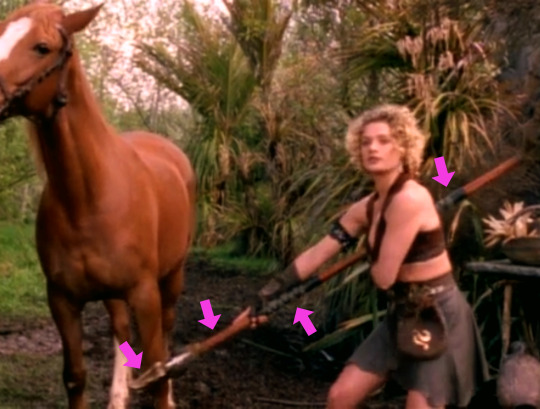
Gabrielle walks out of “Hooves and Harlots” with Ephiny’s old staff and Terreis’s outfit, neither of which are ever seen again. Three of the next four episodes show Gabrielle without a staff altogether. (Though she does pick up a makeshift chobo and briefly fight a couple of soldiers with it at the end of “The Black Wolf.”) I like to think that she is with the Amazons during the first part of that episode, learning more from them and asking them to hold onto her Amazon gear for safekeeping. Then Gabrielle gets too busy smuggling Xena’s weapons to worry about her own. After that, she skips off to and returns empty-handed from the Athens City Academy before going similarly weaponless throughout “A Fistful of Dinars.” (Remember when she brought a small, fluffy bag to a sword fight? 😂)
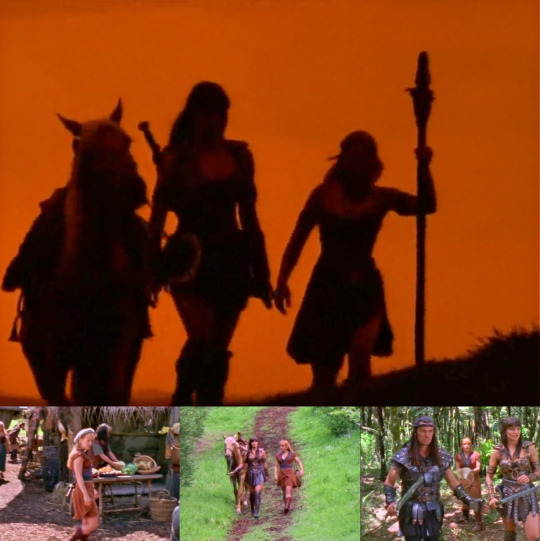
Finally, we meet good old main season-one staff. Long, thin, dark brown with a light-colored little pouf up top and metallic center, usually not varnished; this is our staple until season two. …Even though it pretty immediately gets broken in half (its centerpiece, inexplicably fancified) and replaced with a similar but not quite identical one in Troy. Thanks, Perdicas!
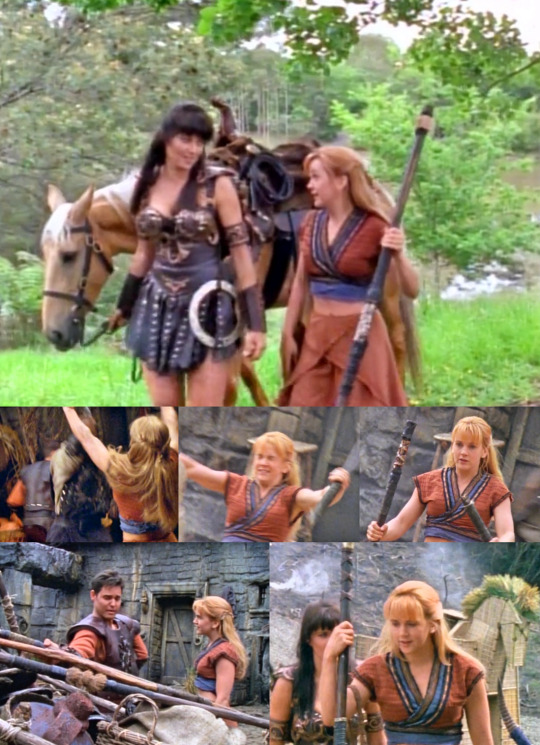
But that’s okay! It’s back in action for the next two episodes, only to go missing for “The Royal Couple of Thieves,” in which Gabrielle has to use whatever’s handy. Although the episode’s staff’s overall design is much like that of the one she’ll use for the next three years, it is capped with a giant, stylized blade.

Old trusty returns just in time to be demolished by the wabbit-freezing cart of doom. Yup. No way Gabby’s little stick survives this! (For some reason, Gabrielle flips it upside-down to pole-vault and then turns it invisible, but that is neither here nor there.)

Just kidding! It gets resurrected again and is totally fine for the next two episodes once more. (Except for that brief moment at the beginning of “Altared States” when it looks a bit like her main one again, which is perhaps a birthday present from Xena?)
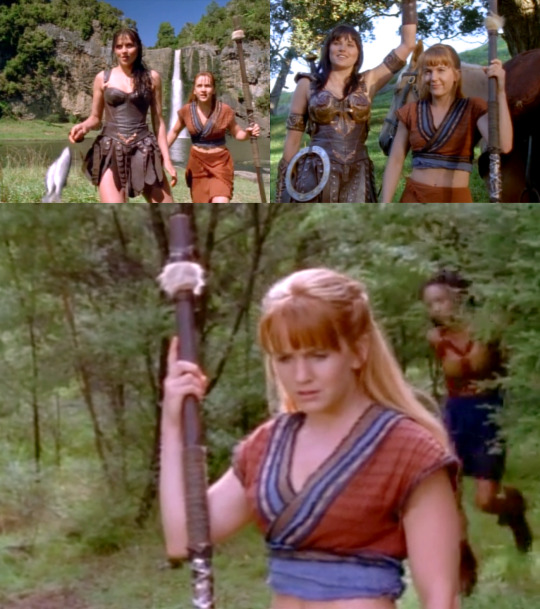
Gabrielle takes up her main staff for “The Greater Good.” See how special it is, with its beige accent ropes and central part that is very reminiscent of her main outfit’s belt? Ooh, also; it’s collapsible! Model that beauty, GW!
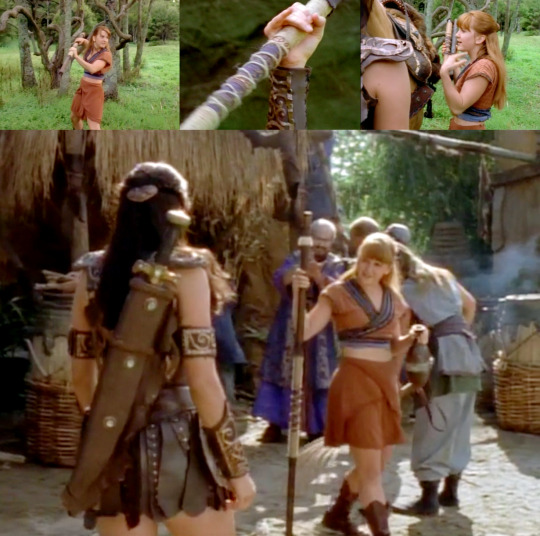
Thanks, love! Now for a little switcheroo in “Callisto,” fave to impending main.

An extra-long staff with that super fancy central piece from BGBG shows up outta nowhere in “Death Mask.” Then we close the season with early fave.
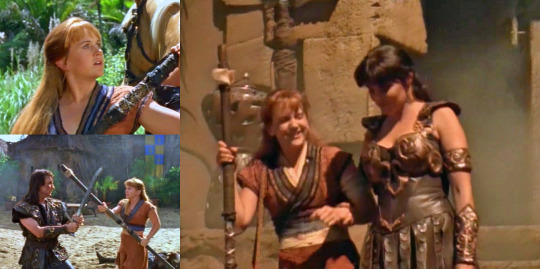
Alrighty; so! Even my obsessions have limits. Since only season one has the benefit of being FLM’d, we’re just gonna skim through seasons two and three, checking in now and again but otherwise trusting that Gabrielle uses the same staff all that time. The following images are from: “Orphan of War,” “The Giant Killer,” “The Execution,” and “A Comedy of Eros” + “The Dirty Half-Dozen” (since the first two episodes of season three are generally considered leftovers from two), “The Quill is Mightier...”, and “Sacrifice II.” Please note that while Gabrielle’s staff can be dressed and/or shined up, even thickened a bit (as seen in the second image of the season two finale and the pic from the third episode of the third season, respectively), it does not change its basic appearance. Read: None of these staffs is Ephiny’s hand-me-down either.

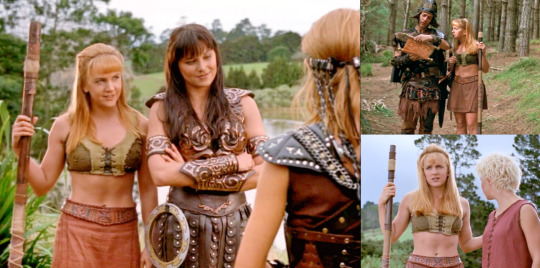
Season four uses the same staff, from “In Sickness and in Hell”—the first time Gabrielle has one this season—up to the last act of “The Way.” While saying goodbye to Eli and Hanuman, Gabrielle is suddenly holding a giant turd*- I mean, very dark staff with nearly indiscernible markings. Then it unexpectedly gains metallic bits and even chains? But that’s OK. It goes back to its nondescript form once it’s in the water. Only to gain some sort of fur outline and roped-off sections in the next shot? I dun even know.

Perhaps we were being shown a montage? ’Cuz it sure seems as if Gabrielle threw more than one staff into the river. I count three, maybe four in the image below. She just got rid of all of ’em, I s’pose.** …Except for her and Ephiny’s first staff, of course. I don’t see that rust-red/brown, eagle-headed one anywhere. Do you?

No? I rest my case. LOL! + Welp, I hope you enjoyed that jaunt down memory lane either way. Thanks (? 😂) to all the people who helped make this happen. Also, friends, if you see any more like ’em, then please direct them here. #GabbyStanForever heheheh Wub yuu, wabbit! And so does Lu. Take it away, Lu!

.
*Heh, is that a “HaH” reference? Remember when Xena handed Gabrielle that bag of horse dung back then? 😅 Poor wabbit.
**LOL at Gabrielle thinking she’s Oprah but with significantly less desirable prizes. “You’re going downriver! And you’re going downriver! You’re all going downriver!” 🤣
#xena#xena warrior princess#xwp#gabrielle#ephiny#staff#fighting staff#amazons#fan observations#fan theory#gabbystan
104 notes
·
View notes
Note
Hi! I saw your tag on your informal buddie lap makeout poll (Which, exceptional scientific inquiry. Cannot wait to see the results. Especially if it leads you to write something...)
Anyway, what is your thinking on lonestar and a potential buck +e ddie sex scene? (FWIW, I don't watch LS. I tried, but just could not. Not yucking anyone's yum, just didn't work for me.)
Curious what you think?
Thank you! The study is going well, I look forward to analyzing the results in depth!
(Please note: after three hours of writing out this response, I realize I may have misunderstood your question 😂 If you meant "what do you think a buddie sex scene would look like given tarlos", please let me know and it would be my genuine pleasure to describe that in great detail. What follows is not that.....)
I have been thinking about the potential of a buddie sex scene more than I ought to, I'm sure. You could say I've been a smidge preoccupied since realizing all the legit sex scenes in the show happened in season 1/early season 2. In seasons 3/4, the closest I think we've gotten to textual sex is Madney having sex to induce labour and that consisted of Maddie throwing her shirt at Chimney from off-screen.
Someone on that post (can't find it now of course) said that 911 Lone Star took over the original 911 later time slot and thus took over the ability to have sexier content.
As someone who hasn't watched a television show live in like 5 years, your ask has prompted me to do actual research to confirm this 🤓 According to pogdesign, 911 currently plays Mondays at 8pm and 911LS plays at 9pm which supports the theory.
That said, it kind of strikes me as weird that 8pm is considered too early for sexy content? But maybe I'm just out of touch with cable television??
So I did more research! So much research omfg this took 3 hours of my life. 😅
First we define the issue at hand
I'm defining a "sex scene" as a scene that involves two or more people mackin' on each other with any of the following:
the beginning of clothing removal onscreen
the movement towards a bedroom or bed
getting into someone's lap as a sign of escalation
post-coital pillow talk or cuddling
actual shots of naked skin and writhing (softcore porn essentially)
So 911 got moved to 8pm. Do any other 8pm shows have sex scenes?
CW - The 100 🔥 (I know there was a minimum of 2 wlw sex scenes, though they may have been post-coital)
CW - Riverdale 🔥🔥 is another teen show that I don't watch so I youtubed "Riverdale sex scenes" and I'm led to believe at least one couple is banging semi-onscreen well into season 4 (it has 4 seasons???)
NBC - Chicago Med 🔥, a procedural show not about teenagers and seems to have a least 1 couple with sexy scenes (the other Chicagos air at 9pm and 10pm) and I saw lap sitting for a hardcore makeout for the other couple!!!!! TIM TAKE NOTES!
NBC - Superstore 🔥, a half-hour comedy that played at 8pm on NBC, did have at least this one cut-away sex scene
So 2 teen shows, 1 procedural and 1 comedy all had something in the way of "sex scenes" while airing at 8pm.
But what if Fox the network is the sex-scene-killers??
Apparently Fox literally has only 5 scripted dramas of which the 911 is one and the others are:
The Resident 🔥🔥, a medical drama that plays at 8pm as of season 2 (9pm for season 1) and the main couple seem to have several sex scenes, but interestingly from what I can glean from YT, they may have stopped after s2 (though the couple stays together until at least s4 from what I can tell)
LA's Finest 🚫, a rebroadcast through Fox, it airs at 9pm and YT didn't show me any sexy scenes
Fantasy Island 🔥🔥 which plays at 9pm and looks to have sexier content based on the trailer
911: Lone Star 🔥🔥🔥 which plays at 9pm. Tarlos have had like 2 heavy makeouts/implied sex scenes plus a pretty hardcore-for-tv sex scene in the s2 finale
So it seems like even for Fox, the 8pm timeslot isn't necessarily what's vetoing the sex scenes in 911. But just to hammer that home, I did even more researching into the watershed hours, which is apparently the designated time broadcasters can show sexiness, but in the US that's 10pm to 6am so if the restrictions were such that they couldn't show any sex scenes before 10pm, Tarlos wouldn't have gotten that finale action (thank you, IRL bff who watched 911LS so I didn't have to!)
TL;DR - a summation of our findings
The 8pm timeslot is not the sex-scene-killer I once thought it was (see: all them filthy shows)
911 being a cop show is not a sex-scene-killer (see: dramas, procedurals and comedies all had sex scenes)
Fox is not anti-sex in their 8pm scripted dramas in general (see: The Resident)
Fox is not anti-sex homophobically (see: Tarlos, Hen/Eva)
However!! There seems to be a somewhat weird, somewhat isolated trend of Fox shows either cutting off or tapering off sex scenes (see: 911, The Resident) after 2 seasons or specifically after 2019.
So what are the theories (from least to most favourite)?
Theory #1 (Buddie loses 🚫): "Something" happened at Fox in 2019. The Resident is the only true analogue to 911 as it's also on Fox, also premiered in January 2018, also started at 9pm but was moved to 8pm (in season 2, not season 3 like 911). If my very brief googling can be trusted, The Resident saw a lot of sex scenes in season 2 (at 8pm) but after 2019 there isn't much to write home about. That lines up with what we've seen in 911. If something happened internally at Fox that changed broadcasting guidelines for 8pm, then canon Buddie will not get sex scenes unless the timeslot changes back.
Pros: It would be a hell of a coincidence wouldn't it?? Both shows airing around the same time, both stop showing sex scenes around the same time???
Cons: It's pretty weak, I can't find anything that supports "something" happening in 2019 that would affect an 8pm timeslot but not the 9pm one.
Theory #2 (Buddie loses 🚫): Sex as a short-term sales tactic. Fox uses sex in the first two seasons of shows to boost ratings and get people hooked because sex sells. But then, for whatever reason, they taper it off. If so, Buddie being canonized would not produce any sex scenes as we're far removed from season 2.
Pros: The Resident and 911 both stopped showing sex scenes after season 2 from what I can gather
Cons: If sex sells, why wouldn't it keep selling all the way to the bank?? There's no reason to stop something that's working.
Theory #3 (Buddie wins 🔥): Actors are the roadblock. Fox is fine with sex scenes at 8pm but the actors aren't comfortable! If so, Buddie sex scenes could be in the cards as both actors have had on-screen sex scenes previously.
Pros: Angela Bassett, Peter Krause and JLH are bigger names and they presumably get to not get naked on screen or simulate sex scenes if they don't want to. Aisha Hinds as a (criminally) smaller name wouldn't have had that kind of leverage in season 1, nor would Ryan Guzman in season 2? And Oliver Stark knew what he was signing up to to play a self-diagnosed "sex addict" so.
Cons: This is absolute, complete conjecture. I have zero idea what each of their comfort levels with sex scenes are or how that might relate to the writing/direction of their characters.
Theory #4 (Buddie wins 🔥): Stable canon relationships kill sex. Fox dramas use sex only pre-maritally to build relationships and the network or the showrunners/writers decide it's not as important once characters are in stable relationships/married. If so, we will get Buddie sex scenes as their canon relationship develops.
Pros: The Resident couple did get married post-season 2 I think? Athena stopped having onscreen sex after she married Bobby. Hen had sex but out of her marriage.
Cons: That's dumb, let married people bone. And we technically do have a Madney sex scene, tame as it was (but maybe they straddle of the line of stable but pre-marital???). Also if sex = building relationship, EddieAna have been excluded from that formula oops 😌
Theory #5 (Buddie wins 🔥): We're overthinking all of this. There hasn't been sex scenes past season 2 because the stories haven't called for it but when it does, such as the start of a new relationship, then we'll get some!
Pros: We haven't had any "new" relationships other than EddieAna since season 2 and their lack of intimacy is a glaring reminder they aren't well suited - they're not boning for plot reasons. While not strictly meeting the aforementioned definition of a "sex scene", we could use Albert coming out of Veronica's shower as a use of sex-as-relationship-building.
Cons: That's dumb, let married people bone, the sequel. Especially since HenRen is criminally neglected in terms of development and could use a fun playful sex scene.
So what have we learned?
Should Buddie go canon, 3 theories indicate we'd get some sex scenes for them, and only 2 say we wouldn't. The odds are in our favour. 🤡
I will do literally anything to procrastinate writing this damn fic that's been tormenting me for weeks. Please someone, anybody...send help...
#buddie meta#buddie#911 meta#are you also kept awake at night by the thought of canon buddie without sex scenes??#or even lap sitting makeouts????#well rest your weary head on this qualitative data analysis friends!! the future looks 60% bright!#911 reference#my posts#did you know we could add colour to text now guys?? did you know the mac keyboard comes default with emoticons??#the things I learned this night
51 notes
·
View notes
Text
Racism in the Marvel fandom as seen through the number of fanworks per M/M ship on AO3
I talked about this on Twitter, but I'm posting it here with tweaks and additions.
A couple of notes about the ship selection process:
I focused on M/M ships here as they're the biggest and most common on AO3 overall and, for the most part, the Marvel fandom
I put aside my personal feelings, so the following selection ranges from my OTP and ships I like to ships I dislike or am squicked by and NOTPs. The big ships and crack/niche ships are ones that have the most popular male characters or I’ve seen come up the most often, but I'm sure the pattern is consistent with more minor characters and subfandoms with fewer works
I focused on ships that exist in the MCU (film side only, no TV), only or in addition to other universes, just to simplify things. The MCU fandom is the biggest, and it gets complicated once you throw in other universes considering the vastness of the Marvel multiverse
I looked at the overall fanwork count for the ships rather than fanworks for that ship in the MCU tag as people tend to miscategorize their works
As of 6/19/20:
AO3 fanworks of big MCU/MCU-based ships:
Steve/Bucky: 50,501
Steve/Tony: 36,638
Loki/Thor: 13,071
Clint/Coulson: 10,940
Loki/Tony: 9,880
Bucky/Tony: 7,504
Spideypool: 7,271
Starker: 6,073
Ironstrange: 4,844
Bruce/Tony: 4,734
Bucky/Clint: 3,841
Stuckony: 2,331
AO3 fanworks of MCU/MCU-based ships with 1 or more POC where the characters interact a few times, have meaningful relationships with each other, or have genuine or crack potential:
Sam/Bucky: 3,023
Steve/Sam: 2,908
Rhodey/Tony: 1,434
Erik/T'Challa: 578
Ned/Peter: 429
Coulson/Fury: 264
M'Baku/T'Challa: 155
Rhodey/Sam: 149
Strange/Wong: 82
Heimdall/Thor: 50
Scott/Jimmy Woo: 36
Scott/Luis: 24
Fury/Pierce: 16 (fandom is also ageist)
The disparity between the two lists is particularly egregious when you consider:
Clint and Coulson had 17 seconds of dialogue and 7 lines with each other and never interacted again after Thor. This is a generous estimate as I included pauses
Loki and Tony haven't interacted since The Avengers
The only time Bucky and Tony as a duo and Steve, Bucky, Tony as a trio interact is in the bunker in Siberia
Spideypool includes a character who isn't even in the MCU
Ironstrange didn't exist or really exist in MCU fanworks before 2018, and Tony and Strange only communicate once in their second movie together, with Strange holding up his finger silently
Bucky and Clint never interact with each other
I’ll be focusing on the Captain America, Avengers, and Iron Man subfandoms first as those are the three biggest in the MCU. Before I start, here's my thread from last year about some of the ships I’ll be mentioning.
Okay. How does Bucky/Tony have 6,070 more fanworks than Rhodey/Tony and 4,481 more than Sam/Bucky and Bucky/Clint have 818 more than Sam/Bucky? How do Loki/Tony and Ironstrange have 8,446 and 3,410 more fanworks than Rhodey/Tony, respectively, and Stuckony almost as many as Steve/Sam?
The gap is especially glaring when you compare Steve/Bucky and Steve/Tony to Steve/Sam, Sam/Bucky, and Rhodey/Tony; however, though it's important to point out that wide gulf, I lose my mind more over the fact that ships with white characters who have never interacted or only exchanged a few lines (Clint/Coulson never even STAND IN THE SAME ROOM, and they're one of the top ships!) have more fanworks than ships with POC who do or have potential.
I will point out that at least with the MCU Spider-Man and Black Panther fandoms, you do see some diversity with their big ships (I’m including some M/F ships here to make a point in the next paragraph). MJ/Peter has 3,518 fanworks, and in addition to the two T’Challa ships above, Nakia/T’Challa has 286, MJ/Shuri 220, Bucky/Shuri 210, and Peter/Shuri 140 (Black Panther is a much smaller fandom, but some ship numbers are higher if you put BP and non-BP characters together, e.g., Tony/T’Challa (405) and Bucky/T’Challa (345).
It's important to note, however, that these two films are significantly more racially diverse than all other MCU films; in fact, they're very much the outliers. These ships and Ned/Peter are also heavy indicators of racism in this fandom. These numbers are very low compared to the big ships, and there are fewer works for these fandoms especially in BP’s case. Additionally, ships with white non-BP characters rank second, third, sixth, and eighth in the fandom (Bucky isn’t a BP character as he is only in the post-credits scene). Nakia/T’Challa is canon but outranked by Tony/T’Challa and Bucky/T’Challa, and all other ships with only BP characters, not listed here as the numbers are much lower other than M’Baku/T’Challa (second-lowest among the listed), are outranked by all the ships with white non-BP characters.
To sum up everything I said above:
white M/M ships are extremely overrepresented by a huge margin, even if they have little to no canonical basis
interracial ships are poorly represented even if the characters have meaningful relationships or potential (and even if they clearly have all the traits that would ensure that they would be a big ship had the character of color been white)
the ships with the least representation by a longggggg mile are ones that involve only POC. Their fanwork count is, aside from Erik/T’Challa (578), in the low 100s and 200s. Countless ships are below the 100 mark.
If you want to make this even more infuriating, here's a random selection of white (or in one case, AI) crack ships and ships that are more niche that I’ve seen to compare to the ships of color above:
Clint/Tony: 1,423
Loki/Steve: 1,251
Clint/Steve: 986
Bucky/Rumlow: 984
Clint/Pietro: 837
Hydrahusbands: 770
Grandmaster/Loki: 633
Steve/Rumlow: 547
Steve/Howard: 457
JARVIS/Tony: 414
And just for the hell of it because Darcy, a minor character who appears in only two movies and last appeared in 2013, shows up all the time in MCU fanworks (17,004 (these include ones where she’s not paired with anyone)) and is probably one of the top three or four little black dresses/fandom bicycles:
Darcy/Steve: 3,013
Darcy/Bucky: 2,640
Darcy/Loki: 1,558
Darcy/Clint: 1,107
Darcy/Steve/Bucky: 676
Darcy/Tony: 326
The Darcy situation is a post for another day (she has more fanworks than all other female characters except ~3 women), but in the context of this post, it’s absurd that nearly all of the non-canonical ships above which feature characters whom Darcy has never interacted with (I don’t even remember if Darcy interacted with Loki) have more fanworks than the listed ships of color.
That said, if you like the aforementioned white M/M ships, even if they have little to no canonical basis, that's okay. Anything goes in fandom. It IS a problem, though, if you have more than one ship, but ALL of them are white M/M ships or, if you like F/F and M/F, those are also all white. If you only create and consume works for a single ship, which a good number of people do (many people only get into a fandom because of an OTP!), it's fine if it's a white M/M ship. Honestly, it’s not that surprising either considering most of the screen time and meaty development is given to white characters because of racism (that's a post for another day). However, it IS a problem if most or all of your other ships across your current and previous fandoms are white—and if the only media you consume is predominantly or all white.
This post is longer than planned, but tl;dr, fandom has a racism problem which is nothing new, and we should all examine the following and see and remedy any implicit biases that we have:
our feelings about different characters and relationships, both platonic and romantic
our decision whether or not to seek or make content with characters of color. This includes content with your white ships that have POC in the work because sometimes every other white character in the MCU show up except them or all of them play bigger roles than the POC despite their relationship with the protagonist(s)
the way we interpret and write/draw those characters. For example, is Sam a yes-man? An unofficial or official therapist for white friends? The bro who cracks jokes and/or gives sage advice but seems to not have any flaws, struggles, or life of his own outside of his white friends? The BFF who thinks his white best friend is being dumb about another white guy and wants them to get their act together already?)
1K notes
·
View notes